





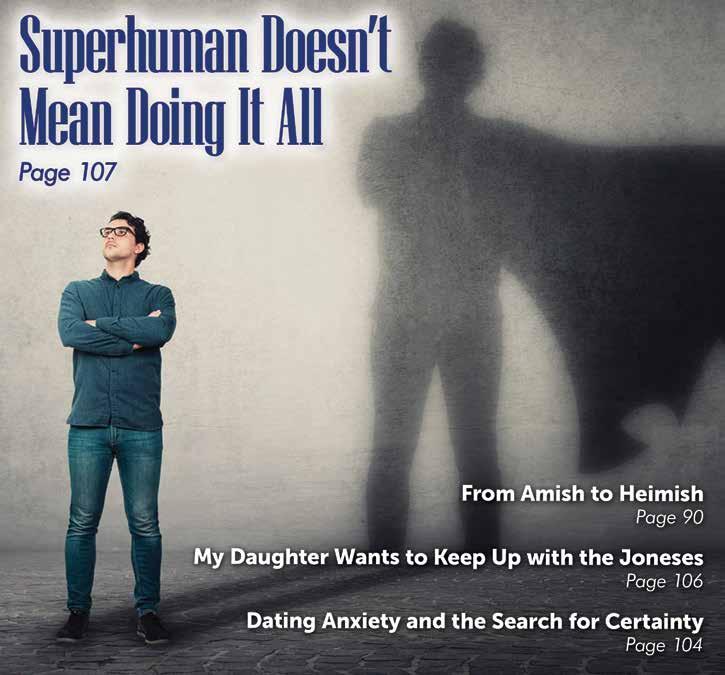
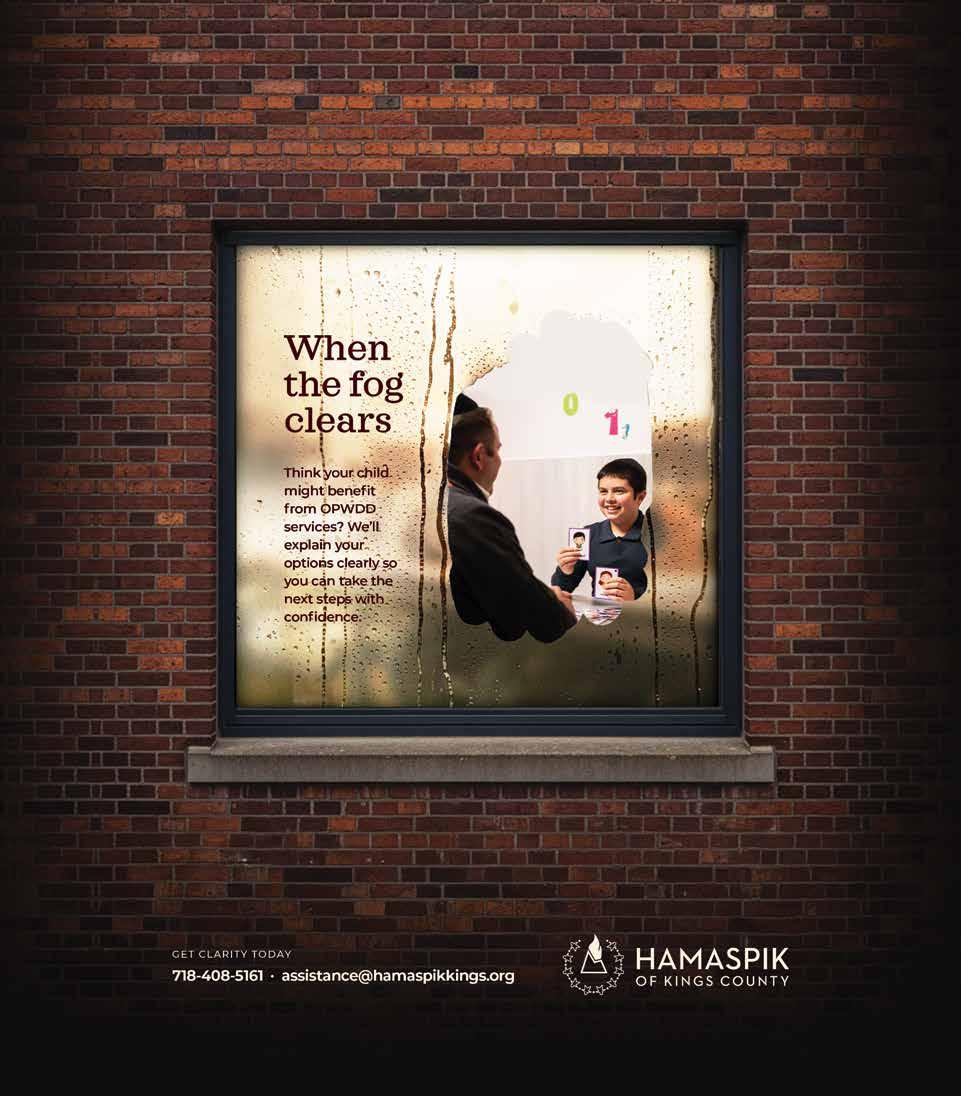

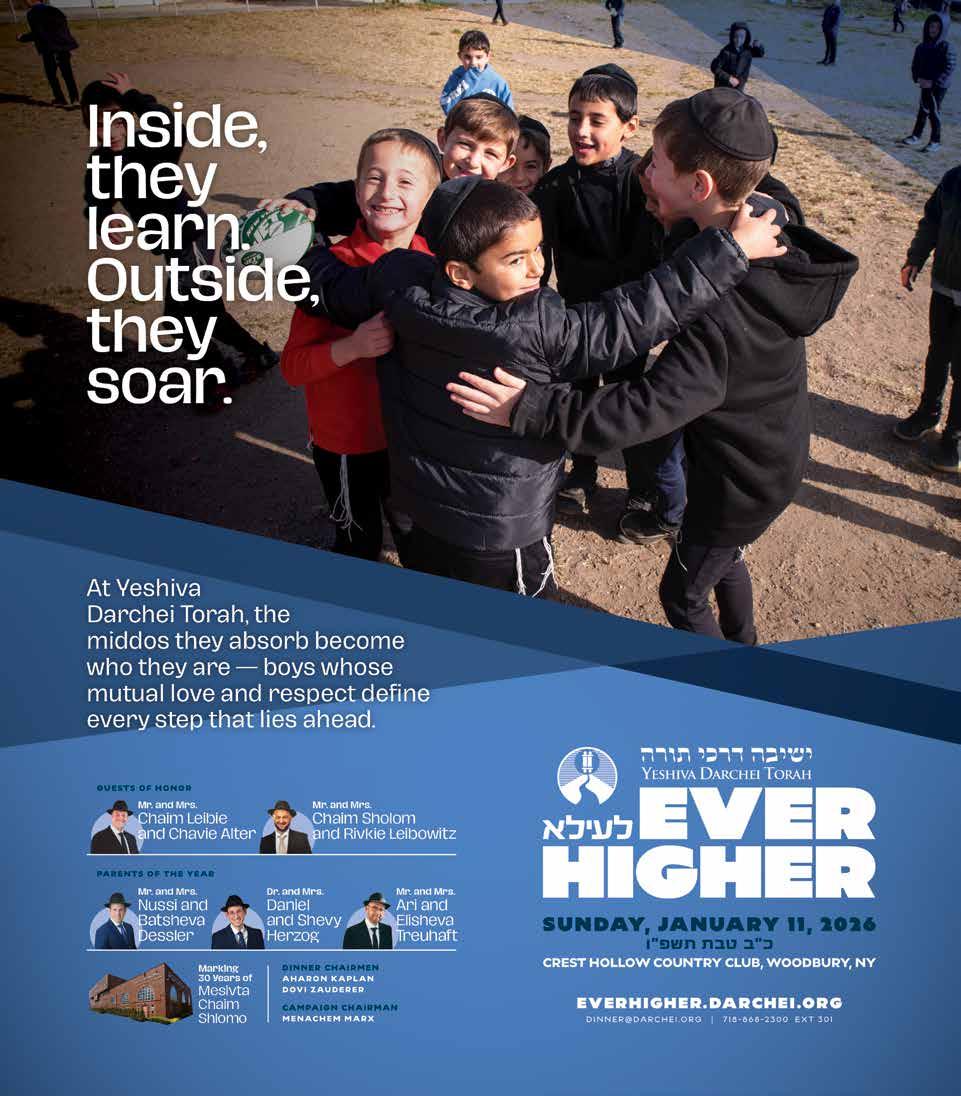





















My maternal grandfather passed away when I was in eighth grade, and many of my memories of him are vague. But I remember his smile, his joy when he saw us, how he always tried to speak with us in Yiddish, only to be reminded that we wouldn’t understand. He would get such nachas from seeing us, always complimenting us on our accomplishments. He loved to read and was always with a newspaper and a coffee. In fact, some of his favorite places to be were in a coffee shop with a fresh newspaper, reading it from cover to cover.
My grandfather loved knowledge and language – he loved learning and understanding new things. He would devour Yiddish, Hebrew, and English newspapers, each one giving him added insights and awareness.
Recently, I realized that he didn’t just read these newspapers; when an article would call to him, he would carefully cut it out and add it to a stack of other articles that he felt were important to hold onto.
A few months ago, a relative of mine handed me a small yellow bag inherited from my grandfather filled with newspaper clippings. The papers were yellowed were age, but some of the ideas promulgated within them were just as new as when they were first printed.
Isn’t it funny that old fears can become new fears? Or that yesterday’s news can become today’s news?
A headline in the January 27, 1993, front page of The New York Times stated: “Israel faces new U.N. pressure over deportations.” That story spoke of the United Nations trying to force Israel to readmit 400 deported Palestinians back into the Holy Land, with the PLO calling for sanctions against Israel. Just this week,
South Africa protested after a flight of 153 Palestinians from Gaza who had been paid to leave and was organized by Palestinians landed in the country. The Palestinian Authority quickly accused Israel of “human trafficking” and “ethnic cleansing.”
Three decades later and the headlines almost remain the same.
Understanding that those headlines written decades ago could have been printed today is, perhaps, a comforting thought. It reminds me that societal worries and concerns may ebb and flow, and yet the world still stands.
Looking through these papers, I feel like I am learning more about my grandfather –about what he felt was important enough to save, what interested him, how he was drawn to and fascinated by different subjects. But some of those papers are a bit of a mystery: which story spoke to him? On a page with a few different headlines, did he save it for the article for its information on heart health, Guiliani’s policing policies, or the one titled: “Our endangered species: fathers”? Perhaps it was for the Jo Amar ad or for the ad for the Meal Mart “Hot Kiddish for 50 Persons” for a mere $1.39 a person – cutlery included.
As I sift through these clippings, I am struck by how each fragile page feels like a conversation with him – a quiet window into the way he saw the world. These articles aren’t just fragments of history; they’re fragments of his curiosity, his worries, his hopes. In a world where news moves faster than ever and today’s headlines disappear within hours, there is something grounding about holding onto pieces he deemed worth preserving.
Wishing you a wonderful week, Shoshana

Yitzy Halpern, PUBLISHER publisher@fivetownsjewishhome.com
Yosef Feinerman, MANAGING EDITOR ads@fivetownsjewishhome.com
Shoshana Soroka, EDITOR editor@fivetownsjewishhome.com
Nate Davis
Editorial Assistant
Nechama Wein Copy Editor
Rachel Bergida
Shana Brecher
Lani White Design & Production
Gabe Solomon Distribution & Logistics
P.O. BOX 266
Lawrence, NY 11559
Phone | 516-734-0858
Fax | 516-734-0857
Classified Deadline: Monday 5:00PM classifieds@fivetownsjewishhome.com text 443-929-4003
PAYMENT VIA CREDIT CARD MUST BE SUBMITTED ALONG WITH CLASSIFIED ADS
The Jewish Home is an independent weekly magazine. Opinions expressed by writers are not necessarily the opinions of the publisher or editor. The Jewish Home is not responsible for typographical errors, or for the kashrus of any product or business advertised within. The Jewish Home contains words of Torah. Please treat accordingly.






















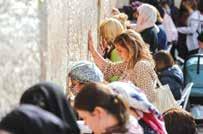

Dear Editor,
In my many years of reading dramatic family sagas, this is the first one that manages to combine shidduchim, covert surveillance, AirTags, Torah learning, charity, and mistaken identity, all in one slightly terrifying package.
It’s perfectly reasonable to be worried about a prospective son-in-law and to want to do your due diligence. But instead of, say, asking him a question like a human, your first instinct was to slip an AirTag into his coat like a Mossad trainee on her first undercover mission?
When the AirTag appeared to show the young man spending his days in a “non-Torah-learning location,” it raised eyebrows – mostly yours. But as it turns out, you’re a better stalker than spy: the bochur wasn’t wandering at all. The coat was. He had given it to a poor man who needed it more, while he himself was inside the beis midrash learning with the kind of diligence that would make the Vilna Gaon look like he needed to pick up the pace.
So, to recap:
He’s a tzaddik. Your daughter was confused but eventually recovered. And you…were enthusiastic. Extremely enthusiastic.
Technology, meanwhile, betrayed you in bold and creative ways. Your daughter eventually realized you were confusing “parental concern” with “felony stalking,” married the generous, studious young man anyway, and—well—then came the restraining order. You mentioned it with the same energy one uses to mention choosing centerpieces: “caterer, flowers, DJ, county-issued no-contact order— check!”
But there is a moral here for anyone tempted to use modern gadgets to play Torah Detective:
Give people the benefit of the doubt. You never know when “suspicious behavior” is actually kindness in disguise…or when the Torah scholar you’re tracking is simply learning in a different coat.
Also, please stop tagging people. AirTags are for keys, wallets, and occasionally luggage, not future sons-in-law.
Wishing your daughter and her new husband a long, peaceful, privacy-respecting marriage, and wishing you a very patient attorney.
Signed,
Dear Editor,
There is a common Jewish saying that kings’ and officers’ hearts are in Hashem’s hand. This is based on a pasuk in Mishlei (21:1), “Just like flowing water can easily be turned, so too, can Hashem turn a king’s heart.” There is a common misconception to think that this ensures that a king will be good. This is not necessarily so. The midrash says that Hashem tilts the king’s hearts based upon the zechusim of the people. If the people are good, then Hashem will tilt the king’s heart toward good. If the people are bad, then Hashem will tilt the king’s heart toward bad.
The truth is that our history is full of kings who were mean to us. From Pharaoh to Achashveirosh, from Nevuchadnetzar and Roman emperors, to Hitler and Stalin. There were plenty of other mean kings in between, including even some Jewish ones.
Some people apply the line to Mamdani ym”sh, thinking that this reassures us that he will be fine. That’s a misconception. To the contrary, the Gemara
Continued on page 14


says that if the Yidden don’t do teshuvah, then Hashem appoints over us a king as bad as Haman. (Sanhedrin 97b) Also, the Nevi’im warned that bad kings would hurt us. Also Mamdani is not a king, so the saying is presumably irrelevant.
There is, however, comfort from Reb Moshe Shternbuch, who reassures us that Mamdani won’t be as bad as he planned to be. Reb Moshe Shternbuch actually predicted terrible calamity in advance of Shemini Atzeres two years ago. Hopefully, his prediction this time is also accurate. As we daven the bracha in Shemoneh Esrei about tzaddikim, “Give good reward to all those who truly trust in You. We should also be with them and we should never be embarrassed, because we believe in You.”
Sincerely,
Rabbi Eli Reit Lakewood, NJ
Dear Editor,
I love reading your Dating Dialogue column each week, but this week, I am wondering if it is for real. Does a person really put an AirTag into a suitor’s coat to find out where he is going every day? I think the villain in this story is not the yeshiva bochur who is being shadowed. I think it’s the mom.
Dear girl, you mention that you are 23 years old and have been dating without much success. Is it possible that your home is not the warm, loving environment that you think it is? With a mother like this, it sounds like you are in a manipulative, suspicious predicament. Your mother “suspects” this boy is not in yeshiva all day. She slips a tracker into his coat. Does she track your movements to make sure you’re really teaching when you go to your job? Does she track where you’re going when you go out at night?
I believe that it may help your dating stats if you have a heart-to-heart with your mother and tell her to stop leading your life. You’re old enough to make decisions for yourself. Don’t allow her to con-
trol you with her suspicious and scary eye towards things. Stand up for yourself.
Sincerely, A. Gottesman
Dear Editor,
Why is this parsha called Toldos when many other parshiot discuss offspring as well? What distinguishes it to earn this name?
Before answering, recently, in commemoration of Rabbi Lord Jonathan Sacks zt”l’s yahrtzeit, someone rebroadcast an interview with him. Sacks was asked whether he ever experienced failure. He jovially responded that from age twenty to forty he failed in trying to publish a book. But from forty and on, he published one every year. A lot of life is about failure.
Considering the frailty of life, at the very least, we want to raise our kids with the best chance of success. Rabbi Samson Raphael Hirsch posits that, in this area, Yitzchak and Rivkah fell short. Though Eisav didn’t belong in the same “yeshiva” as Yaakov, he was still treated the same. Eisav’s potential wasn’t nurtured correctly, and he went astray.
Perhaps, this is why this parsha is called Toldos. The message is that if you want successful children, the greatest feat possible, then recognize their individual uniqueness and make sure to enthusiastically support them in that area.
Steven Genack
Dear Editor,
In last week’s issue you had an obituary of sorts about James Watson who shared the Novel prize for “discovering” DNA. In reality, it was a scientist named Rosalind Franklin who actually discovered the double helix through her research…which was basically stolen from her. She was never acknowledged for her work – partly because she was a woman and partly because she was Jewish. Anyone interested in her tragic life can Google her name to get the whole story. Dr. Ben Moscovitz







Britain’s Labour government has unveiled a series of changes to its asylum policies in an effort to placate citizens who are concerned with mass immigration.
The Home Office (interior ministry), headed by Shabana Mahmood, announced on Saturday that Britain would no longer be obligated to provide housing, allowances, and other forms of support to asylum seekers who are either criminals or can work but choose not to. Taxpayer funds would instead be directed to local communities and the economy.
Additionally, refugee status will “now be temporary, regularly reviewed and revoked” if it is determined that the home country is no longer dangerous, the Home Office said.
“Our system is particularly generous compared to other countries in Europe, where, after five years, you’re effectively automatically settled in this country. We will change that,” Mahmood said on Sunday in a statement to Sky News, adding that the government would review each refugee’s status every two-and-a-half years during “a much longer path to permanent settlement in this country of 20 years.”
For legal asylum seekers, the pathway to permanent settlement will be 10 years instead of five, the Home Office added.
According to the interior ministry, it hopes its new policy changes would “match and in some areas exceed” those in Denmark and other states in Europe, which have temporary refugee status, conditional support, and expectations of immigrants integrating into society.
The government said it intends for Britain to remain in the European Convention of Human Rights. However, the government has reinterpreted the ECHR’s Article 8 provision, which re-
lates to the right to a family life. Under that provision, many asylum seekers have come to Britain because they have family living there. However, as per Britain’s new interpretation of the provision, Article 8 will only count immediate family members as “family connections.”
According to polls, immigration is British voters’ number one concern, overtaking the economy. The Reform U.K. party, which campaigns on the immigration issue, has threatened to steal voters from the Labour Party. In an effort to stop the Reform Party’s rise, the Labour Party has recently adopted immigration as one of the issues it wishes to address.
Mahmood added that the government would consider implementing more “safe and legal” routes for asylum seekers. Pro-immigration organizations have slammed the policy changes.
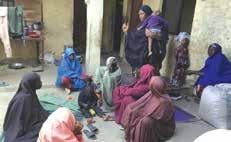
Twenty-five schoolgirls in Nigeria were kidnapped before dawn on Monday from their dormitory at the Government Girls Comprehensive Secondary School in Kebbi state’s Maga town. The gunmen had scaled the fence to enter the premises and exchanged gunfire with police before seizing the group of girls and killing a staff member.
On Monday, one girl managed to escape and made it home hours after the kidnapping. Another student was able to escape the gunmen in the minutes after the raid and was not abducted, principal Musa Rabi Magaji said.
“One is part of the 25 abducted (and) the other one returned earlier,” Magaji said. “They are safe and sound.”
For now, it is unclear what group is responsible for the kidnapping. Analysts and locals say it could be one of several gangs that often target schools, travelers and remote villagers in kidnappings for ransoms. Authorities have identified the gangs as mostly former herders who have taken up arms against farming communities after clashes between them over increasingly strained resources.
The Kebbi school is close to conflict

hot spots including Zamfara and Sokoto states, where several gangs are known to operate and hide out.
Authorities are actively searching the woods and nearby areas for the captured girls.
Amina Hassan, wife of the school vice principal Hassan Yakubu Makuku, said the terrorists broke into their house, which is on the school premises, and fatally shot her husband. He was also the school’s chief security officer.
“Three of them entered and asked my husband, ‘Are you Malam Hassan?’ and he responded, ‘Yes, I am.’ They told him that we are here to kill you,” she said.
Mass school kidnappings are common in northern Nigeria. At least 1,500 students have been seized in the years since Boko Haram jihadi extremists kidnapped 276 Chibok schoolgirls over a decade ago. Gangs often target schools to gain attention.
Chile’s presidential election on Sunday ended with no candidate winning over 50% of the vote. As such, the South
American country, on December 14, will hold a polarizing runoff election, which will pit a Communist former minister against a far-right lawyer.
José Antonio Kast, a far-right candidate who unsuccessfully ran for president twice, will face off against Jeannette Jara, a Communist Party member who served as labor minister in President Gabriel Boric’s left-wing government. In Sunday’s election, Kast secured around 24% of the vote, while Jara won 27%, which was less than expected.

Kast, a proud Catholic and father of nine, founded his Republican Party in 2019 and has campaigned against abortion, gang violence, illegal immigration, and other issues. He has pledged to build a giant border wall, oversee tens of thousands of deportations, and cut public spending by up to $6 billion in the first 18 months of his administration. Jara, on the other hand, has said she would boost

Chile’s social safety net and fight organized crime by addressing money laundering and drug trafficking.
In third place in Sunday’s election was Franco Parisi, a populist businessman and anti-establishment celebrity economist who surprised experts by winning 20% of the vote. Parisi said that he would, if elected, fight crime and plant land mines across Chile’s northern border to prevent crossings. Fourth place and 14% of the vote went to Johannes Kaiser, a libertarian congressman and former YouTuber whose policies have been described as more radical than Kast’s. Evelyn Matthei, a traditional center-right candidate, won fifth place, with 12.5%.
Kaiser said he and his libertarian party would support Kast to “ensure that a sound doctrine and defense of freedom are not abandoned.” Matthei also endorsed Kast. Following the election, Parisi did not explicitly say whether he would back Kast. Meanwhile, Jara has no challengers from her party, as the entire leftwing coalition backs her.

The German auction house Felzmann, on Monday, planned to auction off items recovered from Nazi concentration camps. However, the auction was canceled due to public backlash.
The auction was supposed to include over 600 items that belonged to concentration camp victims, including from Auschwitz and Buchenwald. According to reports, the items included a letter written by an Auschwitz prisoner and a Dachau prisoner’s medical diagnosis about forced sterilization.
The cancellation was announced on Sunday by Polish Deputy Prime Minister Radoslaw Sikorski, who praised Johann Wadephul, his German counterpart, for agreeing that “such a scandal must be prevented.”
Politicians and a group representing Holocaust survivors had objected to the auction, which was set to take place in Neuss.
“Respect for victims requires the dignity of silence, not the din of commerce,”
Sikorski wrote in a social media post.
“Documents or expert reports by Nazi perpetrators that were offered at the auction are not for private collections,” Wolfram Weimer, Germany’s state minister for culture, said in a statement, adding that future auctions of this sort must be prevented.
“For victims of Nazi persecution and Holocaust survivors, this auction is a cynical and shameless undertaking that leaves them outraged and speechless,” said Christoph Heubner, an executive vice-president of the International Auschwitz Committee (IAC), adding that the items “belong to the families of the victims.”
“They should be displayed in museums or memorial exhibitions and not degraded to mere commodities,” Heubner said.
Polish Culture Minister Marta Cienkowska said that the culture ministry would investigate whether the items belong in Poland.

Traces of asbestos were found in samples of widely-used play sand in Australia last week. Product recalls were issued on Saturday, affecting 69 schools in the Australian Capital Territory (ACT).
Inspections are underway and could “take days,” ACT Education Minister Yvette Berry said in a post on Facebook, adding that testing so far had come back “negative to airborne asbestos” from all schools. People who have been in contact with the sand do not require a clinical assessment, health officials say.
The Australian Competition & Consumer Commission (ACCC) said there was a low risk that the asbestos could become airborne or fine enough for inhalation.
The recall follows a similar sand scare last week, sparking fears the playground drama is far from over.
Several schools and preschools in the region were fully or partially closed on Friday after a warning over asbestos risks in children’s sand sold by Officeworks, before the further product recalls were issued.



“Unfortunately, these sand products are even more widely used in our schools than the Officeworks products,” said Berry, adding that State Emergency service volunteers and school staff spent their weekends walking through buildings and “mapping all colored sand they see.”
The government is “required to eliminate risk as much as reasonably practicable,” she continued.
Exposure to asbestos, once widely used in building materials, is known to cause lung cancer, mesothelioma and other cancers, and it is linked to more than 40,000 deaths in the U.S. each year.
Australian law prohibits the import or export of asbestos or goods containing asbestos. In 2024, the U.S. Environmental Protection Agency announced a comprehensive ban on the mineral.
This week, a Bangladesh court convicted ousted Prime Minister Sheikh Hasina of crimes against humanity. She had been on trial for ordering a deadly crackdown on a student-led uprising last year.
The ruling comes months ahead of parliamentary elections expected to be held in early February. The maximum punishment under the law that governs the tribunal is the death penalty. Hasina’s Awami League party has been barred from running in the elections, and it is feared that Monday’s verdict could stoke fresh unrest ahead of the vote.

The International Crimes Tribunal, Bangladesh’s domestic war crimes court located in the capital Dhaka, delivered the guilty verdict amid tight security. Hasina was not at the trial. She fled to India in August 2024.
The verdict can be appealed in the Supreme Court. Hasina’s son and adviser, Sajeeb Wazed, said before the verdict was given that they would not appeal unless a democratically elected government took office with the Awami League’s participation.
During the trial, prosecutors told the
court that they had uncovered evidence of Hasina’s direct command to use lethal force to suppress a student-led uprising in July and August 2024.
According to a United Nations report, around 1,400 people may have been killed during the protests between July 15 and August 5, 2024, with thousands more injured — most of them by gunfire from security forces — in what was the worst violence in Bangladesh since its 1971 war of independence.
Ahead of the verdict, Hasina dismissed the accusations and the fairness of the Tribunal proceedings, lamenting that a guilty verdict was “a foregone conclusion.”
Before the verdict was announced, the country was holding its breath. At least 30 crude bomb explosions and 26 vehicles were torched across the country over the past few days. There were no casualties in those incidents.
Anti-government protests erupted in Mexico City on Saturday, with thousands demonstrating against violent crime and President Claudia Sheinbaum’s government.
Sheinbaum said the marches, which also took place in other cities, had been funded by right-wing politicians who oppose her government.

At least 120 people – 100 of them police officers – were injured in the clashes in the capital.
The rally was organized by Gen Z youth groups, drawing support from citizens protesting against high-profile killings, including the assassination just weeks ago of Uruapan Mayor Carlos Manzo, who had called for tough action against cartels. He was killed on November 1 while attending a Day of the Dead festival.
Protesters waved banners displaying messages including “We are all Carlos Manzo,” while others wore cowboy hats in tribute to him. Manzo was known for speaking openly about drug-trafficking gangs in his town and cartel violence. He had been demanding tough action against armed cartel


members who terrorize the country.
Demonstrators dismantled parts of a barrier protecting the National Palace, where Sheinbaum lives. Police protecting the compound used tear gas on the crowds. Twenty people were arrested for crimes including robbery and assault.
Sheinbaum has been acting against cartels but resisting calls for another allout war on drugs. Previous attempts by her predecessors have ended with bloody results. She said, days before the protests, that these demonstrations were being promoted by bots online.
“We agree with freedom of expression and freedom of demonstration if there are young people who have demands, but the issue here is who is promoting the demonstration,” she said in a briefing. “People should know how this demonstration was organized so that no one is used.”
Sheinbaum has seen approval ratings above 70% in her first year in office and has made in-roads in clamping down on fentanyl-trafficking – a key issue for her U.S. counterpart, Donald Trump. Still, she is criticized for not halting the violence that grips the country.

Qian Zhimin, who created a fraudulent cryptocurrency exchange and stole money from around 120,000 Chinese people, was sentenced on Tuesday at Southwark Crown Court in London to 11 years and eight months for money laundering.
After the sentencing, Judge Sally-Ann Hales told Qian, 47, she was “the architect of this offending from its inception to its conclusion... Your motive was one of pure greed.”
Using a fake passport, Qian came to the United Kingdom in September 2017, fleeing a Chinese police investigation. From there, she moved into a mansion on the border of Hampstead Heath, paying her $22,700 a month rent by converting her Bitcoin stash into cash. She pretended to be a wealthy antique and diamond

heiress and employed a former takeaway worker as her personal assistant, who helped trade Bitcoin into cash and other assets, including property.
Qian launched an elaborate scheme in which she scammed thousands of Chinese citizens out of their money. She falsely claimed that her company, Lantian Gerui (Bluesky Greet), was developing high-tech health products and mining Bitcoin. In reality, she had started a pyramid scheme. Qian paid long-time investors with new investors’ money, while using much of the embezzled money to fund her lavish lifestyle. In total, victims gave Qian’s fraudulent company $5.6 billion, according to findings by the U.K.’s Crown Prosecution Service (CPS).
Qian particularly targeted middle-aged and elderly Chinese people, portraying her company as patriotic and charitable.
According to Wen Jian, Qian’s assistant who was sentenced to six years in prison, Qian spent most of her time lying in bed, shopping online, and playing video games. However, she also kept a diary, where she detailed her many ambitions, including founding an international bank, purchasing a Swedish castle, and becoming the queen of Liberland, an unrecognized microstate on the Croatian-Serbian border.
Qian ordered Wen to look for houses she could purchase in London. After she tried buying a very big house in Totteridge Common, police began investigating Qian, as Wen failed to explain her employer’s wealth. From there, officials raided the mansion Qian had been renting, and found hard drives and laptops containing tens of thousands of Bitcoin, in what is believed to be the single largest cryptocurrency seizure in the history of the U.K.
She was arrested last April in York. Initially, she denied all charges. However, she wound up pleading guilty to having stolen the seized cryptocurrency at her trial in September.
Qian originally founded her company in China. In mid-2017, Chinese police launched an investigation into her company, and she fled to London.
Authorities have yet to specify how the recovered funds will be returned to victims of the scam.
On Sunday, a rail line in Poland was blown up in “an unprecedented act of sabotage,” according to Polish Prime Minis-
ter Donald Tusk. He vowed to “catch the perpetrators.”
The affected line links the capital, Warsaw, to the eastern city of Lublin and continues onward to Ukraine. It has been used to deliver aid to Ukraine. Without specifically accusing Russia, Tusk connected the apparent attack to the war in Ukraine.

“Blowing up the rail track on the Warsaw-Lublin route is an unprecedented act of sabotage targeting directly the security of the Polish state and its civilians,” Tusk wrote Monday on X. “This route is also crucially important for delivering aid to Ukraine. We will catch the perpetrators, whoever they are.”
Tomasz Siemoniak, Poland’s security services minister, said that there was a “very high” chance the sabotage had been carried out on the orders of a foreign intelligence service. Siemoniak did not name a specific country.
A train driver spotted damage to the line, and no casualties were reported, according to Polish officials.
Polish Defense Minister Wladyslaw Kosiniak-Kamysz wrote on X that the Polish military will inspect a roughly 120-kilometer section of the rail line running to the Ukrainian border.
Last month, Poland detained eight people who Tusk said were “preparing acts of sabotage” in Eastern Europe. Polish officials have accused Russia of targeting Poland in a “hybrid war” that includes arson and cyberattacks. Russia has denied the allegations.
In September, a Ukrainian man suspected of a role in the 2022 sabotage of the Nord Stream gas pipelines was arrested in Poland — a month after another Ukrainian suspected in the case was arrested in Italy.
This week, rescue workers dug through tons of mud and rubble as they searched for 34 missing people after two separate landslides in two different regions on Indonesia’s main island of Java killed at least 18 people.

The landslides were triggered by torrential rains on Thursday evening in which dozens of houses in three villages were covered by mud and death. Sixteen people were killed in the Cilacap district of Central Java province.
More than 500 rescue personnel, including police and soldiers, supported by 22 excavators and 18 sniffer dogs, have been deployed in five devastated areas in Cilacap to search for seven villagers reportedly still missing.

A similar landslide had struck Central Java’s Banjarnegara district just before dusk on Saturday when tons of mud plunged down the surrounding hills and buried at least 30 houses, prompting more than 800 residents to flee to safety, some of them to even higher ground prone to further landslides. At least two people’s bodies were found. Twenty-seven others were reported missing.
Seasonal downpours cause frequent landslides and floods in Indonesia, a chain of 17,000 islands where millions of people live in mountainous areas or in fertile flood plains.

A bridge collapsed in a cobalt mine in the Democratic Republic of Congo on Saturday, which led to the deaths of at least 32 people. Now, rescuers are searching for any survivors.
Unauthorized miners forced their way into the southern Kalando mine on Saturday despite being banned from the site, according to local official Roy Kaumba Mayonde. Military personnel guarding the site then reportedly fired guns, causing the bridge to collapse after panicked miners rushed across it, according to gov-
ernment mining agency SAEMAPE.
Accidents in mines are not uncommon in DR Congo. Around 1.5 to 2 million people work in the unregulated artisanal mining industry, which feeds the global demand for copper, cobalt and other minerals.
Two of the miners injured at Kalando mine, located in the village of Mulondo, sustained bullet wounds
Mayonde called the collapse at the mine “tragic,” adding that mining companies in DR Congo were “frequently victims of this type of invasion of their concessions by illegal miners.”
The miners had erected the bridge themselves, and the unstable structure was unable to sustain a large number of people making a “hasty” crossing, Mayonde said.
DR Congo is the world’s largest supplier of cobalt, which is used in the defense and aerospace industries as well as being essential for batteries in electric vehicles.
To ensure the investigation isn’t politically motivated, the court has allowed Levin to select an official who is not a part of prosecution agencies, has no political affiliation, and has strong law enforcement credentials.
The case concerns the leaking of footage that allegedly shows Israeli soldiers mistreating Palestinian prisoners at the Sde Teiman military facility in July 2024.
Last month, Yifat Tomer-Yerushalmi, a former military advocate general, confessed to having authorized the leak. Many have pointed out that the video does not show any specific abuse and say that the film and allegations were fabricated. An initial probe overseen by Attorney General Gali Baharav-Miara and the State Attorney’s Office recommended closing the case without a criminal investigation. Levin’s lawyers used that apparent conflict of interest to defend his decision to appoint Kula, who also had a conflict of interest given his role.
Meanwhile, liberal government watchdog groups petitioned the court to reject Kula’s appointment.

Justice Minister Yariv Levin’s decision to appoint Asher Kula, the State Ombudsman for Judges, to investigate the Sde Teiman video leak was overruled Sunday by the High Court of Justice. The court, however, has said it would allow Levin to select another official to investigate the incident.
The court banned Kula from investigating the case, since the law does not permit the ombudsman for judges to serve or act in any other capacity. Despite that, the ruling was still somewhat in Levin’s favor, as the court permitted him to appoint a different official. Normally, the justice minister would not be allowed to do so, but the court decided to deviate from the precedent given the case’s “irregular and extreme circumstances.”
ara might be allowed to get involved in the case once her conflict of interest in the case is resolved.

New York City Mayor Eric Adams met with Israeli officials, including the Jewish state’s president and prime minister, during a trip to Israel this week.
In response to the court’s decision, Likud MK Avichai Buaron, who has previously urged the court to bar Baharav-Miara from playing a role in the investigation, said the ruling was “a great victory for everyone for whom the truth and justice are important” and that it affirmed his belief that the justice minister is the only official qualified to appoint the person who oversees this particular investigation.
The Israel Democracy Guard, which was among the groups that petitioned the court against Kula’s appointment, said it would scrutinize the next official Levin selects.
In her opinion, Justice Yael Willner took note of Baharav-Miara’s involvement in the original investigation and added that several senior officials who were involved in the initial probe might have to give testimony and, as such, would not be able to supervise or play a role in the investigation.
Willner noted “the principle of the independence of the criminal prosecution service has an elevated status in our legal system, and therefore the rule is that there is no room for any political entity to interfere in criminal investigations.”
However, the case’s “irregular and extreme circumstances” justified a “demarcated and limited departure” from the precedent, she wrote, adding that Levin’s role in the investigation would be limited to re-delegating authority from the attorney general to a different public official who is both qualified and independent.
The ruling suggests that Baharav-Mi-
At the Kirya military headquarters in Tel Aviv, Adams met with Prime Minister Benjamin Netanyahu. During the meeting, Netanyahu thanked Adams “for his great support for Israel and on being a true friend of the Jewish people,” according to the Prime Minister’s Office.
President Isaac Herzog and Adams met in Jerusalem at the President’s Residence.
“You are a dear, dear friend of Israel and the Jewish people,” Herzog told Adams, remembering the mayor’s “historic visit” to Israel following the October 7 massacre.
“As you know, we are worried about how things will look post the mayoral elections in New York,” Herzog added, thanking Adams for his opposition to anti-Israel Mayor-elect Zohran Mamdani’s campaign.
Regarding the recent election, Adams said, “We want to clearly send the right message that 49 percent of New Yorkers made it clear that they don’t embrace the philosophy of anti-Israel. We still consider Israel as an ally and as a friend.”
“We’re not going to deny the fact that there’s an increase in antisemitism across the globe, and some of the words that are coming from New York is something that we’re not going to deny. And I think right now, we need clarity…and I’m going to provide that clarity to fight against hate wherever it shows its face,” said Adams, whose term finishes at the end of 2025.
In Jerusalem, Adams also met with Foreign Minister Gideon Sa’ar, who called the mayor “a true friend of Israel.”
“Mayor Adams stands, and has stood, unequivocally by Israel throughout the years,” Sa’ar posted on X. “He has always expressed a clear, moral voice against


antisemitism of all kinds and in favor of Israel’s right to defend itself.”
At a reception hosted in his honor on Sunday by the Combat Antisemitism Movement in Tel Aviv, Adams reportedly vowed to continue supporting Israel and said he would be concerned if he were a Jewish New Yorker.
“If I were a Jewish New Yorker, I’d be concerned about my children,” Adams said, adding that “the community must prepare itself” because “everything is not fine.”
“As I finish, I wanted to come back here to Israel and let you know that I served you as the mayor, but I want to continue to have the title that’s more important to me than anything: I’m your brother.” Adams remarked during a Sunday visit to the Western Wall.
On January 1, Adams will be succeeded by Zohran Mamdani, who won the mayoral election after defeating independent Andrew Cuomo, the former New York governor.
weapon sales will be contingent on the maintenance of the ceasefire between Israel and Hamas.
“The government will, as a general rule, revert to case-by-case reviews in decisions on arms exports and respond to further developments,” Sebastian Hille said in the announcement.
The ceasefire “is the basis for this decision, and we expect everyone to abide by the agreements that have been made,” he said, adding that it “includes maintaining the ceasefire. It also means that humanitarian aid is provided on a large scale and that the process continues in an orderly manner, as agreed.”
According to Hille, the decision will take effect on November 24.
Foreign Minister Gideon Sa’ar celebrated the decision in a post on X, urging other countries to take similar measures: “I welcome Chancellor Merz’s move to revoke the decision regarding the partial ’embargo.’ I call on other governments to adopt similar decisions, following Germany.”

Berlin suspended some arms trade with Israel in August over the Israeli cabinet’s decision to take over Gaza City in its war against Hamas in Gaza.
Germany is the second-largest arms exporter to Israel, after the United States, and is Israel’s main backer in the EU. Germany provided 30 percent of Israel’s major arms imports in 2019-2023, primarily naval equipment, including Sa’ar 6-class frigates (MEKO A-100 Light Frigates), which have been used in the Gaza war.
At the time, Merz said, “The German government will not approve any exports of military equipment that could be used in the Gaza Strip until further notice.”
Germany will lift an order suspending some weapons sales to Israel beginning next week, according to a German government spokesperson.
The decision to continue with the
He argued that the decision to move on Gaza City “makes it increasingly difficult” to see how the goals of reaching a hostage deal and disarming Hamas would be achieved.
After the decision to halt weapon sales in August, Prime Minister Benjamin Netanyahu said Germany was “rewarding Hamas terrorism.”
Now, ahead of Germany’s announcement to resume arms trade, Merz and Netanyahu spoke on the phone Sunday about “diplomatic and regional matters,”

34 in what the premier’s office described as a “good and friendly conversation.”
Other countries that have suspended arms trade or implemented embargoes on Israel during the war in Gaza include Spain, which enshrined a “total embargo” in law last month, as well as more limited moves from Italy, Canada and the Netherlands and Belgium. The UK also decided last year to suspend dozens of arms export licenses with Israel, though it insisted the move was not an embargo.
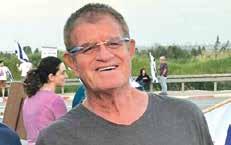
On Monday, hundreds of people gathered to pay their respects to Meny Godard, who was killed in the October 7 massacre and was finally brought back to Israel for burial.
Godard, 73, was murdered by Palestinian Islamic Jihad terrorists in Kibbutz Be’eri on October 7 along with his wife, Ayelet, 63. He was buried at the cemetery in the kibbutz.
Godard’s family said in a statement ahead of the funeral that he “loved this land, its songs and its people.”
“We stand here today and say goodbye to you. But in fact, the farewell words are dedicated to the memory — to you and Ayelet, the love of your life,” President Isaac Herzog said in his eulogy at the funeral on Monday.
“I stand here today as the president of Israel, and I know that to ask for your forgiveness is not enough. As president of the State of Israel, I am sorry that we weren’t here to protect you. I’m sorry that it took over two years to return dear Meny to his homeland,” Herzog said, and asserted the need to investigate the October 7, 2023, massacre.
“When we look around at the gravestones of all of the [kibbutz] members buried in the Be’eri cemetery, we can see that on October 7, Hamas terrorists murdered the best of humanity!” Herzog posted on X afterward.
The Godards had four children, Mor, Gal, Bar, and Goni, and seven grandchildren.
More than 100 people were killed in Be’eri on October 7. The kibbutz held a funeral for Meny and Ayelet after their murder was announced in February 2024. At the time, the kibbutz said that Meny had “a love of sports, the ocean and people.” He was a professional soccer player in the 1970s before enlisting in the army and fighting in the Yom Kippur War. In the kibbutz, he worked in a variety of positions, including in the printing house and the local store, as chief economist, and as a lifeguard.
The Hamas terror group is still holding the remains of three captives. As part of the ceasefire deal, Israel has returned the remains of 15 Palestinians for each deceased Israeli hostage it receives.
On Monday, the UN Security Council voted to adopt a U.S.-sponsored resolution authorizing the establishment of an International Stabilization Force (ISF) that will help secure the Gaza Strip, in line with U.S. President Donald Trump’s 20-point plan for ending the war in the area.
The U.S. ceasefire agreement was inked on October 9. But the truce is under strain, as Israel has pledged to continue fighting if Hamas does not disarm. The U.S. has said that Hamas leaders pledged to disarm before the deal was signed and has worked in recent weeks to negotiate the decommissioning of its weapons with limited success, Trump’s 20-point plan also indicates that the ISF will take part in the demilitarization of Gaza.

Countries interested in contributing troops to the foreign force needed an international mandate backed by the UN in order to move forward. For weeks, the U.S. has worked on gathering a coalition, holding talks with Security Council members as well as key Arab and Muslim allies that were also consulted in the formation of the original 20-point plan. Both Russia and China abstained from the vote.
U.S. Ambassador to the UN Mike



Waltz told the Security Council before Monday’s vote that the resolution authorizes “a strong coalition of peacekeepers — many from Muslim-majority nations like Indonesia, Azerbaijan, and others — to deploy under a unified command.”
The resolution states that the ISF will help secure Gaza’s borders, protect civilians, secure humanitarian aid, train Palestinian police and — most critically to Israel — “ensure the process of demilitarizing” the Strip.
The resolution also “welcomes the establishment of the Board of Peace,” which will be chaired by Trump and tasked with overseeing the redevelopment of Gaza and the establishment of a technocratic Palestinian government that will be tasked with administering daily services in the Strip.
Neither the Board of Peace nor the Palestinian technocratic government have been staffed yet, but the 20-point plan states that the board will include
which we recognize as the aspiration of the Palestinian people.” This statement has angered many in Israel, who see this as a pathway for Palestinians to have their own state.
The final point reads, “The United States will establish a dialogue between Israel and the Palestinians to agree on a political horizon for peaceful and prosperous co-existence.”
The PA welcomed the resolution’s passing, stressing that it’s willing to work with the international community to implement it “in a way that ends the suffering of our Palestinian people in the Gaza Strip, the West Bank, and East Jerusalem, and advances the political path leading to peace, security, and stability between Palestinians and Israelis, based on the two-state solution.”
Hamas, however, blasted the resolution, asserting that “it fails to meet Palestinians’ rights and demands and seeks to impose an international trusteeship on the enclave that Palestinians and resistance factions oppose.”
“Assigning the international force with tasks and roles inside the Gaza Strip, including disarming the resistance, strips it of its neutrality, and turns it into a party to the conflict in favor of the occupation [Israel],” the terror group stated, while claiming that “resisting occupation by all means is a legitimate right.”
Shortly after the resolution passed, Trump published a post on Truth Social “congratulating the world,” and saying that the Board of Peace that he will chair will include “the most powerful and respected leaders throughout the world.”

former UK prime minister Tony Blair, and the U.S. has been considering various names for both panels over the past several months, according to Arab diplomats. The Board of Peace and the ISF will operate in Gaza until the end of 2027.
Point 19 states, “While Gaza re-development advances and when the Palestinian Authority reform program is faithfully carried out, the conditions may finally be in place for a credible pathway to Palestinian self-determination and statehood,
On Tuesday, a man died when he was stabbed to death in a terror attack at the Gush Etzion Junction. Three other people were wounded in the attack that was carried out by two Palestinians.
The terrorists accelerated their vehicle into people at the junction. Then, one terrorist got out of the car and stabbed several victims.
Both terrorists were shot dead by security forces at the scene, the IDF and

first responders said. They were later identified by Palestinian officials as Imran al-Atrash and Walid Sabarneh, both 18 years old. They had set out on their murderous spree from Hevron. One was living in Hevron; the other lived in Beit Ummar.
In the aftermath of the attack, several explosive devices were discovered in the vehicle and disarmed.
Three people were transported from the scene to hospitals in Jerusalem, the Magen David Adom ambulance service said, including a woman in her fifties in serious condition, along with a 30-yearold man and a 15-year-old boy in moderate condition. The 55-year-old woman was mistakenly hit by the Israeli troops’ gunfire during the melee.
In response to the deadly attack, Yisrael Beytenu chair Avigdor Liberman blamed the terrorism on the government’s “feebleness and submissiveness.”
“When terrorism smells weakness, it raises its head and goes out to kill,” he said in a statement. “Terror attacks are not a decree of fate, but a struggle that requires determination, strength and independence, everything that this government of negligence does not have.”
The Yesha umbrella council for West Bank settlements said that the attack was
connected to the U.S.-sponsored resolution passed by the UN Security Council the day before, which authorized the establishment of an international force to secure the Gaza Strip and indicated a path to Palestinian statehood.
“When Israel quietly enables a path to a Palestinian state, terrorism again raises its head,” the Yesha Council said. “We said all along, it is either [Israeli] sovereignty [via annexation] or a Palestinian state [in the West Bank]. The Israeli government is refraining from sovereignty, and we are getting a tailwind in the sails of a terrorist state in the heart of the country.”
Former prime minister Naftali Bennett, who is mounting a bid for the premiership in the next elections, also blamed the government for the terror attack.
“Oslo on steroids,” he declared in a statement that appeared to refer to Netanyahu’s support of Monday’s UN Security Council vote to adopt the U.S.-sponsored resolution on Gaza.
“A government that, after the most horrific massacre in the country’s history, awards the enemy the prize of a Palestinian state bears responsibility for reigniting terrorism against Jews. We will fix it soon,” he vowed.
The Oslo peace accords in the 1990s created the Palestinian Authority to ad-

minister parts of the West Bank and Gaza, although the PA was later ousted from Gaza by Hamas in 2007.

On Wednesday, November 12, at a special event in Philadelphia, the U.S. Mint pressed its final 1-cent coins. President Donald Trump had announced plans to scrap the penny back in February.
The United States may soon begin to feel the effects of Trump’s decision to stop penny production. With some stores facing penny shortages, many businesses have begun rounding prices to the nearest five cents; some round down, while others round up.
“Some businesses are asking cash-paying customers to voluntarily round up for donations to avoid needing pennies to make change and to stay compliant with state and local laws, while other places are rounding down for everyone (not just cash payers),” noted Brandon Sheridan, associate professor of economics at Elon University, adding that rounding down will “become costly for businesses over time.”
At least 10 states have laws banning rounding transactions to the nearest five cents. As such, new legislation will be required for all businesses to adapt.
The U.S. Mint will no longer make pennies. However, “pennies will remain legal tender,” noted Bill Maurer, dean of the School of Social Sciences at the University of California, Irvine, and director of UCI’s Institute for Money, Technology and Financial Inclusion. Additionally, pennies will continue to circulate, albeit more slowly, since there are around 250 billion in circulation, according to the American Banking Association.
“As those coin terminals close to pennies, the circulation of pennies is slowing down,” Maurer added.
Trump ordered the Treasury Department to stop minting pennies, as one
penny costs 3.69 cents to make, costing Fiscal Year 2023 taxpayers over $179 million. Nickel production may also stop eventually, as one nickel costs over 13 cents to make, according to the U.S. Mint. Experts, however, believe that the nickel is here to stay.
“The cost to consumers of rounding transactions to the nearest nickel is estimated to be around $6 million, the cost to round to the nearest dime is closer to $56 million,” Sheridan said. “Therefore, the cost-benefit analysis for taxpayers is not nearly as clear for nickels as pennies.”
Before Trump, others have tried ending penny production, including U.S. Representatives Jim Kolbe of Arizona and James Hayes of Louisiana, who unsuccessfully co-sponsored The Price Rounding Act of 1989, and Sens. John McCain and Mike Enzi, who proposed the Currency Optimization Innovation and National Savings (COINS) Act in 2017, which would’ve stopped penny production for 10 years.
The U.S. began minting pennies in 1792. Originally, each penny had a picture of a woman representing liberty. That image was, in 1909, replaced by President Abraham Lincoln in celebration of his 100th birthday. Lincoln was the first president to appear on U.S. coins.
The shortage is unlikely to make pennies significantly more valuable.

A new study has found that bumblebees are, to a certain extent, able to process time, an ability which has yet to be found in any other insect.
The study was led by doctoral student Alex Davidson and his supervisor Elisabetta Versace, a senior psychology lecturer at Queen Mary University of London. According to Versace, the study demonstrates that insects are capable of processing complex patterns.
The research team conducted the study by constructing a maze where the bees would hunt for food. The bees were then presented with circles that lit up with a short flash of light — which lasted 0.5 seconds — and one that lit up with a


long flash, which lasted five seconds. By approaching the short flash of light, the bees would receive sweet food, while approaching the long flash of light would yield bitter food.
The lit-up circles were placed in different areas of the maze. Consistently, the bees chose the short flash of light, which they associated with sweet food. To preclude the possibility that the bees could see or smell the sweet food, the researchers also tested the bees in a maze without
food. The research found that the bees were able to tell the temporal difference between long and short flashes of light.
Very few animals are able to tell the difference between short and long flashes of this sort.
The team now hopes to research the neural mechanisms that allow bees to process time.
widely believed that he killed them.
After a civil jury found Simpson financially liable for his ex-wife and Goldman’s deaths, Goldman’s father, Fred, filed a creditor claim in July 2024. At the time, Fred Goldman sought more than $117 million in damages. However, Simpson did not finish paying for the damages, as he passed away from cancer last year.

Last Friday, O.J. Simpson’s estate agreed to pay Fred Goldman almost $58 million. Malcolm LaVergne, the Simpson estate executor, said in court documents filed in a Clark County, Nevada, district court that the estate would pay the victim’s father but that the original amount did “not appear to be as accurate as possible based on simple judgment interest calculations.”
Fred Goldman’s lawyer, Michaelle Rafferty, called LaVergne’s acceptance of the claim a “positive acknowledgment of the debt.”
“It does not constitute payment. This acceptance allows the administration of the claim to move forward in probate. We will continue to monitor the probate process as it progresses,” Rafferty stated.

In June 1994, O.J. Simpson’s ex-wife, Nicole Brown Simpson, and her friend Ron Goldman were murdered during a stabbing attack outside her home in Los Angeles. After being criminally charged with their murders, Simpson was surprisingly acquitted in 1995, even though it is
California officials announced Wednesday that the state would revoke 17,000 commercial driver’s licenses belonging to immigrants whose legal status in the U.S. ended before their licenses’ expiration. The licenses were valid when issued, but the licenses have since expired, since the immigrants are no longer entitled to legally stay in the United States.
The move comes following backlash from the Trump administration, which heavily criticized California and other states for giving licenses to illegal immigrants. In August, a tractor-trailer driven

by an unauthorized driver killed three people in Florida after making an illegal U-turn. The incident brought the issue into the spotlight. In October, an illegal immigrant truck driver killed three people in California, while others were killed in similar crashes in Texas and Alabama earlier in 2025.
“After weeks of claiming they did nothing wrong, [California Governor] Gavin Newsom and California have been caught red-handed. Now that we’ve exposed their lies, 17,000 illegally issued trucking licenses are being revoked,” said Transportation Secretary Sean Duffy. “This is just the tip of iceberg. My team will continue to force California to prove they have removed every illegal immigrant from behind the wheel of semitrucks and school buses.”
According to Newsom’s office, all 17,000 licenses were granted to people who, at the time, were authorized by the federal government to work in the U.S. The governor’s office later confirmed that the licenses were revoked due to a state law that ensures that licenses expire on or before the individual’s legal status expires.
Duffy, on Wednesday, threatened to withhold $160 million from California unless state officials address the illegal licenses issue. The secretary has already
taken $40 million in federal funding from California for failing to enforce English language requirements for truck drivers.

Health officials on Monday linked for the first time the measles outbreak that began in Texas with another in Utah and Arizona, a finding that could end the United States’ status as a nation that has eliminated measles.
The news came in a phone call, a recording of which was obtained by The New York Times, among officials from the Centers for Disease Control and Prevention and state health departments.
The chain of transmission began in January, in a conservative Mennonite group on the western edge of Texas, and spread to Oklahoma and New Mexico.

Countries lose their elimination status after 12 months of sustained transmission. If the outbreak cannot be extinguished by January, the anniversary of the first cases in Texas, the United States will lose what is known as “elimination status” as determined by the World Health Organization, which it has had for 25 years.
“I wouldn’t call the code yet, but I think the patient’s not looking real good,” said Michael Osterholm, director of the Center for Infectious Disease Research and Policy at the University of Minnesota.
Canada lost its status last week, ending a 27-year run, after failing to control an outbreak that began at a Mennonite gathering in October 2024.
Losing elimination status may not lead to tangible changes, such as travel restrictions. But experts have called the possibility “deeply embarrassing” for a wealthy country with the medical resources of the United States.
“CDC and state and local health agencies continue to work together to assess transmission patterns and ensure an effective public health response — which is what led to the Texas outbreak being declared over,” Andrew Nixon, a representative from the Department of Health and Human Services, wrote in a statement.
This month, the CDC presented its outbreak information to the Pan American Health Organization. As of Nov. 13, the CDC had confirmed 1,723 measles cases nationwide, 87% of which were associated with a record 45 outbreaks this year. By contrast, 16 outbreaks were reported in 2024.
About 92% of the reported cases this year are among people who are either unvaccinated or of unknown vaccination status.
Another large outbreak in two schools in South Carolina is close to being contained. Rockland County, New York, has four reported cases, the first since a massive outbreak in 2018 that lasted 10 months. That outbreak raced through Orthodox Jewish communities, some of which had vaccination rates below 70%.
(© The New York Times)
David Richardson, the acting administrator of the Federal Emergency Management Agency, resigned on Monday after roughly six months leading the agency.
In a statement on Monday, FEMA and the Department of Homeland Security, which oversees the agency, expressed “sincere appreciation” to Richardson “for
his dedicated service.” FEMA’s current chief of staff, Karen Evans, will step into the acting administrator position beginning Dec. 1.

Richardson said he agreed to be acting director during a challenging time. He said he was leaving because he wanted to return to private industry.
“I agreed to be the acting administrator through hurricane season when others wouldn’t,” Richardson said. “Hurricane season ends on 1 December. Since the danger has largely passed, I can now leave for other opportunities.”
During his time as FEMA chief, Richardson was heavily criticized for his slow response to the catastrophic July floods that devastated Texas’ Hill Country. Richardson could not be reached for 24 hours after raging floodwaters killed more than 130 people on July 4, including 27 girls and counselors at Camp Mystic, a Christian youth summer camp. It was later revealed that he had been on vacation during that time.
A former Marine Corps officer, Richardson was selected to lead FEMA on a temporary basis in May, when the prior acting administrator, Cameron Hamilton, was pushed out after just a few months in the role. Throughout his FEMA tenure, Richardson simultaneously held another position in the Trump administration, as assistant secretary of the DHS’s Countering Weapons of Mass Destruction Office.
FEMA has faced scrutiny this year over its ability to respond effectively and efficiently to hurricanes, floods and other disasters.
Rafael Lemaitre, a former director of public affairs at FEMA, was not a fan of Richardson. Lemaitre serves on the advisory council for Sabotaging Our Safety, an advocacy group that focuses on disaster preparedness and emergency response issues.
“Appointing someone with zero disaster management experience to lead FEMA is like putting someone who’s never flown a plane in the cockpit during a hurricane,” he said in a statement.
Democratic members of the House Homeland Security Committee also welcomed Richardson’s departure.
“David Richardson was incompetent, inexperienced and had no business running FEMA,” the group wrote on X. “He’ll be remembered for vanishing when the




families of Texas needed him most. Good riddance.”

Vegemite, the salty spread that has some wanting more and some wishing it would just go away, has become a symbol for those living Down Under. Now, a convicted murderer serving a life sentence in Australia is challenging a ban on prisoners consuming the condiment.
State authorities have banned Vegemite because inmates may use the strong-smelling condiment to disguise contraband substances or brew alcohol behind bars.
But Andre McKechnie argues that the ban, in place in the state of Victoria since 2006, denies him the right to “enjoy his culture as an Australian,” according to court documents.
McKechnie was handed a life sentence for stabbing to death a property developer in Queensland in the 1990s. He served part of his sentence in Queensland before being transferred to Victoria.
In his suit against Victoria’s Department of Justice and Corrections Victoria, the agency managing the state’s prisons, the 54-year-old said he wants the Vegemite ban overturned and for authorities to declare that they “failed to provide food adequate to maintain [his] well-being.”
The case is scheduled for trial next year, AP reported.
A much-loved breakfast spread for some, Vegemite has acquired controversial accolades since it first hit grocery shelves in Australia in 1923. The thick, brown condiment, made primarily from yeast extract, was invented in the Victorian capital of Melbourne more than a century ago as an alternative to the British spread Marmite.
In 2022, Melbourne declared the smell of Vegemite wafting from a factory in the city a “significant” aspect of the city’s cultural heritage. At the same time, however, the condiment’s polarizing taste
has landed it in the Disgusting Food Museum in Sweden – alongside natto, stinky tofu, and monkey brains.
Vegemite sparked an international dispute in April this year, when an Australian cafe owner in Canada was told to remove jars of the condiment from his shelves as it did not comply with local health regulations.
Australian Prime Minister Anthony Albanese intervened in the row, saying it was “rather odd” that Canada allowed the sale of Vegemite’s “rubbish” rival product Marmite. Soon after, the Canadian agency changed course and allowed the cafe owner to continue selling the spread.
Well, it’s a matter of taste – and perhaps your taste doesn’t matter.

Have any overdue library books? Well, if you have a can of corn, we may be able to waive those fees for you.
A municipal court and library in an Oklahoma city are allowing people with traffic violations, certain municipal offenses and overdue library books to donate food in exchange for lowering or eliminating their infractions.
Through the rest of November and all of December, people with violations and fines in Chickasha, Oklahoma, can donate food to have their traffic or municipal fines reduce, or have their library fines eliminated.
“Citizens with municipal traffic violations and overdue library fines will soon be able to give back and get a break through two Food for Fines programs,” city officials said in a civic alert published on the Chickasha website.
The city’s municipal court will hold its Food for Fines program through November 26, which allows an individual with a ticket to turn in non-perishable food items and receive a $10 reduction in their fine per item, up to $100. Chickasha’s public library will run its Food for Fines program throughout the month of December.
City officials noted that people with outstanding warrants are encouraged to participate “without fear of arrest,” and people with fines beyond $100 may be permitted to arrange a payment plan for

additional remaining balances.
Last year, 30 people contributed food that summed up to $2,826.50 in fine credits.
Lest you think that Oklahoma borders on the edge of “interesting” for this program, the St. Johns County Public Library System in Jacksonville, Florida, has been running a similar program since 2009 and will be accepting donations this year through December 21.
The library system said people can participate by either donating non-perishable food items in exchange for a $2 reduction in library fines per item or by making a cash payment toward their fines, which will be used for bicycle lights for children and families.
“We’re happy to expand this partnership to contribute even more to our community, helping not only those facing food insecurity but also keeping local families safe through new initiatives like providing bike lights,” Debra Rhodes Gibson, director of the library system, said.
Food for thought?
You know that burger or hot dog that gets stuck at the back of your fridge and
gets thrown out a week later? Well, burgers seem to have a long shelf life.
Casey Dean and Eduards Nits purchased a McDonald’s Quarter Pounder in 1995. This November, the Aussie burger turns 30 years old.

Dean and Nits dubbed the entrée “Senior Burger” and have kept it carefully wrapped in its original, McD’s-stamped beige paper packaging all this time.
It looks like it hasn’t aged a day.
Despite having never been refrigerated and spending the past 30 years being stuffed in cupboards, garbage bags and sheds, it’s still “eerily intact” and hasn’t developed any mold or bad odor, Dean, a dog trainer and musician, said.
“The only thing that’s happened is it’s shrunk in size,” Nits noted.
“It no longer looks like a hamburger,” he continued. “It’s no longer food. It just looks like artwork.”
Nits, a bricklayer, shared that he

would love for the frozen-in-time Quarter Pounder to be in a gallery or museum someday.
Nits and Dean admitted that they never intended to keep the burger for this long.
Back in 1995, Dean, who was 14 at the time, won his local battle of the bands contest, which got him a recording session as a prize. After being at the studio all day, Dean, Nits and their friend went to a McDonald’s drive-thru on their way to a house party.
Nits explained that the friend couldn’t finish eating their burger and asked them to hold onto it until the next time they came to visit. The friend never came back, but Nits kept his promise.
After weeks had passed, Nits’ mom begged him to throw out the stale food that was sitting on his desk, but Nits was a stubborn teenager and refused to get rid of it.
“I put it in a box and shoved it in the cupboard so she wouldn’t find it,” he shared.
It eventually became a running joke and later became a prized possession for the family. Nits’ mom, a teacher, took the relic to show her students at school.
The burger has even traveled the world. Nits moved to Europe and his sister inherited the Senior Burger, which had become rock-solid at that point. But because her husband was in the armed forces, they relocated every three years, “so the burger just followed them around Australia,” he said.
Despite the burger’s escapades, it will never be officially certified as the world’s oldest burger because Guinness World Records requires “evidence to prove a record-breaking feat has been accomplished” — and the duo said they were disqualified because they didn’t have the original receipt, which likely would have faded a few weeks later.
Well, let’s not cry over spilled milk.
If you want to know what the big stink is all about, a Swiss Gruyere was crowned the 2025 World Cheese Champion on Thursday, nabbing the title from more than 5,000 crumbly rivals from 46 countries.
The 18-month-old Vorderfultigen Spezial produced by Bergkaserei Vorderfultigen earned the accolade at the World Cheese Awards, held in the Swiss capital Bern. It hailed from a mountain dairy in the pre-Alps region of Gantrisch, just south of Bern.
Grand final judge Perry Wakeman said it was the kind of cheese “that would make people get excited about cheese.”
“It’s a big old cheese – there’s a lot
going on. The texture is beautiful: it’s flinty as you break it apart; the crystalline in there are so delicate. It is massive. It makes an impact.”
It was the first time that the contest, created by the British-based Guild of Fine Food in 1988, has been staged in cheese-loving Switzerland – though Gruyere cheeses have scooped the top prize five times before.

Laid out on seemingly endless tables draped in white tablecloths, 5,244 cheeses were tasted by an international jury of 265 experts made up of cheesemakers, chefs, buyers, sellers and journalists from more than 40 countries, recognizable by their yellow aprons.
“First of all, we’re looking at the visual appearance of the cheese: how it looks like from the inside and outside,” Polish cheesemaker Kuba Maziarczyk, one of the judges in the final, explained.
The second step “is the nose: so all the aromas that the cheese is actually giving us.”
And then, it comes down to flavor.
The judges made an initial selection of the most outstanding cheeses before a second and then a final evaluation by a “super jury” of judges from 14 different countries.
“Cheese must reflect its terroir; it must be balanced in terms of taste, aroma and flavour,” said French judge Laurent Dubois. “It shouldn’t be too aged or too young. Cheese is always a question of harmony. That’s why good cheeses are often those with a long tradition.”
Around 2,000 people gathered to watch the “gouda” festivities.
The Guild of Fine Food’s managing director John Farrand said that the awards were originally founded to raise the profile of small cheesemakers.
In the 1980s, dairy production had become “quite consolidated.”
“I think perhaps we’d forgotten the connection between the land, the milk, the animal, and the farm,” and ultimately the cheese, Farrand said. The awards were established “to try and remind the world that small can be beautiful in cheesemaking terms.”
Un-brie-lievable!



Over 400 rabbanim, roshei yeshiva, local civic leaders, alumni, and community members gathered on November 16 as Yeshiva Zichron Aryeh proudly held the groundbreaking of the new Friedman Family Building, a major milestone in the Yeshiva’s growth and its expanding impact on talmidim, families, and the broader community.
The groundbreaking ceremony marks the beginning of construction on a stateof-the-art campus that will serve as the future home for the Yeshiva, Kollel Ner Yehoshua, and key community programs. This project represents years of dedication, planning, and communal partnership.
Board Chairman Avraham Burger opened the program by expressing gratitude to the supporters and visionaries whose leadership made this moment possible. “This building is not merely a structure,” he shared. “It is finally a permanent facility for the Yeshiva to continue being the warm and genuine Makom Torah that it has been for years in various locations.”
Alumnus and building committee member Aron Robinson noted that this milestone is part of a broader, long-term


plan to support the Yeshiva’s growth and the success of its talmidim. “Our Yeshiva, led by our Rebbe Rabbi Cohen, has always been defined by the close, personal relationships between rebbe and talmid, and the transformative mussar and hashkafa that shape the ZA talmid. This new building allows us to continue that mission with greater strength and stability.”
The Rosh HaYeshiva, Rav Shaya Cohen, then addressed the crowd, expressing heartfelt gratitude to everyone who gathered and noting that this dream could never have become a reality without each person who dreamed it together with us. He emphasized that the purpose of building a new and enhanced campus is not merely to expand physically, but to elevate every individual’s commitment to Torah and to a life of Yiddishkeit. Rav Cohen highlighted that the impact of this building will extend beyond the talmidim in the Yeshiva itself. It will serve as the home and headquarters for the Teach to Reach, Eliezer Institute, and Prioritize Parenting initiatives, enabling these transformative programs to continue growing and inspiring families and educators throughout the world.



The crowd was then privileged to hear divrei chizuk from the Philadelphia Rosh Yeshiva, Rav Sholom Kamenetsky, who spoke warmly of his deep affinity for the Yeshiva and for Rav Shaya Cohen. He noted the shared Slabodka derech that he himself received and that Rav Cohen received and has carried forward with distinction — a derech that emphasizes gadlus ha’adam, personal growth, and elevating each talmid. Rav Kamenetsky highlighted how this approach has enabled the Yeshiva to uplift not only each individual bochur, but the broader community as well, through the many talmidim whose lives have been transformed under Rav Cohen’s visionary leadership.
The ceremony acknowledged the cru-



cial generosity of early supporters whose commitments helped launch the project, as well as the tireless efforts of the building committee and contractors. Special recognition was given to the Friedman Family, Mr. Michael Gliner, the campaign chairmen, Tzvi Ehrenfeld, Jay Kestenbaum and Bentzion Friedman; committee members Avraham Burger, Dovid Englander, Meir Nitekman, Aron Robinson and Ephraim Tennenbaum; and the many donors who have already contributed to the campaign.
As construction begins, the Yeshiva invites the community to partner in this historic effort. Dedication opportunities are available at: priority1.org/build




The New York State Department of Health has officially approved a new Article 28 Medical and Diagnostic Treatment Center to provide Birth Center services to expand safe, community-based maternity care—marking an exciting milestone for families across Brooklyn, Long Island, and the greater New York City region. The co-founders of this initiative, Judy Ribner, DNP, CNM, and Joshua U. Klein, MD, FACOG represents the first-ever such collaboration between a doctorally prepared midwife and a distinguished fertility specialist to establish a licensed birthing center in New York State.
Birth centers are specialized facilities designed for healthy, low-risk women seeking a safe, personalized, community-based, out- of- hospital setting for natural childbirth. Research consistently demonstrates that accredited birth centers reduce unnecessary interventions and lower complications—an important step forward as New York continues to address persistently high maternal morbidity and mortality. State officials demonstrated strong support for Judy Ribner, DNP, CNM and Joshua Klein,
MD, FACOG’s application, emphasizing the importance of expanding access to evidence-based, woman-centered, safe maternity care.
Judy Ribner, DNP, CNM brings a lifelong commitment to advancing maternal health. After graduating as Bais Yaakov Academy High School’s Valedictorian and a National Merit Scholar, she earned her nursing degree from CUNY, where she was awarded the CUNY Merit Scholar for her outstanding academic excellence and leadership. She completed her Master of Science in Midwifery at SUNY Downstate with high honors and went on to earn her doctorate at NYU. Her doctoral work blended clinical immersion within New York City’s medical system with extensive research in quality improvement and comparative maternity care, including international study of high-performing global maternity care systems. Her doctoral work on quality improvement, which designed a pathway to improve outcomes in New York by expanding access to the midwifery model of care, earned her NYU’s distinction of Valedictorian.
Dr. Joshua U. Klein has extensive
In honor of learning the letter “hey,” the students in Gesher’s Yellow Room had a special visit from a real-life Hatzalah truck! Each child had the exciting opportunity to step inside the ambulance, explore its many parts, and learn how Hatzalah helps people in emergencies. A big thank you to Mr. Kitay for bringing the Hatzalah truck to Gesher and helping make the children’s learning so hands-on and meaningful!
clinical and leadership expertise. A graduate of Harvard Medical School, he completed his OB/GYN residency at Harvard and fellowship in reproductive endocrinology at Columbia University. He currently serves as Chief Clinical Officer and co-founder of Extend Fertility as well as Medical Director of Fertility at Premium Health. Dr. Klein and Dr. Ribner first partnered several years ago, united by a shared commitment to improving quality of care, meeting the community’s sustained, growing interest in community birth options, and expanding birth choice.
The new centers—which will open in Brooklyn and Five Towns, Long Island— will be supported by an experienced leadership team including Dr. Melinda Mann, a respected OBGYN with four decades of practice, Midwife Director Malky Shuler, CNM, whose extensive background spans both hospital and community birth settings.
Together, the team expects to accommodate more than 1,700 births annually across the two locations. The facilities will offer comprehensive prenatal care, on-site ultrasound, maternal-fetal med-
icine consultation, water birth options, spacious birthing suites equipped with birth pools, newborn care on-site, postpartum support, chiropractic care, and full-scope gynecologic services across the lifespan.
To help introduce the community to the new centers, a Meet & Greet with the birthing center leadership will be held at Barbacoa Party House on November 30. From 11:00–11:30 a.m., doulas and birth professionals are invited for an exclusive session. At 11:30 a.m., the event opens to the public for a community lunch with the birthing center leadership and to learn more about the birthing centers.
Designed as a one-stop home for women’s wellness, the centers aim to provide an upscale, personalized, safe environment for families seeking a natural, mother-led birth experience. By bringing a globally standard model of midwifery care to New York, the team hopes to help reshape the state’s birth landscape—and improve outcomes across Long Island and New York City.






Sixth graders at Shulamith School for Girls opened their doors to the JeW.I.S.H, WAX MUSEUM. WISH stands for Women in Stem History. Students researched a female engineer or scientist and created an exhibit using
themselves as the wax figures. Fourth and fifth graders alike enjoyed this creative, educational experience from Judith Resnick to Rosalind Franklin. Our Jewish contributions to science were both interesting and interactive.
New York State Assemblywoman
Stacey Pheffer Amato this week announced her decision not to seek re-election in 2026. Pheffer Amato was first elected in 2016, representing the seat previously held by her mother for over 24 years, Queens County Clerk Audrey I. Pheffer
“I love being in public service and representing the people of the 23rd Assembly District has been the honor of a lifetime,” said Pheffer Amato. “My team and I have built a seven-days-a-week, 365-days-a-year operation to make sure this district is well served and through that, I have had the joy of meeting with and delivering for thousands of our neighbors when they need help. But after 10 years in this position, it is time to move on and serve my community in other capacities.”
Pheffer Amato is known as a tireless community advocate. She has always been able to help make government work for her community as she has been responsible for resolving over 10,000 individual constituent cases. She has also been one of Albany’s most prolific legislators, helping to pass hundreds of pieces of legislation and particularly fighting for the police, teachers, firefighters, nurses, and other public employees throughout New York State.
“This district is a pure snapshot of NYS: we are diverse, hardworking, big hearted, and have…countless opinions on every topic. The people inspire me every day and have been the best part of this job. I am proud to be part of this wonderful community and proud of the work we have done together.”
HALB seventh grade girls participated in Yom Yachad, a dance event hosted by YCQ. They came
together with several other schools, performing and showing beautiful achdut! It was a very special event.
By Jessica Tsur
0-degree weather, outdoor pool, volleyball, iguanas…sounds like a vacation. Add group therapy, trauma track, detoxing from meds, facing panic head on and learning to sit with discomfort. Thanks to many in this community, I had an opportunity to spend 45 days in a residential treatment facility where I focused on getting off of addictive medication and learned additional coping skills to manage anxiety, depression and suicidality. We had limited use of phones, participated in individual therapy and group therapy, had weekly homework and lots of quiet time where we were forced to sit with and get to know our true selves. While the treatment at this facility was top notch, it wasn’t the magic behind this experience.
Most who were there knew they had to make a choice. Their lives were in danger. Their families in pain. Addiction. Suicide attempts. OCD. Health anxiety. Panic. Worthlessness. These illnesses attack the brain. And sometimes we just can’t do it on our own. Most of us had been on meds and in therapy. It simply wasn’t enough. And so we chose to leave our lives behind in order to begin to heal our brains, bodies and souls.
The “magic” of this experience was truly in the people that made up a wonderful community. Imagine a bubble where religious Jews, secular Jews, men, women, African Americans, Native Americans, Caucasians, old, young, etc.,
all who struggle with their mental health had to figure out how to live in peace together. The only way to make it work was to show up. To show up for ourselves and for each other. We became each other’s cheerleaders during tears, hardships, accomplishments and victories. There was no judgement. We had to surrender to the process and that meant being comfortable with vulnerability. Sharing our true selves, even if it involved shame. The rule was “what you see here, what you say here, what you hear here STAYS HERE!: Having a safe community to turn to when you need help is like nothing else. It makes the journey easier.
There’s one problem. Quality residential treatment centers are simply not affordable. So many people don’t have this opportunity. Too many people don’t get the help they need.
As the founder of CATCH Support, I will be starting classes similar to those that had tremendous impact on me while away, classes that encourage discussions among children and adults. A space to stop and be present in the moment. An opportunity to connect with our emotions. Label them. Describe them. Feel them. Gain skills to manage them more effectively. My goal is to build a community that provides safety where we show up for ourselves and for each other.
To join a CATCH class, please send a text to 347-433-4742 or an email info@catchsupport.org. I look forward to healing and getting stronger together!



The DRS Annual School-Wide Shabbaton is always a highlight of the year, and this year’s Shabbaton at the stunning Camelback Resort lived up to the hype. With a packed schedule, great energy, and talmidim and rabbeim together, the weekend delivered from beginning to end.
The weekend kicked off early Friday morning as students boarded buses and headed straight to the Waldwick Superdome, a massive indoor football turf arena, for the annual Flag Football Tournament. After a competitive morning of games, and a pizza lunch, everyone continued on to Camelback. Upon arrival, and after getting ready for Shabbos, the whole school gathered for a schoolwide picture - a moment that really captured the sense of achdus and anticipation for the weekend ahead.
As Shabbos approached, the tone shifted. Mincha rolled into an uplifting Kabbalat Shabbat led by Rabbi Kaminetsky, and speech by Rabbi Farber. Before Maariv, the entire Yeshiva engaged in a “Retzifus Seder” reviewing Gemara with the rabbeim. Following davening, there was a beautiful Friday night seudah filled with z’mirot, divrei Torah, and even a comedy skit that had everyone laughing.
Later that night, the students heard from guest speaker Dr. Yehuda Pryce, whose life story is unlike anything most of us have ever encountered. Once a California gang member serving time in Pelican Bay State Prison, Dr. Pryce discovered

Judaism behind bars and slowly rebuilt his entire identity from the ground up. His message was raw, powerful, and left a deep impression on everyone in the room.
The night wrapped up with a schoolwide Tisch, and then smaller postTisch tisches with various rabbeim that stretched well into the night.
Shabbos morning began with Shacharis and parsha time with the rabbeim, followed by a beautiful gala Kiddush, a panel discussion with the administration, and a Q&A with Dr. Pryce. The afternoon offered a range of options – everything from a game with Rabbi Kaminetsky to informal learning and conversations. A meaningful Shalosh Seudos, highlighted by the menahel’s powerful message, brought Shabbos to a close. A spirited musical Havdalah led by Duvid’l officially ended Shabbos, but the night was just getting started.
The Melava Malka had incredible energy. After an impromptu kumzitz, the entire yeshiva received exclusive access to Camelback’s Aquatopia water park. To wind down afterwards, a late-night kumzitz and BBQ with Duvid’l brought everyone together again for relaxed, heartfelt singing.
The DRS Shabbaton at Camelback wasn’t just a weekend away. It was a reminder of what makes DRS unique –meaningful tefillos, real Torah learning, tons of fun, and the kind of personal connections that stay with you long after the buses pull home.
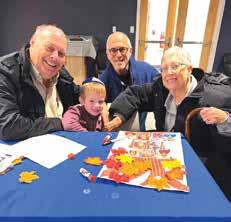
The Nursery Bet children in the Early Childhood Division of HANC’s Reinstein Family Campus in West Hempstead provided a great deal of light and happiness to some very special guests this week. As the doors opened, a stream of eager grandparents filled the Rabbi Moshe Gottesman z”l Beit Midrash and they could not wait to see and spend time with their adorable grandchildren in school. The M’Dor L’Dor (Generation to Generation) program began with greetings from Rabbi Ouriel Hazan, Director of HANC’s Reinstein Family Campus, and Mrs. Trudy Rubinstein, Director of the Early Childhood Division. Delighting the audience with songs about how much they love and appreciate their grandparents, and accompanied by the EC music teacher, Morah Kayli, the children’s sweet voices warmed everyone’s heart.
Following the performance, the children joined their grandparents at the festive tables, and together they created a very meaningful project. The children presented their grandparents with a tree that they previously created by hand painting the trunk and branches, and together they attached photographs of their grandparents, parents and siblings. This impactful project, created together by two and even some three generations, served as a keepsake gift
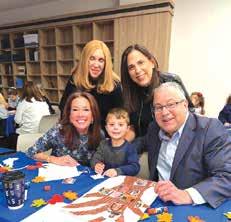
for all the honored guests. In addition, the grandparents received a HANC keepsake bag containing Hershey Kisses and a beautiful tree-themed challah cover. In keeping with the theme of “Strong roots make beautiful leaves,” this hand-crafted challah cover created with love by the children will remind the grandparents of their beloved grandchildren and the memorable time they spent together at HANC.
At the conclusion of the event, the crowd was treated to a delicious collation, including drinks, fruit platters, cupcakes for the children and bagels and pastries for the adults. The joyfulness that was evident on the faces of all who attended created such light and happiness in the room. “I loved the M’Dor L’Dor program,” commented Dr. Robert Koppel, grandfather of Nursery Bet student, Isaac. “It was great to see my grandson and his friends having fun while entertaining their families. The genealogy art project was also very meaningful.”
The children were also so pleased to have their grandparents visit with them in their brand-new school building and to share this precious experience together. Establishing strong bonds between the generations will help build a strong foundation for the children’s future education.


Talmidos of the Ganger Early Childhood Division love to re-enact what they learn in parsha. Their tent is open to all visitors
Week 7 brought everything JSL fans could hope for — game-saving stops, shootout winners, double hat tricks, and playoff-shifting results across the board. The action was fierce, the players were locked in, and the drama continued to build as the fall season rolls on. Presented by FM Home Loans
K/P Hockey
Yeled LI Panthers topped Smash House 7–2, with Yisroel Atkin delivering an elite performance in net. The final score didn’t reflect how close this game truly was — Yeled LI’s stellar goaltending was the difference. Stand Out Care earned a strong 11–5 win over Marciano PD, behind highlight-reel goaltending from Shaya Rosenbaum, who made clutch stop after clutch stop. Marciano PD came from behind to defeat Demo & Cleaning 7–2, powered by Yitzy Lazar’s hat trick, a game-defining performance that flipped the momentum entirely. Maidenbaum shut out SD Shades 6–0, led by Yoel Weiss, who played lockdown defense and added a goal of his own to secure the dominant win.
K/P Soccer
In a tight defensive battle, Yona Moskowitz delivered the game-winning strike as Maidenbaum edged PIP Printing 2–1. Zachariah Goldstein erupted for 6 goals, leading 5 Towns Central to a commanding win over SR Whee.
The undefeated streak lives on — Posh Home & Bath improved again, beating SR Whee 10–5 behind Harry Wilheim’s incredible stat line of 2 goals and 5 assists. 5 Towns Central was brilliant defensively, combining for 20 team saves in a 7–4 win over Tikva Fire, showcasing discipline and teamwork at its finest.
Fourth graders at Yeshiva Ketana of Long Island use index cards to accumulate their shorashim of commonly found Chumash words. Reviewing their box cards daily, earning additional cards, constant review of words that are more challenging, etc. are all tools to help the boys master the words and enable them to independently read and comprehend most of the pesukim on their own.

With playoff implications on the line, Jonah Zisser ignited Newman Dental with an early hat trick, powering his team to an 8–5 victory. Sushi Tokyo and Growtha battled through regulation and into a shootout, where Dovid Hoffman stood tall between the pipes, securing a 5–4 win in a classic. Without their regular goalie, Styles Design Interiors turned to Moshe Abbitan, who delivered a stunning performance — allowing only one goal in a statement win over NY Custom Closets. In a tension-filled finish, Built By Nate held off Town Appliance 9–6. Izzy Fried was outstanding, making six penalty-kill saves in the closing minutes to preserve the lead.
Ezra Donowitz exploded for a double hat trick, carrying J Works Construction to a big win over Smash House. In a heart-stopping finish, Extreme Vents defeated Tal Academy behind Pinny Weinstein’s game-winning goal with 3 seconds left, made possible by elite goaltending from Zacharia Koegel. Another thriller went to a shootout as Eeden Gardens edged Styles Design Interiors 7–6. Moshe Beiss buried the winner to close out an exciting matchup. SR Whee took down Styles Design Interiors 4–3 thanks to the incredible goaltending of Rafi Taber, who stood tall all game to secure the win.
Grade Hockey
After a tough shootout loss last week, SD Shades bounced back with a 10–9 win over Wieder Orthodontics, fueled by 8 more goals from Gavriel Abbitan, who continues to dominate the division. Emporio locked up a toptwo seed and a playoff bye with a 12–4 win over Cachet, taking care of business

when it mattered most. Sperling Productions defeated Town Appliance 4–2 in a major seeding matchup, led by Akiva Hildesheim’s 4-assist performance.
1st Grade Basketball
Marciano PD defeated Growtha 14–8, highlighted by Moshe Obadia’s acrobatic, highlight-worthy layup. Posh Home & Bath topped Seasons 6–2, behind Manny Geffen, who scored at will in a strong offensive showing.
2nd
Rita’s earned a convincing win over 5 Towns Landscaping, powered by Julius Berger’s game-high 16 points. Wieder Orthodontics took down Rip It, with Ephraim Lowy stuffing the stat sheet: 8 points, 4 steals, 4 rebounds — a complete performance.
3rd Grade Basketball
Seasons Express defeated Central Pizza Co. 18–14, with Moshe Loeb sealing the game on a beautifully executed inbound play. Tikva Fire bested Elegant Lawns 18–12, behind Chananya Kashi’s game-high 8 points.
4th/5th Grade Basketball
Newman Dental defeated Addictive Ads, led by the dynamic duo of Aryeh Reich and Dovid Bauman, who con-
trolled the tempo all game long. Wieder Orthodontics edged Rip It 22–20, thanks to Moshe Schlessel’s clutch game-winning basket in the final minutes.
6th/7th Grade Basketball
Eden Gardens beat Elegant Lawns 18–16, capped off by a half-court buzzer-beater from Michael Murdekhaev — one of the plays of the season. Maidenbaum held off Tal Academy 32–29 in a tight contest, powered by Moshe Berokhim’s 19-point performance, including the go-ahead score in the final minute.
Men’s Basketball
Advantage PT won a tough battle against Smash House 62–57, paced by Eliyahu Klein’s 16 points. Town Appliance completed a perfect 7–0 regular season, winning a nail-biter over Kol Ve’or 60–57. Effie Freundlich closed out his MVP-caliber season with a 22-point performance. SR Whee secured another victory, beating Hewlett Auto Body 63–49 behind JSL/HSL star Yisroel Wasser’s 30-point outburst and a strong finish to the final minutes to ice it. Emporio defeated Maidenbaum 72–57, powered by Yitzy Wieder’s 34 points, including 24 from beyond the arc, in a scorching shooting display.

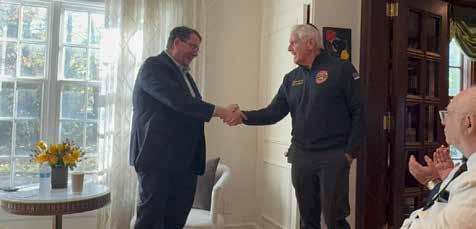
By Moshe Hill
Florida Congressman Randy Fine is the first member of the House of Representatives to wear a kippah on the floor of the House. This distinction alone, however, would not give him the adoration and respect of the Jewish community, who have seen many pretenders come and go. Rather his strong defense of that community, from ensuring education success to securing Jewish day schools and synagogues, have earned the freshman Congressman an important place in the hearts and minds of the philo-semitic and scorn from the antisemitic. This is also why pro-Israel activists, donors, and community leaders gathered in the home of Trudy and Stanley Stern in Lawrence, New York, for a NORPAC mission event co-sponsored by Ronit and Brian Gurtman and Iris and Shalom Maidenbaum to hear from Representative Fine.
In attendance were more than admirers. Nassau County Executive Bruce Blakeman. former Ambassador to Israel David Friedman, President Trump’s brand-new pick for U.S. Ambassador to Hungary Benjamin Landa—were all in attendance.
Fine wasted no time on small talk. He launched straight into the origin story that has already become legend in pro-Israel circles.
“I got into politics because I couldn’t understand my kid’s Common Core math homework,” he began, drawing laughs. After speaking with the principal of the public school his then-six-year-old son was attending, he realized that the only way to affect change was as a lawmaker, not as a parent. When he filled out the qualifying papers for Florida House, however, he had second thoughts and
threw them in the trash. It wasn’t until later that he found out that his wife secretly mailed them in. “There’s a real freedom when you never wanted the job,” Fine said with a grin. “You can say whatever the [heck] you want.”
Elected in 2016 as the lone Jewish Republican in Tallahassee, Fine never intended to become the community’s point man. That changed fast. Within a few years he pushed through a budget line that took security funding for Jewish day schools from a mere $600,000 statewide to $40 million annually. “I’m going to make Florida the safest place to be Jewish,” he vowed—and by most accounts, he has.
He was also the very first Florida legislator to endorse Donald Trump’s 2024 comeback when nearly everyone else backed Florida’s governor Ron DeSantis.
The loyalty paid off in ways that the Congressman never expected. When Trump picked Mike Waltz as National Security Advisor, a safe Republican congressional seat suddenly opened, and his first call was to Randy Fine, who was just elected to the State Senate. After initially balking at the President’s offer, Trump, in pure Trumpian fashion, said. “Randy, I got shot in the head—the least you can do is come and see me.”
After a brief discussion at Mar-ALago with no commitment, Randy Fine found out he was running for Congress after countless friends and supporters contacted him to congratulate him. Turns out President Trump posted that he was running on Truth Social. When the soon-to-be Congressman contacted the President-elect, Trump said, “Randy, you said you would do anything for me, and now you can’t say no.”
Fine ran—and won—against an opponent who raised more money in the

shortest period of time than anyone in the history of Congress. Democrats were desperate to show that Trump could be beaten, but they chose the wrong battleground. Randy Fine won the seat handily.
On Capitol Hill, Fine landed on the Education and Workforce Committee—a fitting perch for the guy whose political career started over homework. He takes particular pride in helping deliver universal school choice to Florida families, a reform he believes is now a lifeline for Jewish parents facing skyrocketing dayschool tuition and security costs.
Perhaps the most moving moment of the morning came when Fine recalled May 6, when he was scheduled to have a hearing with several college presidents testifying. His teenage son pulled him aside before he left for Washington: “Dad, can you wear your kippah on the floor today? I have friends in college who are too afraid to wear one.” Fine did. No member of Congress had ever worn a kippah during proceedings on the House floor. He hasn’t taken it off since. A few days later, he wore one again as the Speaker pro tempore.
Turning to other issues, the Congressman called America’s immigration system an outright failure and demanded an immediate end to all welfare benefits for legal and illegal immigrants alike. “We face a time of deep uncertainty,” Fine told the room, his tone turning grave. “Whether you’re a liberal or a conservative, the people who come to this country should share the values of this country.”
He posited that the focus on illegal immigration was a feint from the massive issues with the current visa system.
He was equally blunt about the political landscape. “I think the left is lost,” he said, but quickly added, “Now the risk is
on my side, the Republican Party.” Fine expressed open disgust that he has to serve alongside Rep. Thomas Massie and Rep. Marjorie Taylor Greene. “I’m willing to do what I wish Democrats were willing to do 20 years ago,” he declared—meaning call out antisemitism and anti-Israel extremism inside his own tent, no matter the cost.
The Q&A session crackled with urgency. Jeffrey Sax, founder of Safe Campus, pointed out that CUNY’s new chief diversity officer is a former CAIR-Minnesota director and asked what Congress could do about CAIR itself.
Fine didn’t flinch: “I have a bill to name CAIR as a terrorist organization.” He acknowledged the political hurdle—“They market themselves as the NAACP of Islam”—but said the evidence of Hamas ties is overwhelming. He revealed that Rep. Chip Roy is simultaneously drafting legislation to strip CAIR of its tax-exempt status. Fine also said he’s working on a disclosure bill that would force every nonprofit to publicly list every dollar it receives, foreign or domestic—a measure aimed squarely at the networks funding paid campus agitators.
Congressman Randy Fine serves not only as an example of principled conservative values that every Republican should strive for but the unflinching pride in his Judaism that every fellow Jew should strive for. His outspokenness isn’t unnoticed. He has received more death threats than many of his colleagues and three people are currently sitting in jail for such threats. Yet he is not deterred. Randy Fine will continue to fight the fight, so he deserves our support.


By Sarah Asherov
HAFTR’s annual Pep Rally gives students a chance to show their spirit and come together for one of the most exciting events of the year. The gym was buzzing before it even started. Laughter echoed, music played, and the teachers organized the crowd while students called out to friends and filled up the bleachers. The noise grew

louder as the anticipation built for what was to come. This year, every student athlete was recognized, from basketball and hockey to soccer and volleyball. The cheers got louder with each name called.
“It’s just so fun to see everyone together and celebrate our teams,” said senior Ariana Rakhminov. The moment reminded everyone that school spirit isn’t just about sports, but about everyone who makes up our community and

supports one another.
After all the teams were introduced, the crowd enjoyed two videos, one made by the students and one by the faculty, showcasing fun moments from school life that brought plenty of laughs and school pride. The energy kept building as students took part in games that got the whole crowd involved. “Even if you’re not on a team, it’s impossible not to participate,” said senior Leia Cohen. The gym
was filled with excitement, applause, and a sense of connection that made the whole event special.
Even after it ended, students were still talking about their favorite parts of the program while they headed back to class. The Pep Rally wasn’t just a break from the routine; it was a celebration of school pride, teamwork, and a reminder that everyone belongs here and everyone is connected.

Last week, HAFTR came alive with the warmth, spirit, and joy of Shabbat through a series of meaningful programs across all divisions. The schoolwide initiative highlighted the power of Shabbat to unite our community and served as an inspiring reminder of what it means to belong to something timeless and larger than ourselves. Grounded in the HAFTR value of Makom Shelanu, our place, students of every age experienced how Shabbat deepens our sense of achdut and connection to Am Yisrael.
In Early Childhood, the youngest students explored the magic of Shabbat through a joyful Grandparent Chal-
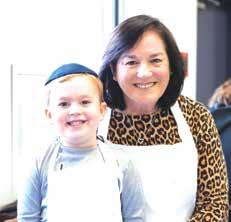
lah Bake. The hands-on experience of shaping and braiding challah alongside grandparents and loved ones created a touching bridge between generations, showcasing how family, tradition, and warmth shape early Jewish identity.
The Lower School welcomed more than 200 families for its annual Challah Bake, led by Ms. Tova Zucker, Assistant Principal and Head of Judaic Programming. The lively evening featured song, Torah insights, and a special art project in which students designed personalized flower boxes, adding creativity and color to the celebration.
The Middle School continued its beloved tradition with the annual Cholent

Cookoff, transforming the hallway into a hub of delicious aromas and spirited camaraderie. Judges Rabbi Ira Wallach (Rosh Yeshiva of HAFTR High School), Frumee Taubenfeld, Elan Kornblum of Great Kosher Restaurants, Josh Matek, and David Mosberg of SmashHouse lent their expertise and enthusiasm as students showcased their culinary talents. The event highlighted the warmth, comfort, and community spirit that Shabbat brings.
In the High School, students experienced Shabbat through both creativity and reflection. Girls participated in a meaningful Challah Bake, while boys engaged in thoughtful discussions explor-
ing the halachot and values of Shabbat. Together, they reflected on how Shabbat offers a moment to pause, reconnect, and rediscover shared identity and purpose. HAFTR extends heartfelt gratitude to PTA Presidents Mrs. Danna Kalter and Mrs. Rachel Farber, as well as the Shabbat Project Committee Chairs, for their dedication in bringing this special week to life. Thanks to their leadership and the enthusiasm of our teachers, parents, and students, HAFTR experienced a week of unity, ruach, and Shabbat joy that strengthened our community and enriched our shared Makom Shelanu.


The students of HANC Middle School had a truly remarkable experience on Monday morning. In honor of the Sigd festival, an ancient Ethiopian Jewish tradition marking the community’s yearning for Jerusalem and their heroic struggle to make Aliyah, the students gathered for a powerful, immersive presentation. Rabbi Ouriel Hazan, Head of School N–8 of HANC’s Reinstein Family Campus, guided them through the history and hardships of Ethiopian Jewry, speaking as photos, maps, and a deeply moving family-written song about their treacherous journey played on the jumbo screen. As the students learned about this extraordinary chapter in Jewish history and the miraculous rescue that brought Ethiopian Jews from turmoil to their homeland, the entire room was visibly captivated.
Then came a moment that stunned the audience. Rabbi Hazan welcomed Mazi Pilip, Nassau County Legislator for District 10 and a proud HANC parent, to share her own family’s Aliyah story. Mazi described her family’s long-held dream of reaching Israel and the immense challenges that delayed it. In 1991, when she was nearly 12, civil war broke out in Ethiopia, forcing her family to flee immediately. They were instructed to go to the Israeli embassy in Addis Ababa, where thousands waited anxiously for the chance to leave. After their paperwork was processed, they were brought to the airport. Many, having never seen airplanes before, believed they were witnessing the fulfillment of the prophecy that Hashem would bring them to Eretz Yisrael “on eagles’ wings.” To rescue as many people as possible, El Al removed all the seats from the planes, and passengers sat tightly packed together, singing with joy throughout the long flight to Israel in what became known as Operation Solomon.
The transition from a remote, thirdworld environment to a modern Israeli
society was intense. They did not share a common language with Israelis, had never encountered modern technology, and were suddenly surrounded by conveniences far beyond anything they had previously known. They had preserved Jewish practice for generations but only had access to Torah She’bichtav, the written Torah, meaning holidays like Purim and Chanukah were completely new to them. Mazi recalled being deeply inspired by the Israeli soldiers, men and women, who welcomed and assisted them at the airport. She made a promise to herself that after high school she would serve as well. Despite her father’s hesitation, she fulfilled that dream and proudly joined the IDF, serving in the paratrooper brigade.
Mazi continued her education at Haifa University and later at Tel Aviv University. She met her husband, who emigrated from Ukraine and became a doctor, and together they built a beautiful, large family. After moving to the United States, she noticed how many Americans lacked knowledge about Israel’s history and the incredible opportunities available there.
As antisemitism escalated, she felt compelled to become a strong voice for Am Yisrael. Her message to the students was clear and uplifting: be strong, be proud Jews. “You are part of a people who have given so much to the world. Kol ha’kavod! Be proud Jews. Together we can start to heal and change the world.”
Her presentation concluded to thunderous applause. One glance at the children’s faces made it evident how deeply they had been moved, not just by the history they learned, but by meeting a woman whose strength, intelligence, and unwavering dedication to community and homeland brought that history to life.
“You are such an inspiration!” one student exclaimed, echoing the sentiments of everyone in the Beit Midrash. It was an experience the students and faculty will carry with them for years to come.

Seniors in MTA’s Names Not Numbers Holocaust Documentary elective participated in a meaningful lunchtime assembly with a special guest. Jeff Salgo, a retired CBS News producer, shared best practices in interviewing that he developed over more than 35 years in the field of broadcast journalism. His goal was to help students prepare for their upcoming interviews with Holocaust Survivors.
Jeff introduced the mnemonic HRE: History, Research, and Empathy. He explained that an interviewer must understand the background of the person they are interviewing (History), come prepared and well-informed (Research), and
create a respectful, sensitive space for the interviewee to share difficult memories (Empathy).
Students were able to ask Mr. Salgo about his experiences as a CBS News Director, Associate Director, and Producer. After the presentation, they practiced their skills through “Mock Interviews,” receiving personalized feedback on their strengths and clear, practical tips for improvement.
The 22 seniors participating in Names Not Numbers will continue preparing diligently and look forward to welcoming their Survivors to MTA as they move forward with this powerful project.

Shulamith Middle School Girls had the distinct privilege and honor to hear from Marian Lazan. Mrs. Lazan is a well-known speaker of her personal experience during the Holocaust and how she survived and still thrives despite the circumstances. Students were
riveted and impressed with how poised and resilient Mrs. Lazan portrayed her experience. Her novel, Four Perfect Pebbles, further discusses Mrs. Lazan’s life and all that she faced. Everyone left feeling inspired by this extraordinary woman.

Last week was filled with the delicious smell of challah as everyone at HALC baked in honor of the parsha. At Lev Chana, many classes baked challah and learned about the special mitzvah of hafrashat challah. HALB’s Shaar Lev program had their own beautiful program. Shaar Lev meets after school and is for special needs stu-

dents who attend public school. It gives them an opportunity to learn with morot and rebbeim when they are done with their regular school day. And finally, last Thursday night, students in first through eighth grade joined together with their mothers, teachers and morot for a challah bake filled with inspiration, dancing, and fun.



At the Yeshiva University High School for Girls (Central), academic excellence takes many forms. From inspired coursework and teaching to the unique programs that give students a chance to pursue their passions in greater depth, YUHSG’s signature initiatives invite students to explore, question, and create.
Now in its third year, the Adira Rose Koffsky A”H Humanities Scholars Program, helmed by Humanities Department Chair and Director of College Guidance, Mrs. Rena Boord, continues to offer an immersive experience for students who demonstrate talent in literature and visual or performing arts. “The program’s objective is to get the students excited about the humanities,” Mrs. Boord said. “There’s something about sitting in a small group and talking about literature and artwork. That experience can bring work to life.”
Established in memory of 2022 alumna, Adira Rose Koffsky A”H, who was a beacon of the creative and performing arts while a student at YUHSG, the program guides participants in exploring major works of literature through the lens of history, art, and philosophy. The experience is fun, but rigorous; sophomores, juniors, and seniors are required to apply to the program with writing samples and teacher recommendations. “They have to commit to the humanities in a whole-hearted way in order to strengthen their connection,” Mrs.
Boord said. Plans for the semester include a trip to the Broadway show & Juliet, a lecture from Yeshiva University’s Dr. Ann Peters, who will address the current junior and senior reading assignment, The Age of Innocence, and a trip to YU’s Stern College Dramatics Society for a play.
Among Central’s most established programs is YUHSG’s Rambam Bekiut program, a beloved cornerstone of the school’s Judaic Studies curriculum. Led by YUHSG’s Rosh Beit Midrash, Judaic Studies faculty Rabbi Zvi Lew, Rambam is designed for students seeking deeper Talmudic exploration, with participants engaging in guided study all four years of high school. “Rambam is a place where students can learn about aspects of Jewish law that they might not otherwise,” Rabbi Lew said. “We navigate different topics together and learn in depth. They accomplish a lot in four years.” Upcoming topics will include the laws of inheritance and the laws of charity. All points are addressed in Rabbi Lew’s weekly lectures, which are featured on YU Torah to an audience that includes a wide alumnae network. YUHSG’s Rambam Bekiut program is also the only program of its kind that provides an opportunity for a girls’ school to learn with YU Roshei Yeshiva. Another longstanding cornerstone of YUHSG’s curricular offerings, the school’s Science Institute, continues to produce a new generation of scientists
and engineers. Recently, Science Institute junior Annabelle Klein presented her summer research project, “The Effect of DNA Protective Buffers on Recovering DNA Evidence From Challenging Samples,” at Hofstra University’s Summer Science Research Program (HUSSRP) poster session. And senior Kayla Etra was chosen to present her research project, “Performance Enhancement of Anion Exchange Membrane Fuel Cells via ZnO Atomic Layer Deposition and Silver Nanoparticle LB Trough Coating,” at the Materials Research Science (MRS) conference in Boston. She will be joining her Science Institute peers, junior Emily

Segall and senior Sarah Leah Sullivan, in presenting on December 2. Science Institute students concentrate their elective studies on college-level Science, Math, and Research Methodology courses and complete independent lab research during sophomore and junior summer internships.




Mrs. Ayzin’s second and third grade class learned all about Election Day! The students discussed what it means to have an opinion, how to share your own thoughts, ideas or preferences, and learned that it’s perfectly fine for friends to have different opinions.
To put their new knowledge into action, the class held a fun snack election! Students sampled a few interesting flavors of chips and popcorn, then used ballots to vote for their favorite. Each student placed their ballot into the class ballot box, and Mrs. Ayzin tallied the votes. Together, the class represented the results with tally marks and created a colorful bar graph to display their findings.
To tie the activity into their opinion
Rav Simcha Horowitz’s third grade talmidim at Yeshiva Darchei
Torah celebrated a siyum on Parshas Vayishlach, with several talented classmates forming their own band for the occasion

writing unit, students then wrote about why they chose the snack they voted for, giving clear reasons to support their choice. In the end, the winning snack was the maple popcorn; and there was one thing everyone was able to agree on, it was delicious!

Bikur Cholim FR/5T hosted a Volunteer Appreciation Event to honor the incredible individuals who give their time and care year-round. The evening included a hands-on babka bake led by professional baker Naomi Elberg, with each volunteer taking home two babkas, a recipe card, a Bikur Cholim apron, and the book Angels of Mercy, sponsored by Simi Greenbaum. Volunteers also en-
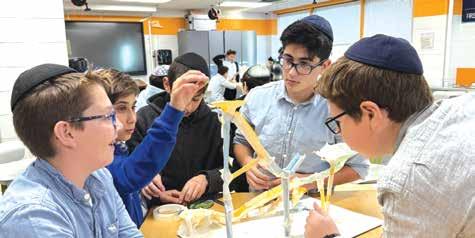
Mrs. Korman’s seventh grade science class at Yeshiva of South Shore brought physics to life as they watched their handmade rollercoasters burst from potential energy into thrilling kinetic motion


joyed light desserts and time to connect and relax. The night was uplifting, meaningful, and full of the spirit of chesed.
Bikur Cholim thanks Keved Mayer and her team, and most importantly, all our amazing volunteers whose dedication brings comfort and light to countless members of our community.

The Young Israel of Woodmere community had the tremendous privilege to welcome forty almanos and one hundred fifty yesomim from the recent war in Israel — each carrying unimaginable pain and incredible resilience. With the help of devoted volunteers and generous local partners, the group was treated to an afternoon overflowing with warmth and joy: a full carnival for the children, popcorn and cotton candy machines, free shopping graciously donated by numerous Central Avenue vendors, an expansive array of snacks and drinks from Gourmet Glatt,
jewelry-making stations for the teenage girls, and manicurists and masseuses offering comfort and care to the almanos.
A lavish buffet dinner brought everyone together as stories were shared, tears and smiles intertwined, and these heroic families experienced a small taste of love from their brothers and sisters from abroad.
This unforgettable stop, the final leg of the group’s ten-day journey to America with Menucha V’Yeshua, led by Mendy Kenig, left a deep imprint on every heart present.

No cause for alarm – the Hatzalah ambulance pulled up to TAG’s building to help the kindergarten classes celebrate their reaching the letter “hey.” Thank you to our amazing
Hatzalah volunteers who took the time to come to show them the ambulance and to explain how Hatzalah is there to help them.

This past Sunday, Mesivta Ateres Yaakov welcomed an extraordinary crowd to its annual Open House—nearly 130 prospective talmidim and their parents filled the building, eager to experience firsthand what makes Ateres Yaakov such a singular makom Torah. The program offered families a meaningful window into the Yeshiva’s mission, values, and the broad range of opportunities it provides.
The day featured a lively and enriching lineup: an expansive Student Fair, dynamic panels, multimedia presentations, shiurim from rabbeim, hands-on activities, sports challenges, raffles, competitions, and a catered lunch.
As guests arrived, they were warmly received by the MAY Hanhalah, devoted faculty, and a large group of student and parent volunteers. Visitors began their day in the bustling Student Fair, set up in the Yeshiva’s spacious gym, where current talmidim proudly presented the many extracurricular programs and ini-
The Young Israel of Woodmere community had the privilege of welcoming Sasha Troufanov and Sapir Cohen, who bravely shared their remarkable story of endurance and faith through the agonizing days of their captivity. Now engaged and planning their wedding for March, their presence radiated hope and the triumph of the Jewish spirit. The evening culminated with the entire crowd erupting in Od Yishama, voices rising with emotion and unity, creating an atmosphere that was electric, uplifting, and unforgettable. It was a
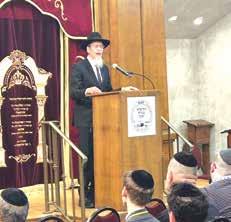
tiatives that enrich student life.
From there, the crowd gathered in the Bais Medrash to hear divrei chizuk from our Rosh HaYeshiva, Rabbi Mordechai Yaffe. Rabbi Yaffe emphasized that “our mission in the Mesivta spans far beyond the high school years,” explaining that “our ultimate goal is to shape future husbands, fathers, and ovdei Hashem—and everything we do is designed with that in mind.” He concluded by elaborating on the Yeshiva’s guiding motto: “Rabbeim for Life. Education for Life. Torah for Life.” An emotionally powerful video presentation followed, inviting families to immerse themselves in the essence of the Mesivta experience.
Students then enjoyed a lineup of engaging learning opportunities, including an exciting science demonstration with Biology and Engineering instructor Mr. Pinchas Fiber, a stimulating shiur from ninth grade Rebbe Rabbi Yoseph Lorbert, and a lively Q & A session with the Menahel, Rabbi Yossi Bennett. The afternoon wrapped up with a Chinese buffet and an
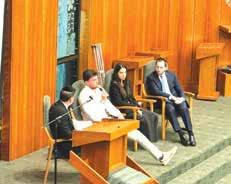
night that will long be remembered, one that celebrated life, resilience, Torah, and the unbreakable bonds of Am Yisrael.
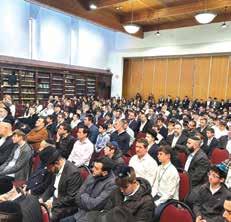
exciting grand raffle.
Parents participated in three interactive panel discussions featuring Limudei Kodesh faculty, General Studies faculty, and current MAY parents. Each panel offered candid insight and enthusiastic responses to the questions posed by prospective parents.
“There are many wonderful options in our community,” Rabbi Yaffe noted in his welcome address. “Each school has its strengths. What sets MAY apart is that we strive for excellence in Limudei Kodesh, Limudei Chol, and in the breadth of our extracurricular offerings. Our state-ofthe-art campus is always alive with activity, yet never at the expense of the personal attention and lasting relationships that allow every talmid to thrive.”
One parent expressed, “The warmth at MAY is tangible. You can see the sincerity of the rabbeim and the deep, genuine connections they have with their talmidim.”
Ateres Yaakov talmidim played a major role in the day’s success—competing
with visitors in Ping-Pong, football, and basketball, while showcasing the ruach and camaraderie that define the MAY experience. The Torah learning opportunities were highlighted by participants in the pre-Shacharis Gemara shiur, Post-Shacharis Mishnayos chaburah, optional Bekiyus shiurim, optional Night Sedarim, and Bein Hazmanim learning programs. Members of the Student Government, Arista, clubs, athletic teams and a myriad of extracurricular programs proudly represented their booths, displaying merchandise, giveaways, jerseys, championship trophies, and the many avenues for growth available to each student.
Applications for the 2025–2026 z’man are now open. For more information, please contact the Mesivta at (516) 374-6465 or visit the website at www. ateresyaakov.com
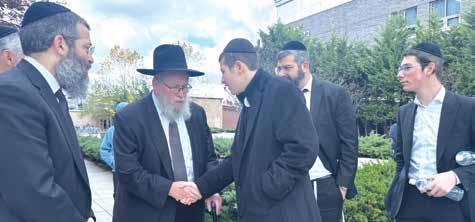


Shulamith ECC enjoyed baking challah in honor of Parshas Chayei Sarah
In conjunction with learning about Sara Imeinu and her challahs in the weekly parshios, the children at Gan Chamesh joined together for a joint, hands-on Challah Bake. This experience gave them a deeper understanding and appreciation of this special mitzvah and helped them internalize the beauty of Shabbos.


By Joseph Mitgang
The HAFTR High School Boys Torah Bowl team had an incredible performance last week, winning first place in a competitive and exciting match against MAY, Rambam, and DRS. After weeks of studying Parshiyot Devarim, Va’etchanan, and Eikev, the team’s dedication and effort truly paid off. Under the leadership of President Joseph Mitgang, the team demonstrated focus, teamwork, and a deep love of Torah learning. Ittai Rakhmanov was the standout performer of the day, scoring the ma-
jority of HAFTR’s points and showcasing outstanding knowledge and composure. Vice President Justin Berman made key contributions throughout the match, and Ezra Kanarfogel participated actively, adding great energy and support to the team effort. Thank you to the team’s coach, Rabbi Hirtz, whose guidance, dedication, and encouragement were instrumental to this success. This victory highlights the team’s hard work, unity, and passion for Torah. HAFTR is proud of the Torah Bowl team’s accomplishment and is excited to see what’s next as they continue to compete and grow together!
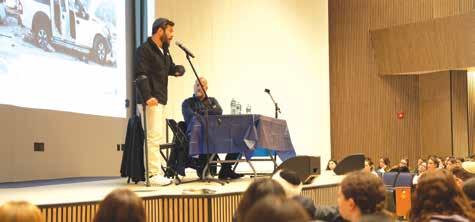
By Kira Soshtain
HAFTR students regularly daven for those living in Israel and those serving in the IDF. These daily tefillot reflect a deep sense of connection and solidarity with the people and soldiers of Israel, and keep them at the forefront of our minds. On October 29, students had the honor of hearing from two wounded Israel Defense Forces soldiers, brought by the Wounded Soldiers Forum, whose powerful stories of courage and recovery deeply impacted everyone in attendance. The program began with a heartwarming moment when the two soldiers presented Rabbi Wallach, our Rosh Yeshiva, with a medal, an emblem of gratitude and unity from those who fought to protect Israel during and after the October 7 attacks.
Staff Sergeant Major Noam Friedman, who was injured in Gaza, spoke first about his journey of recovery after being wounded in battle. He shared how difficult it was for him to get back up again, and how he even wanted to give
up. What changed everything for him was his wife’s pregnancy and the birth of his child, which gave him purpose and the strength to rebuild his life. He spoke of his determination to take each day as a gift, which reminded students of the power of hope even in the face of hardship.
Lieutenant Colonel Tomer Brouck, who was injured in Jenin, reflected on Israel’s resilience, saying, “When disaster happens, we run toward it.” He described how, in battle, Israelis, whether religious or secular, men or women, stand side by side with unity and purpose. That unity is what fuels Israel’s strength, not merely its weapons. He concluded with a message, which was a lesson he learned as he was recovering from his injury, saying that “leadership doesn’t end with a wound; it’s standing up again even when you can’t feel your legs.”
The visit from these brave soldiers left HAFTR students and faculty inspired by their message of strength, unity, and the enduring spirit of Israel.

In honor of Veterans Day, Rambam had the privilege of welcoming Syd Mandelbaum, a remarkable individual whose life blends military service, scientific achievement, and decades of charitable work.
Mr. Mandelbaum served as a Staff Sergeant in the United States Air Force, where he worked in a military hospital. Beyond his military career, Mr. Mandelbaum is widely known for his humanitarian accomplishments. He is the founder of Rock and Wrap It Up!, a groundbreaking non-profit that combats hunger by recovering unused food from concerts, schools, sporting events, and hotels. Under his leadership, the organization has distributed millions of meals. He has also worked with veterans’
support programs, environmental efforts, and educational initiatives, consistently demonstrating how one person can make a measurable impact on the world.
During the event, Mr. Mandelbaum spoke about the importance of ethical responsibility, urging students to use their talents, whether scientific, artistic, or leadership-based, to improve the lives of others. He shared stories from his military service that also highlighted his love of Judaism. As a child of Holocaust survivors, one of the driving forces of Mr. Mandelbaum’s desire to join the U.S. Army was in hakarat hatov to America for taking in his family. He told a story about how he organized a minyan at the military hospital and how much it meant to those Jewish
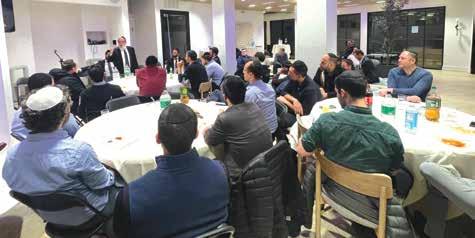
This past Thursday evening, Yeshiva of South Shore brought together over 50 fathers of the Hollander Early Childhood Center for an uplifting night of great food, meaningful connection, and powerful chinuch conversations — all focused on partnering with the Yeshiva to support their children’s growth and success.
The event, held in the beautiful lobby of 4 Franklin Place, featured a full Leil Shishi menu and an informal meet-andgreet with the Rosh Yeshiva and Hanhallah. Fathers enjoyed the opportunity to personally connect with the Hanhalla and strengthen their partnership in their sons’ chinuch.
soldiers to be able to pray even in a predominantly non-Jewish environment.
At the conclusion of the program, Principal Dr. Hillel Goldman presented Mr. Mandelbaum with a special plaque in recognition of his service to the United States and his lifelong dedication to helping those in need. In the spirit of Veterans Day, the school also announced a new initiative: Rambam will now be “adopting” an American soldier, sending care packages and goods overseas as a tangible way to support those currently serving.
The morning served as a meaningful reminder that honoring veterans means learning from their example and ensuring that our actions reflect the values and Jewish values they fought to protect.

In a small but powerful reflection of the democratic process engaging the nation this month, Mercaz Academy elected its 2025/2026 slate of Student Council officers and members last week.
and Rabbi Yehuda Neuman
A candid Q&A, chaired by Rabbi Shmuel Kamenetzky, drew laughter and insight as the Hanhallah shared stories, practical advice, and behind-the-scenes glimpses into YOSS life. The evening concluded with a lively kumzitz that carried the warmth and energy through the night.
As the first event of its kind, Father’s Night Out was a tremendous success, leaving fathers feeling connected, inspired, and proud to be part of the YOSS family. Plans are already underway for future programs to continue building this partnership.
The fundamentals of both the national and (very) local elections were the same: creative campaigns motivated by a desire to make a difference, passionate stump speeches, voter research, even consulting with experts (such as New York State Senator Steve Rhoads, who met with the Mercaz candidates prior to the election). Well-informed voters headed to the polls to cast their ballots fairly and confidentially and, once the results were tabulated, the winners were announced to fanfare.
However, there were some special qualities to the elections at Mercaz. Their one-minute campaign speeches, structured to give each of the 17 candidates equal time to address voters from 2nd to 6th grade, showed that the students’ platforms were grounded not in personal ambition but in character, chessed (kindness), and a deep appreciation of their school.
Candidates advanced great ideas for Mercaz, including holding more fundraisers for tzedaka (charity), showing daily

gratitude to teachers and school staff, and adding Mercaz Days with sports tournaments, games, and relay races. Six fifth graders competed for two hotly contested Director of Volunteers spots, a junior council position designed to organize the many students eager to contribute to the Mercaz community.
Following the speeches, students voted class by class and, at the end of the day, the winners were announced via loudspeaker. But here Mercaz again diverged from the more traditional election structure: while only a few of the candidates will become officers, every candidate who ran will serve as a member of the Mercaz Student Council, giving each student leader a chance to impact life at Mercaz this year.
Yeshiva Ketana of Long Island hosted fathers and grandfathers at an evening and morning of nachas at our Dor L’Dor Events. With a Melaveh Malka for grades 3-5 and a Breakfast for grades 1 and 2, everyone enjoyed delicious food, delightful prizes and derhoiben learning!
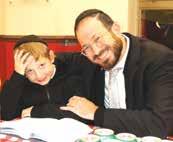

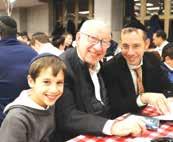

Ezra Academy is proud to announce its outstanding performance at the prestigious Apprentice Challenge hosted by Adelphi University, a competitive program that brings together top high school talent from across the region.
Ten Ezra students in grades 9-11 were invited to join the team based on merit and their demonstrated interest in marketing, business, and public speaking.
The chosen students representing Ezra Academy were ten exceptional scholars who stepped into a unique and demanding competition format. Upon arrival, each student was separated from
their school cohort and placed into newly formed teams composed of peers from ten different schools. These diverse collaborative groups were then tasked with functioning as full marketing teams— developing a concept, refining strategy, crafting messaging, and ultimately presenting their campaign to a panel of judges.
Judging was based on creativity, clarity, strategic thinking, presentation content, professional poise, and the team’s command during the Q&A portion. Out of all participating teams, only five were selected as finalists.
Ezra Academy is thrilled to share that two of the finalist teams included Ezra student representatives, meaning Ezra Academy students helped lead two of the top five teams in the entire competition. This achievement is a testament not only to our students’ intellect and drive, but also to their ability to collaborate with new peers, communicate effectively, and contribute meaningfully in high-pressure, real-world business scenarios. Their success reflects the strength of Ezra Academy’s academic programs, the emphasis we place on public speaking and critical thinking, and our students’
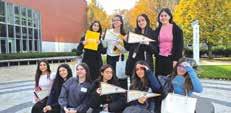
willingness to challenge themselves beyond the classroom.
We congratulate all participating students for representing Ezra Academy with excellence, confidence, and creativity—and we look forward to continuing our strong showing in future Apprentice Challenge events.

The Rambam student body had the privilege of hearing from Rabbi Steven Weil, one of the most respected voices in modern Jewish leadership. The program, held in memory of Kristallnacht, was conducted as an interview by Rabbi Zev Meir Friedman, the Rosh HaYeshiva, who guided the conversation through history, identity, and the future of the Jewish people.
Rabbi Weil currently has served as the CEO of Friends of the Israel Defense Forces (FIDF) and is the former Senior Managing Director of the Orthodox Union (OU). Earlier in his career, he was the rabbi of Beth Jacob Congregation in Beverly Hills, one of the most prominent pulpits in America. Known for his deep knowledge, clear communication, and strategic leadership, Rabbi Weil has become a major figure in Jewish advocacy,
Maamad
education, and support for Israel.
In his remarks, Rabbi Weil spoke powerfully about Kristallnacht, explaining how the pogrom marked the moment when centuries of European antisemitism transitioned into something darker and more systematic. He reflected on how American Jews long viewed their experience as a “golden age,” protected by unprecedented opportunity, safety, and acceptance. But recent years, he explained, have shown that this era may be coming to an end.
“The golden age of the Diaspora in America is over,” Rabbi Weil stated, pointing to rising antisemitism across campuses, cities, and institutions. From hostile university cultures to online hatred, he warned the students that they are entering a world where Jewish identity is increasingly challenged. But Rabbi

Weil’s message was not one of despair, it was one of responsibility and pride. He urged students to be proud, confident Jews, unafraid to stand up for themselves or their values. Jewish identity, he emphasized, is not something to hide or soften; it Is a badge of honor. He also encouraged the students to think practically about their future. With Israel likely to remain the global center of Jewish life, he told the boys to consider careers and
skill sets that would allow them to live and work in Israel if the need or desire arises. Building a profession that can “translate across borders,” he explained, is not merely a strategic choice, it is part of preparing for the future of the Jewish people. The challenges are real. The moment is serious. And the response must be a deeper, stronger, more resilient Jewish identity and commitment to halacha.
The anticipation is palpable across the olam haTorah. In batei medrash from Lakewood to London, Bnei Brak to Brooklyn, lomdim are counting down the final blatt of Maseches Chagigah, the culmination of an unprecedented six-year journey. The dream that began with a single amud is now reaching its magnificent climax: the historic Oraysa Siyum on Seder Mo’ed.
This is your chance to take part in a maamad kavod haTorah that will go down in history — a celebration of perseverance, of hasmadah, and of the eternal message that Yisroel v’Oraysa v’Kudsha Brich Hu chad hu.
A Revolution in Limud HaTorah
When Oraysa was founded just six years ago, it immediately transformed the way thousands approach limud haTorah. Its unique amud-v’chazara structure — learning one amud a day, reviewing consistently, and mastering masechtos in their entirety — brought clarity, retention, and excitement back into countless daily sedorim.
The results have been nothing short of revolutionary. Today, tens of thousands of lomdim across the globe participate in the Oraysa cycle, uniting baalei batim, yungerleit, and talmidei yeshivos in a single melody.
Kehillos across Lakewood, Monsey,
and Chicago to Yerushalayim, London, and Antwerp now have established Oraysa chaburos. Each day, the same amud reverberates across continents, connecting Yidden of every background through the timeless words of the Gemara.
Now, for the first time in history, these lomdim will complete an entire Seder of Shas together — Seder Mo’ed — marking a monumental milestone for Torah v’lomdeha the world over.
This will not merely be a siyum. It will be a majestic maamad kavod haTorah and a celebration of the power of hasmadah and the unbreakable bond between Klal Yisroel and the Torah.
Gedolei Yisroel and Roshei Yeshiva from across the Torah world will grace the event with their presence, including Rav Dovid Cohen, shlit”a, Rav Shraga Shteinman, shlit”a, Rav Noach Isaac Oelbaum, shlit”a, Rav Avrohom Gurwicz, shlit”a, Rav Malkiel Kotler, shlit”a, Rav Aharon Dovid Goldberg, shlit”a, Rav Yosef Elefant, shlit”a, and Rav Dovid Ozeri, shlit”a — along with many other prominent rabbanim, roshei chaburos, and of course, thousands of lomdei Oraysa from around the world.
Under this one roof, talmidei chachomim, baalei batim, and families will gather to celebrate this momentous siyum,
embodying Klal Yisroel’s achdus through Torah.
And as one Seder concludes, another begins: Seder Nashim. The simcha of the siyum will flow directly into the start of a new phase of learning and growth, inviting even more participants to join the Oraysa revolution.
If you’re reading this, you’re invited to join and be a part of history!
The asifa will take place in Cure Arena, located at 81 Hamilton Avenue in Trenton, New Jersey on 3 Kislev/November 23, 2025. Doors open at 5:30 p.m., with the program beginning promptly at 6:30 p.m.
The evening will feature stirring divrei chizuk, uplifting niggunim, and heartfelt shiros v’sishbachos led by Hershy Weinberger and Shloime Daskal.
With groups flying in from across the globe to be part of this unforgettable maamad, the window to secure your spot at this unparalleled maamad kavod haTorah is closing fast.
Don’t Miss This Once-in-aGeneration Maamad!
Every amud, every daf, every line of Gemara learned by thousands around the world has led to this moment. The Oraysa Siyum on Seder Mo’ed will be a living tes-
tament to what can be achieved when Klal Yisroel learns together, chazers together, and grows together.
Now, it’s your chance to be part of it.
And as Oraysa turns the page from Seder Mo’ed to Seder Nashim, now is the perfect time to join the movement that has transformed the landscape of being koveia ittim l’Torah.
Experience the simcha and sipuk that come from clarity, mastery, and consistency at a pace that works. Because with Oraysa, every amud is not just another page. It’s another step in a lifelong journey of aliyah, another layer of understanding, and another connection to Torah that will uplift your day and transform your life.
Be part of the simcha. Be part of the legacy. Be part of Oraysa. Visit OraysaSiyum.org or email Siyum@Oraysa.org.
Oraysa will begin Seder Nashim this coming Wednesday, November 26. For more information, or to set up or join a shiur or chaburah in your neighborhood, please contact Oraysa at 914.8.ORAYSA or email info@oraysa.org.
By Rabbi Yair Hoffman
On November 9, 2025, something remarkable happened at the Lawrence-Cedarhurst Fire Department. Lawrence Mayor Samuel Nahmias, Trustee Aaron Parnes, and Deputy Mayor Aaron Felder participated in a special fundraiser to support ExChief Donaven “Soupy” Wright, a proud and dedicated 38-year member of the Lawrence-Cedarhurst Fire Department and retired NYPD Detective, in his courageous battle against Stage 3 esophageal cancer related to his heroic service during the 9/11 aftermath.
The event raised $20,000 in prizes with no givebacks, featured cigars, football, Chinese auction, food, an open bar, and live music. But more importantly, it demonstrated something profoundly Jewish: the middah of hakaras hatov.
The Centrality of Gratitude in Torah
Rav Michel Birnbaum, zt”l, the great mashgiach of Mesivta Tiferes Yerushalayim, wrote in his Sichos Mussar (page 58) that our emunah is inextricably bound with the middah of hakaras hatov to Hashem. Rav Birnbaum emphasizes that hakaras hatov extends both to Hashem and to our fellow man.
When these three public officials stood up to organize and participate in this fundraiser, they weren’t just performing a civic duty. They were demonstrating a Torah value that resonates deeply within our tradition: recognizing and responding to the good that others have done for us.
Ex-Chief Wright spent his life serving others. As a member of the fire department for 38 years and as an NYPD Detective who responded to the devastation of 9/11, he put his life on the line to protect the Lawrence-Cedarhurst community and all New Yorkers. Now, as he faces his
own battle with 9/11-related cancer, the community—led by these three officials— stood by him. This is hakaras hatov in action.
The concept of hakaras hatov permeates our sacred texts:
To One’s Spouse: Rabbi Akiva in Kesuvos 63a tells his students those famous words, “Sheli v’shelachem, shelah All my Torah, and all of your Torah, is hers!” referring to his wife. In this statement, Rabbi Akiva teaches us about the hakaras hatov one must express to one’s spouse. This is something that must be reiterated and emphasized nowadays— doing so can save many a marriage.
Past Failures: The Alter of Slabodka explains that Adam haRishon’s first aveirah was that when confronted by Hashem about eating from the Tree of Knowledge, he laid blame on his wife and expressed a lack of appreciation. Hashem provided mankind with an “eizer kenegdo,” a gift and helpmate by his side (one with greater binah), and instead of saying thank you, Adam laid blame on her.
The Torah tells us, “V’lo haya mayim la’eidah—Klal Yisrael had no water” (Bamidbar 20:2). Why did we have no water? The Kli Yakar explains that we did not eulogize Miriam properly when she passed away, and it was on account of our lack of hakaras hatov. To Miriam, in whose merit we had the Be’er Miriam, we should have expressed our appreciation better.
In his battle with Og, Moshe Rabbeinu was concerned that the debt of gratitude the nation of Israel owed Og for telling our forefather Avraham about Sarah’s kidnapping (see Rashi in Parashas Chukas 21:33-34) was significant. It was so significant that it could have changed the tide of the war.
Although it is a matter of tzniyus and

good character not to show off wealth, there is a fascinating Rashi in Devarim 2:6 that teaches we should purchase from the descendants of Eisav and not hide that which Hashem has given us, because hiding the good Hashem has done for us can be a manifestation of ingratitude.
We may not loathe the original Mitzrim (Devarim 23:8) because they were a source of shelter for us, which comes from the obligation of hakaras hatov. We must express this gratitude even though it was quite clear that they did so for their own designs and purposes.
Rashi explains that the entire parashah of Bikkurim (Devarim 26:3) exists so that we develop the ability to express hakaras hatov, genuine appreciation, and not be a kafui tov, an ingrate.
What Mayor Nahmias, Trustee Parnes, and Deputy Mayor Felder demonstrated goes beyond politics or public relations. They showed us that when someone has dedicated their life to serving and protecting others, we have an obligation—a Torah obligation—to stand by them in their time of need.
Soupy Wright didn’t serve the community for recognition or reward. He served because that’s what heroes do. But the Torah teaches us that even when someone serves altruistically, we must recognize their contribution and respond with gratitude. The obligation of hakaras hatov doesn’t depend on the motivation of the giver; it depends on the character of the receiver.
The Lawrence-Cedarhurst communi-
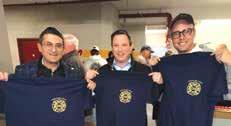
ty’s response—rallying together, donating, and showing up—proves what community really means. As the social media post concluded: “Together, we proved what community really means.”
We live in an age where gratitude is often taken for granted. We expect service without acknowledging it. We receive kindness without reciprocating. The story of Ex-Chief Wright and the response of these community leaders reminds us that hakaras hatov is not optional—it’s a fundamental Torah value that defines who we are as a people.
Let us take this lesson to heart. Let us express appreciation to our spouses, to those who serve our communities, to our teachers, and to all who contribute to our wellbeing. And let us remember that hakaras hatov to our fellow man is inseparable from our hakaras hatov to Hashem.
As Rav Birnbaum taught us, gratitude is not just a nice character trait—it is the foundation of our emunah itself.
May Ex-Chief Donaven “Soupy” Wright have a refuah sheleimah, and may we all merit to be people who truly recognize and appreciate the good in our lives.
The author can be reached at yairhoffman2@gmail.com

By Chaim Gold
This coming 17 Kislev/December 7, will NOT be “A Day of Infamy.”
Unlike December 7, 1941, which was described by President Roosevelt after the Japanese attack on an American base in Pearl Harbor as “A Day of Infamy,” this year, December 7, will be a day that will live on in fame! It is the day when tens of thousands of Daf HaYomi B’Halacha learners will make a siyum on Hilchos Shabbos, Chelek Gimmel of Mishnah Berurah, in the third machzor of Daf HaYomi B’Halacha, and begin Chelek Daled!
Now, lomdei Dirshu already know that although Dirshu frequently emphasizes the importance of making gala siyumim to celebrate milestones in limud haTorah and yedias haTorah those celebrations are also springboards for further growth. In the case of Daf HaYomi B’Halacha, however, this means the beginning of Chelek Daled, Hilchos Eruvin with all our strength and enthusiasm.
Filling the Empty “Chairs”
Before Dirshu embarked on Chelek Daled in the first machzor of Daf HaYomi B’Halachah, the hanhala of Dirshu was a bit wary over the fact that Chelek Daled of Mishnah Berurah was viewed by many as a closed sefer, a sefer that seemed to only be understandable by experts in Eruvin When they visited the great Rosh Yeshiva, HaGaon HaRav Aharon Leib Shteinman, zt”l, and expressed their fear, Rav Shteinman, with his ever-present smile, explained, “Do you know that when Rav Meir Shapiro established the Daf HaYomi most people laughed at him? Today, however, the entire Klal Yisrael learns Daf HaYomi. That is the way it is with all things of this sort. People are skeptical, but if you persevere, the entire Klal Yisrael will do it. The same is true regarding hilchos Eruvin.”
This brings to mind the famed meeting between the Chofetz Chaim and Rav Meir Shapiro, founder of the Daf HaYomi of Talmud Bavli and Rosh Yeshiva of Yeshivas Chachmei Lublin: When Harav Meir Shapiro came to Radin to visit the Chofetz Chaim, the Chofetz Chaim told him, “Yasher koach, thank you, Rav Meir! Thousands of chairs
in Gan Eden are giving thanks to you for rescuing them from eternal loneliness.”
The Chofetz Chaim went on to explain, “What do you think, the chairs in Gan Eden bear names of the people who will sit on them? No, that is not the way it works in Gan Eden. The chairs there possess the names of the Masechtos in Shas. One chair bears the name of Masechta Shabbos, another Masechta Eruvin. A Jew who arrives in Gan Eden after his years in this world and has learned Masechta Shabbos will be able to sit on the Masechta Shabbos chair. Of course, all the ‘popular’ Masechtos have many people who sit on them, but what of the Masechtos that are rarely learned? What about Masechta Zevochim and Menachos and other Masechtos from the order of Kodshim – they sit forlorn and alone. Until now, it was rare for anyone to merit sitting on them. Now, however, since you have instituted the Daf Yomi, you have ensured that these chairs are also full of people. You have saved thousands of chairs from loneliness. What a zechus!”
The “Meis Mitzvah” of Mishnah Berurah
It is no secret that Chelek Daled of the Mishnah Berurah has until now been the “meis mitzvah, the lonely chelek” of Mishnah Berurah. Virtually every yeshiva graduate has learned portions of the other five volumes of Mishnah Berurah. Unfortunately, and tragically, the fourth volume that is largely devoted to the complex halachos of Eruvin has been neglected.
Now, the time to place Chelek Daled to its rightful place has come. Dirshu has dedicated itself to making it easier and giving lomidim any tools that they need to be able to properly learn and understand Chelek Daled
The Dirshu Mishnah Berurah with its clear diagrams and guidance in the Biurim and Musafim is one way that this is being done.
Another exciting development is that this year, Dirshu will be opening a special hotline called “Kav Hameishivim” where great experts in hilchos Eruvin will always be available to answer questions regarding the text of the Mishnah Berurah and the poskim as well as on practical matters related to Eruvin. (More details
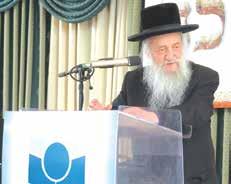
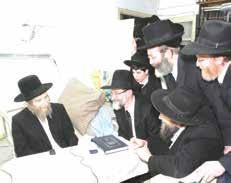
Hanhalas Dirshu in discussion with HaRav Aharon Leib Shteinman prior to the start of Chelek Daled, 2012
on this exciting and innovative initiative next week.)
Another important thing to contemplate this year is that in the course of the past year, multitudes across the entire world have completed Masechta Eruvin in the popular, worldwide, Amud HaYomi program. Those who learned the masechta are already familiar with all the concepts, terms and halachic ideas.
Learning Hilchos Eruvin is “a Ticket to Olam Habaah”
In truth, Daf HaYomi B’Halacha participants are already at the cusp of greatness. For nearly two years, they have been deeply immersed in hilchos Shabbos. Day after day, week after week, month after month, test after test, the lomdim learned and reviewed and are now familiar with the entire gamut of hilchos Shabbos.
The great posek HaGaon HaRav Shmuel Wosner would say that those who complete hilchos Shabbos should celebrate their accomplishments. They deserve to be placed on a pedestal and are worthy of the greatest admiration.
That being said, Rav Wosner explained, that in a way, learning hilchos Shabbos is easier than learning hilchos Eruvin for the simple reason that there are many meforshim on hilchos Shabbos, empowering learners to get a good grasp of the material. When it came to hilchos Eruvin, however, the Chofetz Chaim would have unique praise for people who learned hilchos Eruvin because of the dearth of meforshim. Rav Wosner related that he recalled how the Chazon Ish invested tremendous effort and toil in learning hilchos Eruvin and ended off, “If the wider tzibbur learns Eruvin properly it is a ticket to Olam Habaah!”
The fact that it is specifically now that the Daf HaYomi B’Halacha program is beginning hilchos Eruvin offers a unique opportunity for those lomdim of the Amud HaYomi to take their newly acquired knowledge of Eruvin to the next level. Not just knowing the Gemara but following the Gemara through to its ultimate conclusion in halacha l’maasah For those lomdim, every word of practical halacha in the Mishnah Berurah and the related Biur Halacha will be clearly understood as they are intimately familiar with all the scenarios discussed. What an opportunity!!
Indeed, as Dirshu embarks on the Daf HaYomi B’Halacha of Chelek Daled, Mishnah Berurah, it is really the time to “chap arein - to seize the opportunity”. For those already learning in the Daf HaYomi B’Halacha Program, now is the time to maintain the momentum in the quest for shleimus in knowledge of all chalakim of the Mishnah Berurah.
For those who are not yet part of the program, now is your chance! Now is the time to fill the Chelek Daled chair in shomayim! Now is the time to finally get a true kinyan in Chelek Daled. In just a few months, with approximately a half hour of learning a day you can have a kinyan in Chelek Daled
It’s the opportunity of a lifetime! Don’t miss it!
To join, or to obtain a luach of Dirshu Daf HaYomi B’Halacha together with a luach of all of Dirshu’s other programs, please contact Dirshu at, 1-888-5-Dirshu or e-mail info@kolleldirshu.org.

By Avromi Mostofsky
Moments before her passing, Mrs. Bina Kasirer shared with her students a thought from Rav Yaakov Kamenetsky, zt”l. Many say that Sarah Imeinu died from the shock of hearing about the Akeidah, but Rav Yaakov explained that this isn’t accurate— nobody leaves this world even a moment before their time. Sarah passed away simply because her time had come. Mrs. Kasirer repeated this idea to her class ten times. Her husband, Rabbi Hersh Kasirer, yblc”t , told me that someone asked him why he thought she repeated it so many times. To him, it was obvious: she wanted to give the girls nechama, to help them understand that moments later, when her own time came, it would be part of Hashem’s plan and not because of anything else. This was her final lesson to her talmidos, and to all of us—a lesson she lived every day of her life. Nothing “just happens.” It all happens because it is part of His great plan.
I first got to know the Kasirer family more than twenty years ago in Camp Dora Golding, where, for several summers, I was bunkmates with their son Ashi. It was a bittersweet reunion this week when we saw each other for the first time in many years.
Ashi hadn’t been in the room when I first got there, but a few minutes later, he came in, sat down, and quietly told me about a note he’d come across from his mother. She had written it during one of her hardest medical periods. In it, she wrote, “I saw so much good—that this also must be good.” She was clearly struggling to understand why what she was going through was good, yet she inherently knew it must be. Even while suffering physically, she was still trying to frame her pain within the context of all the good she had seen in her life.

During one hospitalization, exhausted and uncomfortable, she grew frustrated with the endless questions from interns and medical students. One intern noticed her discomfort, apologized, and said, “You must not be doing well.” She answered, “My body isn’t doing well. My neshama is doing great.” One of the doctors, who was religious, explained to the others: “She said her soul feels strong even though her body doesn’t.”
Rabbi Kasirer told me that on one emergency trip to the hospital it was pouring rain. When Hatzalah arrived at the emergency entrance, the rain suddenly stopped. As they wheeled her in, she asked them to pause for a moment. They asked why. She said Hashem had stopped the rain so she wouldn’t get wet coming out of the ambulance, and she wanted to stop and thank Him.
About a week before she was nifteres , a woman called her for chizuk Mrs. Kasirer stayed on the phone for a full hour. When her husband came
home, he found her drained, practically collapsed into the armchair. Worried, he asked if everything was OK. She said she was fine—just exhausted from giving the woman the support she needed. He pointed out that most people, especially someone in her condition, would have ended the call much sooner. But she stayed on, ignoring her own issues, because the caller needed it.
Everyone knows how central tefillah was to her, but not because of her needs. She was focused on thanking Hashem for everything. She was also always ready for Moshiach. We know that when the Jews left Mitzrayim, Miriam led the women with her tambourine. So, during COVID, Mrs. Kasirer bought a tambourine and kept it right near their front door (where it still sits)—ready to lead the women when we finally leave this last galus.
She was meticulous about shmiras halashon , both in what she said and what she allowed herself to hear. At the
levaya , Ashi shared a story: someone once did something that upset her deeply. She desperately wanted to respond but held herself back. Instead, she called Ashi to vent to him, so she wouldn’t say anything reactionary to the person involved. She even left a voicemail when he didn’t pick up, explaining how hard it was for her to remain silent. Ashi decided that this saved message—this raw moment of her working on herself—was the real hesped. It reminded him (and us) that she wasn’t some superhuman who was never fazed by hurt; she felt the slights like anyone else. Yet she spent a lifetime, with herculean effort, mastering silence when it was the right thing. As Ashi said, this was the pasuk in Tehillim come alive: “Mi ha’ish ha’chofetz chaim…nitzor leshoncha mei’rah, Who is the person who desires life…guard your tongue from evil.” Who knows how much time she received, or good that happened in the world, because of that silence.
When I was younger, I was a very picky eater. Although I loved most of the food in camp, on Friday night the only thing I would touch was the soup. Somehow, one Shabbos I ended up near the Kasirers’ table, noticed they had salad, and asked if I could have some. Mrs. Kasirer immediately said yes— even though she had just one container for her whole family. After that, for well over a decade, every Friday night I went to their table where she would hand me a heaping bowl with the biggest smile, saying, “It’s l’kavod Shabbos Kodesh— enjoy it l’kavod Shabbos Kodesh!” Ashi and I laughed when I reminded him about the Entenmann’s crumb donuts. On fast days, the fasting campers would go to Mr. Z’s supermarket, and, as Ashi put it, “buy just about everything
because we were starving.” After spending all my money the first time I went, I learned this lesson, albeit the hard way. After that, I stuck to the same thing — a box of Entenmann’s donuts and orange juice. As we broke the fast, I went around to some of the families offering to share the donuts. Everyone turned me down—except her. When I reached the Kasirers she said her husband and the boys don’t eat Entenmann’s, but she loves the crumb ones. From then on, after every fast, I made sure she got her crumb donut. If she wasn’t in the dining room, I sent it back to the bungalow with Rabbi Kasirer. I used to tell her it was “payment for the salad,” and it became our little running joke.
Back then, campers hardly ever got to call home, and when you did, it meant using a calling card at a very public payphone. You had less than five minutes and a line of campers listening to your every word. One week, on a whim, I decided to knock on their bungalow door and ask if I could use their phone to call my parents. She said yes without a second thought. From then on, every Friday until I became a staff member, I showed up before Shabbos to make
my call—whether it was five minutes or an hour. She always welcomed me like it was the most natural thing in the world. This was the kind of chesed she was known for in camp.
Mrs. Kasirer loved camp. You’d often see her on her porch surrounded by a mountain of sefarim and books. The women used to joke that they were
myself—you don’t need to help.” How she planned to shlep a picnic table alone was a mystery, but she simply refused to be a burden on anyone.
Rabbi Kasirer mentioned that this past Shabbos, he was lost in thought during kriyas haTorah. Suddenly, he heard the pasuk, “Vayomer aleihem al t’akvuni v’Hashem hitzliach darki
One of the doctors, who was religious, explained to the others: “She said her soul feels strong even though her body doesn’t.”
really in “Camp Bina” (a play on Camp Dina, CDG’s girls’ camp) because of the energy and inspiration she brought. She arranged shiurim, Tehillim, and always worried about everyone’s needs.
This past summer, when she hosted her annual shiur for her mother’s yahrtzeit on the porch, she asked to borrow my picnic table and insisted, “I’ll carry it
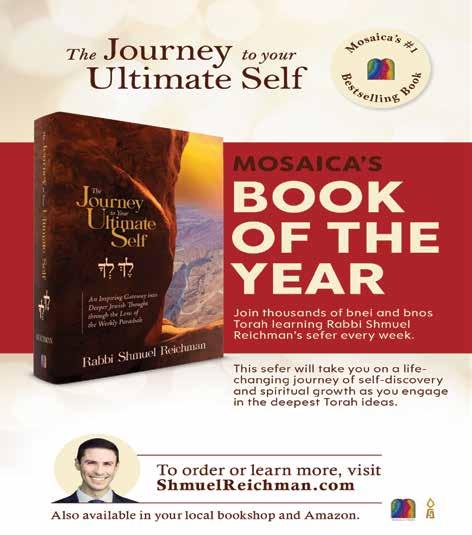
shalchuni l’adoni , Do not delay me, for Hashem has made my way successful— send me to my Master.”
He felt it was a message from Bina: “Hashem has made my path successful; now it’s time for me to go to my Master.” It gave him a tremendous sense of nechama.
Every summer, in memory of her
mother, she made magnets for the women in camp with beautiful, uplifting messages. One from 2017— which was quoted at the levaya—read: “A long life may not be good enough, but a good life is long enough.”
I know I’m probably not the most qualified person to write about someone so great, and I’m sure many proper biographies will be written in the years ahead. Still, I feel privileged to have known the Kasirers and their incredible children for well over twenty years. Each of the children, in their own way, walks in their parents’ footsteps—the living fulfillment of the Gemara in Taanis: “Ilan, ilan ba’meh avarechacha… she’yihu zarecha k’moscha, Tree, tree, with what shall I bless you… that your offspring should be like you.”
That every one of the Kasirer children is, in their own unique way, just like her (and like their father, yblc”t) proves that she didn’t merely live a good life—she lived a life of true greatness.
May she be a meilitzah yosher for her family and for all of Klal Yisrael, and may we very soon see her leading the women once again—tambourine in hand—at the front of the Geulah.


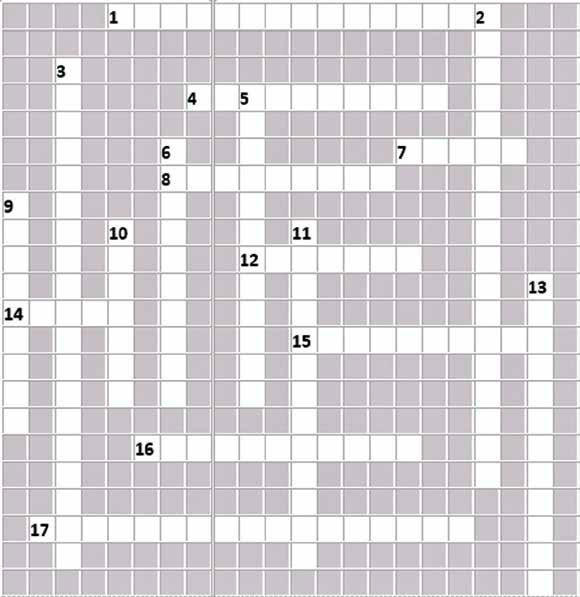
Thanksgiving
PartitionPlan
Sputnik
JamesPolk
JoeMontana
IrvingBerlin

Beatles
OJ Simpson
Chads
SpiroAgnew
LeeHarveyOswald
Across 1. JFK’s killer
4. Resigned as VP due to charges of income tax evasion on kickbacks received while governor of Maryland
7. The nation focused on these hanging things in Florida after the 2000 elections
8. Won Heisman Trophy Award in 1968 but is most infamous for the crimes leading to a white Ford Explorer chase through L.A.
12. In 1962, these guys from Liverpool had their first recording session under the name of their newly formed band.
14. Egyptian president who made historic visit to Israel
15. President Reagan reveals secret arm deal
16. Celebration of those who serve.
17. “Four score and seven years ago…” Down
2. Chicago Tribune’s election eve snafu
3. Writes “Old Ironsides.”
5. Composer of “G-d Bless America”
6. 49ers QB who completed NFL record 22 consecutive passes
9. 11th president of U.S.
10. The world’s first inhabited space capsule launched by Russia
11. Famous UN plan voted on November 29, 2007
13. Pass the turkey, please Answers: Across
1. Behind the dryer, living its best independent life.
2. In your pant leg, waiting to embarrass you at work.
3. In your kid’s backpack, stuck to a folder since October.
4. In the laundry basket you “checked three times.”
5. In the universe’s glove compartment.
6. Inside a fitted sheet, plotting.
7. In your spouse’s sock drawer (they’ll deny it).
8. In the dog’s stomach (proof not required).

14. Wrapped around a dryer drum like it’s holding on for dear life.
15. Behind the couch, next to three pens, seven crumbs, and your will to clean.
16. Inside a pillowcase — sock nesting season.
17. Behind the washing machine, planning a revolution.
18. In your laptop bag, beside that granola bar from 2019.

9. In the dryer lint trap, fused to history.
10. In a parallel dimension where all socks live happily ever after.
11. Inside the fitted sheet fold — the Bermuda Triangle of bedding.
12. Stuck to the inside of a hoodie sleeve like a sock-parasite.
13. In the freezer, next to the waffles, looking suspiciously comfortable.
19. Behind the toilet… why? HOW??
20. In a suitcase from a trip you never emotionally recovered from.
21. Mixed into the clean towels pretending to upgrade its lifestyle.
22. Inside a board game box, replacing a missing game piece.
23. Jammed into the vacuum hose like it tried to escape the chores.
24. In the pantry, snuggled up to the potatoes like it’s joining a new family.
25. On your own foot, under another sock, because life is confusing.
Someone has a diamond ring and has put it in one of four locked boxes. If you figure out which box it’s in, you can keep it.
The boxes are numbered 1,2,3,4, in that order. There are four different keys that each has their own color. Use the clues below to figure out which key goes in which box and to find the box where the diamond ring is being kept.
1. The green key goes to the third or fourth box
2. The ring is to the left of the fourth box
3. The ring is to the right of the first box
4. The yellow key is to the left of the ring
5. The blue key is to the right of the yellow key and to the left of the green key
6. The red key goes to the first box

Answer: The ring is in the third box. The red key goes to the first box. The yellow key goes to the second box. The blue key goes to the third box. The green key goes to the fourth box. Finders keepers!

The frightening thing about the struggle between Eisav and Yaakov is its apparently doomed inevitability. While in the womb of their mother Rivka, they already find themselves opposed to one another. They are not only two different personalities, physically, emotionally and intellectually, but they represent two diametrically opposed worldviews. The only question that remains is one of accommodating one another. If the L-rd created them so differently, their freedom of choice in life is centered on how they will deal with one another. And in that respect, the question of accommodation – of the relationship between the Jewish people and the broader, more numerous and powerful non-Jewish world – remains alive and relevant until our very day.
Eisav varies and wavers in his attitude towards Yaakov. Hatred, jealousy, scapegoating frustration are all present in certain aspects of his behavior patterns towards Yaakov. And yet there is also a grudging admiration and attempts at reconciliation on the part of Eisav. Yaakov is

By Rabbi Berel Wein z”l

portrayed as reactive towards Eisav with a more passive nature, patiently attempting to wait out the situation and hope that Eisav will calm down and reconcile himself to Yaakov’s right of existence – in what Eisav considers to be his exclusive world.
And the question arises – in reality,
source of Eisav’s hatred of Yaakov. Even though Yaakov’s purchase of the birthright and his subsequent preempting of his father’s blessings are ostensibly the cause of Eisav’s displeasure with Yaakov, these are only superficialities. The hatred was there from the beginning, from the
Is there room in the world, especially our rapidly shrinking world, for Yaakov and Eisav to coexist peacefully?
the question for all ages – is there room in the world, especially our rapidly shrinking world, for Yaakov and Eisav to coexist peacefully. One would hope so, though history belies this optimistic view of the rivalry between the brothers.
The Torah itself is pretty much noncommittal about the causes for the true
moment of their conception, even though no incidents between them had occurred.
The Torah just seems to take for granted that this is the way it is going to be. And this accounts to a great degree for the almost traditional Jewish attitude of fatalism regarding the behavior of the non-Jewish world towards the Jews.
Rabbi Shimon ben Yochai stated in the Talmud that it is a given rule that Eisav hates Yaakov. However, there are other opinions in the Talmud that take a different tack and belie this inevitability of hatred and violence.
After the horrors of the Holocaust were revealed, Jews felt that perhaps Eisav had finally reformed and had seen the evil of the ways of hatred and bigotry. Almost seventy years later, we are not so certain about this hopefully sanguine view of Eisav’s reconciliation with Yaakov. Though we are certainly less accepting and passive about the situation now than we were a century ago, there are relatively few options left to us as how to deal with the matter.
We should minimize whatever frictions possible but realize that we are dealing with a millennia-old problem that cannot be just wished away or papered over. Faith and fortitude in our own selfworth are the strongest weapons in our arsenal to bring Eisav to reconciliation and harmony.
Shabbat shalom.

By Rav Moshe Weinberger
Adapted for publication by Binyomin Wolf
Our parsha begins with the tefillos of the Avos. The pasuk (Bereishis 25:21) says that because Rivka could not conceive, “Yitzchak davened to Hashem on behalf of his wife because she was barren and Hashem answered his prayer, and Rivka his wife conceived.” Rashi explains that they were both davening for Rivka: “He stood in one corner and davened, and she stood in the other corner and davened.” Although they both davened, Chazal teach that Hashem caused Rivka to conceive because of Yitzchak’s tefillos, rather than because of her tefillos, as Rashi further explains, “[Hashem answered] him and not her, because there is no comparison between the prayer of the tzaddik the son of a tzaddik to the prayer of a tzaddik who is the son of a wicked person. Therefore [Hashem answered] him and not her.”
This teaching is extremely difficult to understand. Ostensibly, the fact that Rivka grew up in the house of wicked people and nevertheless became a tzadekes should mean that she is perhaps even greater than Yitzchak, who grew up in the home of tzaddikim and became a tzaddik. Rashi himself makes this exact point when he says (commenting on Bereishis 25:20) that the Torah puts a fine point on the fact that Rivka was the daughter of Besuel and the sister of Lavan and came from Padan Aram “in order to relate the praise of Rivka by pointing out that she was the daughter of a wicked person and the sister of a wicked person and grew up in a place filled with wicked people and yet she did not learn from their ways.” Similarly, do we not greatly admire the strides that baalei teshuva and geirim have made by overcoming their upbringing to join the ranks of the servants of Hashem
for the same reason? Rivka’s greatness despite her upbringing should have made her tefillos even more powerful than Yitzchak’s.
We will offer two approaches to answer this question, one according to chassidus, and one according to mussar, starting with the approach of chassidus.
It happened once that a simple villager came to the tzdadik Rav Naftali Ropshitzer, zy”a. He brazenly asked Reb Naftali, “I am actually greater than you. My father hated davening and hardly davened at all. I, however, daven a lot! But you, Rebbe, your father was Reb Mendel Linsker, zy”a. So what is so special about the fact that you serve Hashem?”
The Ropshitzer answered him, “I will tell you the difference between you and me. We both make a l’chaim on some schnapps after davening. I fill up a little glass of schnapps, and before I make the bracha, I think of the greatness of my father and how short I have fallen relative to his greatness. With a broken heart, I cannot even bring myself to have a little l’chaim. You, on the other hand, fill up your little glass of schnapps after davening and think of your father. Then you remember how far you have come relative to him and you feel that you deserve a little schnapps after davening and you drink l’chaim with joy.”
Chazal have taught us that the main ingredient in tefillah is humility and a feeling of broken-heartedness, as the pasuk (Tehilim 51:19) says, “Hashem will not despise a broken and downtrodden heart.” Because the child of a tzaddik may feel less prideful of his own stature relative to his parents, he has that extra element of humility in his tefillos, which makes them much more powerful. The righteous child of a wicked per-

son, on the other hand, while he or she may have accomplished much, may feel a twinge of pride in his or her level, which weakens the power of prayer. That subtle difference between their prayers may have been why Yitzchak’s davening was answered rather than Rivka’s. If one reads the introduction to Igros Moshe by Rav Moshe Feinstein, zt”l, his humility relative to his father truly comes across. Reading this introduction, one may think that Rav Moshe was just a simple Jew. That humility is the greatness of the power of a tzaddik who is the son or daughter of a tzaddik.
The other approach to this question, from the world of mussar, is that of the Alter of Kelm, zy”a. The Alter explained the statement by Chazal (Yuma 29a) that “the old is harder than the new.” When someone is learning something new, he knows that he doesn’t understand it, so he works hard to study it in depth to understand it better. When he has already learned it before, however, he thinks that he already understands it. Therefore, when he reviews it, he does not study it closely because he believes that it is “old,” that he already understands it. That is why it is much harder to study something “old” properly than it is to study something new.
Avraham came into a world full of people who were on the wrong track. He searched deeply and eventually discovered the truth. Avraham’s path was new. He was a trailblazer. Yitzchak, however, grew up on a path than had already been forged, on an “old” path. Nevertheless, he did not treat his service of Hashem as old. Instead, he searched deeply to find his own path in the service of G-d. He approached everything with fresh eyes, looking for a way to make the “old” path his own. He re-dug Avraham’s old wells. Although Avraham had dug wells that were new in his time
(Bereishis 26:15), “the Plishtim stopped them up.” The word sitmum, stopped them up, is related to the word stam, meaning simple, without any depth. This teaches us that the challenge of the son a tzaddik is to avoid seeing the service of Hashem as stam, something simple. Instead, his challenge is seeing that the “old” ways of his parents are not simple but require depth and effort to acquire his or her own path in the service of G-d.
A tzaddik who is the child of wicked people, on the other hand, gets the thrill of the “new,” the excitement of rebelling against his parents. In a certain respect, it is easier for such a person to invest deeply in his service of Hashem since he feels like a trailblazer, charting new territory. That is not to say that after a period of time, his path may not also seem “old” and require renewal. But at the beginning, it is easier to serve Hashem deeply. That is why the accomplishment of Yitzchak in deepening his “old” path is greater in a certain respect than the accomplishment of Rivka, who attained the “easier” path of exploring the novelty of a new path.
We must not allow our Yiddishkeit to become “old.” Our task is to contemplate deeply about our path, dig deeper, and not take anything for granted. We must overcome the challenge of “the old is harder than the new.” May Hashem help us merit to (Eichah 5:21) “chadesh yameinu k’kedem, renew us as in the days of old,” so that our path which may have become old should be renewed once again with the coming of Moshiach, may he come soon in our days.
Rav Moshe Weinberger, shlita, is the founding Morah d’Asrah of Congreagation Aish Kodesh in Woodmere, NY, and serves as leader of the new mechina Emek HaMelech.
By Rabbi Avrohom Sebrow
It seems that sitting in the left lane, engine idling while waiting for oncoming traffic to clear so you can make a left-hand turn is wasteful—not only of time and peace of mind but also of gas and therefore money. No wonder UPS decided to leave left turns behind. This realization motivated UPS to limit the number of left-hand turns its drivers make. When it comes to saving fuel, two rights don’t make a wrong—but avoiding lefts certainly makes things right.
According to Heather Robinson, a UPS spokeswoman, route-planning software that reduced left turns helped the company shave 28.5 million miles off its delivery routes, resulting in savings of roughly 3 million gallons of gas. By using routing technology and avoiding idling at lights for left-hand turns, UPS was able to eliminate 98 million minutes of idle time. Nothing left to complain about there.
L’havdil, we find a similar preference for right turns in halacha. However, right away we should note that this is for an entirely different reason. The right was preferred even when it didn’t save any time—because sometimes doing the right thing means taking the long way around. The Talmud states (Zevachim 62), “All turns that you turn should be a right toward the East.”
The Mizbeiach in the Beis HaMikdash was square, with a ramp beside it. When the kohein walked up the ramp, he faced north. To his left was the western side, adjacent to the Heichal and Kodesh HaKedashim; to his right was the eastern side, opening toward most of the courtyard. If a kohein wanted to perform avodah in the southwest corner of the Altar, he would ascend the ramp, turn right, walk to the southeast corner, and keep circling until everything came out all right in the end when he reached the southwest corner.
The Gemara explains that the reason is simply that one should always turn right onto the Mizbeiach. If the kohein

were to make a left at the top of the ramp, the route would be shorter—but sometimes the shortest path is the one that’s left untraveled. When it comes right down to it, regarding the Mizbeiach, halacha prefers a circuitous rightward path. So if the kohein wants to go left, he makes five rights. Simply turning left would be dead to rights. (There are three exceptions, and the Gemara explains that in those cases a right simply wasn’t possible—nothing left to do but turn left. According to Rashi, there is a fourth exception as well, when one finishes the animal chattas service.)
The Shulchan Aruch (O.C. 141:7) rules that during k’rias haTorah, when the gabbai tells you to step right up for an aliyah, you should take the shortest route to the bimah, not necessarily the right-side route. The Mishnah Berurah, quoting the Acharonim, gives two explanations. First, it’s tircha d’tzibbura to make everyone wait while you take the scenic right-hand tour. The congregation has a right to their pursuit of snappiness.
Second, when you are called to read the Torah, you should get right on it. That shows how dear the Torah—your birthright—is. If the shortest way takes you left, that’s the righteous path to choose. Sometimes doing the right thing means turning left, because your heart is in the right place.
When both routes are equally long, the Shulchan Aruch rules you should enter the bimah on the right side. The bimah represents the Altar. Just as the kohein turned right, so too the aliyah recipient should hang a right. It keeps everything right as rain.
The Vilna Gaon concurs that the Shulchan Aruch is right on—but he goes further. He states forthrightly that the upright person should go right even if it’s longer. The kohein was on the right track when he circled around the Altar rather than taking the shorter left route. So too, the Vilna Gaon reasons, the person heading to the bimah should take steps in the right direction—even if it means nothing’s left but a longer walk.
This article will certainly not decide who is right in this machlokes, but it is worth noting that the Mishnah Berurah does not mention the Vilna Gaon’s view. It seems you are within your rights to head left if that is the shorter route. Whatever’s left is your discretion.
The Mishnah Berurah notes that the halacha may differ for the chazan carrying the sefer Torah from the Aron Kodesh. He perhaps should enter the bimah on the right even if it is the longer route. It is improper for the tzibbur to wait for an aliyah recipient who decides to take the long right-hand road, but there is nothing improper about the messenger of the community taking his time. The aliyah recipient takes the shorter left route to show that his heart is in the right place; the chazan is already holding the Torah right off the bat—so taking the longer right route leaves nothing left to question. Alright already, we know that when it comes to the Altar or the bimah, the right is preferred. But if your GPS is failing, and you don’t rightly know which way to turn, should you choose right? This rule is given for mitzvos. This is the reason we start Chanukah lighting from the new candle, proceeding to the right. However, it is not applicable to non-mitzvah situations. Indeed, if a kohein was going onto the Mizbeiach merely to hand something to another kohein, he may take the shortest route possible. So when you’re driving, choose any direction—as long as you have the right of way. Hopefully you won’t be left guessing.
I hope this article was right up your alley. If you have comments, feel free to email or write.
Rabbi Avrohom Sebrow is a rebbe at Yeshiva Ateres Shimon in Far Rockaway. In addition, Rabbi Sebrow leads a daf yomi chaburah at Eitz Chayim of Dogwood Park in West Hempstead, NY. He can be contacted at ASebrow@gmail.com.
By Rabbi Yair Hoffman
“Are you going to the wedding tonight?”
“Yes. Would you like a ride?”
“No, actually. I was wondering if you could do me a favor . . .”
“Sure, what is it?”
“Could you take my place card for me and put it in your pocketbook? I really don’t feel up to going.”
A quick survey revealed that this is actually a common conversation. While it may be common, it may not necessarily be permitted. The issue might be subsumed under what is called gneivas da’as , deceiving others. In cases that may not involve financial transactions, it may also be problematic. On the other hand, it could be that such a request is meant to avoid causing the host any pain. Indeed, it may even be construed as a mitzvah.
Let’s begin with the pertinent sections in the Talmud.
The Gemara in Chulin 94a cites a Braisah which discusses four examples given by Rabbi Meir of things that are forbidden on account of the issue of gneivas da’as:
1. It is forbidden to repeatedly invite someone to a meal when one knows that he will refuse.
2. It is forbidden to repeatedly offer someone gifts when one knows that he will refuse.
3. It is forbidden to open a new barrel of wine for a guest, when one had previously arranged for its remaining contents to be sold, unless one informs him of the real reason for opening it (the underlying issue is that the wine will not last as long once the barrel is open, and it will appear to be a big favor to the guest, much as opening a brand-new bottle of Blue Label would be nowadays).
4. It is forbidden to offer someone oil from an empty flask to anoint himself, when one knows full well that the person will refuse it. If, however, one

is offering the oil to show his fondness for the person (to others, according to Rashi), it is permitted.
The Gemara questions the third example by pointing out that Ullah visited Rav Yehudah’s house, and the latter did this very thing!
The Gemara provides two resolutions to this question. The first answer is that Rav Yehudah informed Ullah that the barrel had to be opened anyway.
The second answer is that Rav Yehudah loved Ullah so much that he would have opened up the barrel for him anyway—even if he would not have had to do so due to previously arranging for a sale. This can be qualified further by the fact that the exception to Rabbi Meir’s fourth example does not include any case when there is further economic “owing” on the part of the person being honored.
To Geneivas Daas
The commentaries (see Lechem
Mishnah Hilchos Dayos 2:6) point out that these two different answers seem to hold two very different views as to the parameters of the prohibition. The first opinion would seem to hold that gneivas da’as would be forbidden in all circumstances—even when the person would have done the favor anyway. The second opinion seems to hold that when there is a beneficial mitzvah purpose, and there is no economic damage that the gneivas da’as itself is causing, gneivas da’as would be permitted.
The Gemara in Yevamos (106a) cites an illustration of where gneivas da’as would be permitted. Abaye told someone he would get money if he performed the mitzvah of chalitzah. Other examples can be found too (see, for example, CM 81:1 regarding the promotion of Torah learning, and the Levushei Srad on the TaZ 261 cited in Ohel Avrohom of Rav Avrohom Teitelbaum p. 130).
The conclusion that must be made from this second Gemara is that gneivas da’as is permitted to avoid the negation of a positive mitzvah in the Torah.
Getting back to our wedding place card, according to the second answer of the Gemara, gneivas da’as would be permitted if he would have done it for the person anyway. Here the guest would have come; it is just that something else came up or the person wasn’t feeling well. Thus, if the reason to request that the place card be taken away is to prevent the host from feeling bad, it might be permitted, particularly because there is no monetary damage involved here.
On the other hand, the first answer of the Gemara forbids geneivas da’as even under circumstances where the person would have come anyway. Assuming that this understanding of the two answers is correct, how do we ultimately rule? The poskim (see Tur CM 228, Rambam Dayos 2:6, and Rosh ibid) do not cite the second answer of the Gemara, which indicates that they do not hold of it.
How then do we understand the Gemara in Yevamos 106a where Abaye was involved in gneivas da’as? We must conclude that it is permitted when faced with the abnegation of a positive mitzvah in the Torah such as chalitzah or bris milah, etc.
Gneivas da’as is different from lying. The Gemara in Yevamos (65b) allows one to lie when it is unavoidable in order to maintain shalom. We do not find this leniency, however, in regard to gneivas da’as.
This position is also backed up in the Mussar writings of Judaism. Rabbeinu Yonah (Shaarei Teshuvah 3:181) also states that sheker (lying) and gneivas da’as (misleading) are not synonymous. He cites the oft-quoted section of the Talmud that for purposes of peace, mipnei hashalom, it is permitted to lie and adds that there is no such leniency
for gneivas da’as. We also find that the Magen Avraham (OC 156:4) wonders whether the leniency to lie for the purposes of maintaining peace applies only to lying about the past and not about the future.
Rav Yechezkel Abramsky (Chazon Yechezkel Bava Kamma 7:3), in his commentary to the Tosefta, also rules that, even mipnei hashalom, it is forbidden to violate gneivas da’as. The likely reason for all this is that, given the opportunity, one is liable to use improper means to achieve personal benefit.
Another issue is whether the prohibition is of biblical or rabbinic origin. The Sefer Yereim (in Mitzvah #124 of Lo Signov) rules that it is a biblical prohibition. The Ritvah on Chulin also rules that it is biblical—even when not dealing with monetary damage. The SMaK (#262) rules that gneivas da’as is a rabbinic violation. How does the SMaK understand the fact that the Gemara cites a pasuk to back up this prohibition? An analytical device called asmachta involves the sages quoting a verse
that alludes to an issue—even though it may not be a biblical prohibition, just a rabbinical one. Why would the Gemara do this? The meforshim explain that the
necessarily synonymous with avoiding making them feel bad. Nonetheless, the Vilna Gaon does provide an alternative reading of the Tosefta in Bava Kamma
One can question whether the tactic of taking off the place card will actually work.
verse is cited to show the readers that they should take it seriously.
One could possibly argue that avoiding making someone feel bad fits into the fourth example of the Gemara cited earlier, that if it is to extend honor to the person and there is no financial damage to the person (or further “owing”), then it would be permitted. The problem with this is that extending honor is not

(7:3) that would fit into this distinction.
All in all, however, it would seem that gneivas da’as is not something recommended by the poskim. Most poskim hold that it is a Torah prohibition and is worse than mere lying, which might be a strong moral recommendation rather than an out-and-out prohibition (though the Chofetz Chaim does hold that lying is an out-and-out prohibition).
Thus, it would probably be advisable not to ask someone to take the place card. One can understand, however,
why someone would want to do so. Indeed, it seems that the second answer in the Gemara in Chullin agreed with that rationale. Ultimately, however, the poskim seemed to have rejected that approach.
Also, one can question whether the tactic of taking off the place card will actually work. One woman who recently married off a child remarked, “I would know. Even though I had over 700 guests, I can still tell who was there and who wasn’t.” There are also the matter of the photographs and the video.
This article is not addressing some other very important issues, such as the monetary waste involved in so much food being thrown out, as well as the tremendous time expenditures involved in waiting around for the first dance to begin. We will leave these issues for a possible future discussion.
This article should be viewed as a halachic discussion and not practical advice. The author can be reached at yairhoffman2@ gmail.com.

Despite being a child of survivors, I grew up in a very comfortable box surrounded by people like me and was always given the best of what could be afforded financially and emotionally as a single and a married. Unfortunately, my box is broken, and I am working hard to figure out a changed life.
There is a phenomenal group called Momentum Journey of Growth which brings women of all unaffiliated Jewish backgrounds from around the world to Israel. Here they are encouraged to connect to Jewish values, engage more deeply with Israel, and gain the confidence to take action by standing up and speaking out.
Hundreds of women came to Jerusalem this past week.
Our friends Norman and Kathy have hosted many Shabbat meals for this group in the past; Bob and I participated in one last spring when a group of women came from Mexico. The waiter, food, drinks, chairs, tables and even a “plata” are all provided by the organization. After that meal, we planned on hosting one of our own.
This week, I enjoyed a Shabbat meal with a group of women from Los Angeles. In my head, L.A. is filled with Jews, including many who are Orthodox. I was only partially right.
L. A. is home to many Jews but most are not observant or even identify themselves as Jewish. For just about all of the 14 women at Norman and Kathy’s Shabbat table, being Jewish meant being singled out and different; with the changing world climate, now even more isolated and alone.
Sitting around the table and listening to their stories actualized for me how small a box I had been living in all my life. One of the women, a single mom born in Russia, was not told by her family that she was Jewish until she was eight years old. Many of the women had non-Jewish partners and their kids had not been given Torah/Hebrew names. Not one of their children attended a day school or yeshiva, and most did not have a local shul/synagogue to attend.
A Shabbat meal marking a special

By Barbara Deutsch
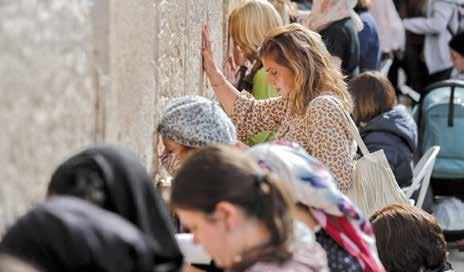
occasion or family visit and some holiday acknowledgment was as far as most celebrated Jewish traditions that we take for granted.
I wondered what had prompted their desire to join their Israel Mission.
“October 7 woke me up.”
My peculiar take on this date, its significance and my thoughts regarding this expression of the date is that the cruelty and horrors of the day present a unique Israel experience in a history filled with terror. The shock, the destruction and the loss coupled with the abduction of so many innocents rocked every person living in Israel to their core.
When referring to that awful day, I hear it called by Anglos and even some Israelis, “October 7.”
Only later, after I got home, did I understand what had bothered me about referring to that day as 10/7; the numerical date in Israel is written as 7/10 –the day is noted before the month. Their expression of the date harkens 9/11 and the comparisons therein; comparing the horrors of both dates is not something I like to ponder.
9/11 marks the point where the mighty giant that is America realized it was vulnerable. Israel has never enjoyed the luxury of tranquility.
After hearing the women’s stories, I asked them what their most significant
Israel experience had been. The touring that the group does is mostly experiential including time spent with families and individuals who have been affected, often traumatized, by the last few years of war and terror.
They all said the same thing: “Friday night at the Kotel, I cried.”
I validated their feelings. I then pointed out that Israel is not a museum where one comes to look, learn and leave. Israel is our homeland, and we desperately need it to survive and flourish. We appreciate every tourist visit, donation, contribution (volunteers), and most of all, the people who take the plunge and make aliyah. I asked that each one of them pledge that they, along with us, are doing everything that can be done to ensure its safe survival.
As part of the conversation, we touched on antisemitism and Jewish identity. I shared a joke that I used to tell my students – it dates me. George Bush (the first) was campaigning in a retirement home. He asked a resident, “Do you know who I am?” “No,” she responded, “but if you go to the desk, they will tell you!”
If we forget that we are Jews, it is guaranteed that there will be someone who will not hesitate to remind us. If we can find any positive outgrowth of October 7, it is that more Jewish people are
identifying more openly. You don’t need big rallies or special educational programs to make a difference in warding off ignorance about Israel and the Jewish people. Ordinary interactions where people of different religions get to share and communicate go a very long way.
One of the special things about my Canadian grandson’s hockey team is that it is composed of a mix of Jewish and non-Jewish athletes. The non-Jews on the team probably would never interact with Jews if not for playing hockey together; the boys on the team play as peers – kids are kids – athletes are athletes. By playing together, they learn about each other and understand each other as people.
Because we have Israel as our center and homeland, we do not have to hide behind our baseball hats and tuck Jewish symbols under our shirts. From time immemorial, the Jewish people have been taunted and chased from continent to continent, country to country.
Never again, no more!
We cannot and will not take Israel for granted. Planeloads of affiliated and unaffiliated must come to visit, tour, spend and volunteer. Momentum has the right idea. We must build upon their mission and expose those who are not familiar with our customs and traditions to become familiar with them.
October 7 taught us a hard lesson: Israel’s security and safety cannot be taken for granted.
Two of the women I met plan to go home and give their kids Hebrew names; it’s a start.
In order to make a difference, we must get out of our comfortable boxes.
Barbara Deutsch is the former associate principal at HANC, middle school principal at Kushner, and Dean of Students at Yeshiva of Flatbush. A not-retired educator, she is trying to figure out life in Israel through reflections on navigating the dream of aliyah as a wife, mother, grandmother, great-grandmother and friend.



By Hershel Lieber
Flemington, NJ
Not very known outside of New Jersey, Flemington played a significant role in my childhood. During the mid-fifties when I was between eight and ten years old, my family rented a bungalow in a colony called Faro’s. I think that this may have been the only colony located in that part of the state. The make-up of the colony’s population was entirely Jewish but most of them were not religious. There were about ten to twelve families that were Orthodox, and they organized a minyan on Friday night and Shabbos morning in which a number of our non-Orthodox friends gladly joined. My memories are vague of that period, but I do remember the casino, where we davened on Shabbos and where Saturday night parties and entertaining shows were held. During the week, that edifice served as the venue for afternoon mahjong games and evening card playing. There was a large pool where I learned how to swim and a barbeque pit where we watched our neighbors roast franks, bake potatoes, and toast marshmallows. Of course, we could not participate in eating their food. What I recall most was exploring the surrounding woods and
nearby streams with the other boys. We would catch salamanders, crickets, butterflies and an occasional turtle. Most

What I recall most was exploringthe surrounding woods and nearby streams with all the boys.


fun was capturing fireflies in a glass jar and watching them light up this pseudo lamp. My brother was still very young and has zero memory of those years.
My father went into New York by bus on Monday morning and returned on Friday. He brought along meat and some of the groceries that we needed. We shopped in the local Acme Supermarket, but kosher products were quite limited.
There was one attraction in the town that I remember well. There was a railroad station with freight trains passing through the town’s center. I recall the excitement I felt as a kid when the whistle blew and the rolling wheels chugged along the tracks. My mother, on the other hand, was attracted to the Stangl Factory where high-quality pottery in a myriad of designs and colors was sold. Our family bought a number of pieces which we cherished for a number of years.
Only seventeen miles from Flemington was the small village of Frenchtown. The town did not mean much to me, if not for the fact that we had family that owned a chicken farm there. Usher Scharf was married to my mother’s first cousin Shifra, and they were in the egg business. They lived on the outskirts of the town where they erected a large chicken coop. The chickens, which laid eggs almost daily, were their employees, and their production was the source of their income.
en farm. I remember quite well joining their two sons, Moshe Yankel and Beinish, a”h, by pitching in throughout every facet of the egg business. We fed the chickens some type of grain feed, refilled their daily water supply, gathered the eggs in wire mesh baskets, and sorted them in a wooden sorting device according to egg size.
I remember that there was a field in back of their farmhouse where corn was growing. I also have a recollection of a lone cow which supplied the family with milk. I even recall the smell of the cow’s manure. Oddly, that odor still retains a nostalgic feeling to me.

We spent the summer before we started going to Faro’s at the chick-
Flemington and Frenchtown, NJ Move the clock forward about fifteen years. In 1968, as newlyweds, I took Pesi for a day trip to show her where I spent my childhood summers. I found Faro’s, the now-abandoned summer colony. The bungalows, the casino, and the large pool were still intact but looked completely dilapidated. I related my childhood experiences to Pesi and was quite sentimental about them. We took a ride on the vintage train of the Black River & Western Railroad, which was powered by a steam locomotive, now a popular tourist attraction. We also visited the Stangl Outlet and bought a hand-painted fruit serving plate and a small black and gold pottery vase which we still occasionally use. We then drove to Frenchtown to see the remains of the farmhouse and chicken coop. All the while we were singing, “Old MacUsh-

Ee - I – O.” We found the farmhouse, but the chickens must have flown the coop because that buidling was gone. Small egg farmers have mostly ceased to exist. My new wife Pesi said afterwards that she was deeply impressed by the sense of sensitivity and sentimentality that I displayed during this visit to my past.
Trenton, NJ
I recall going with Pesi to Trenton in April of 1975. We took an overnight trip to Princeton, and the morning after we took a guided walking tour of the university. On the way back home, we stopped for about two hours in Trenton where we went into the State Capitol Building and visited the NJ State Museum. We then
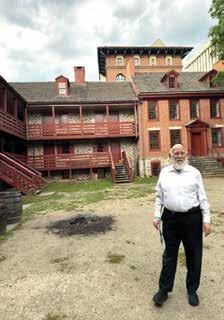
stayed overnight in Lakewood where we ate dinner at Fox Manor. That is the extent of my memory of this trip – very few details.
Fast forward to 2025, almost fifty years to the day. We are now, baruch Hashem, living in the Enclave Senior Community of Lakewood. We are enjoying our comfortable home, the shuls, and the scenic landscape as well as some of our old and newly acquired friends. Yet, I still feel the need to explore the world near and far. We still travel from time to time but less so than in bygone years. Nevertheless, I suggested to Pesi that we take a day trip to somewhere within an hour or two of our home. She agreed but was at loss as to where we should go since we have practically
been everywhere and anyplace within a six-hour drive from home. When I suggested Trenton, she laughed aloud and stated unequivocally that we were there once and that there is hardly anything worth seeing there. I disagreed and told her to trust me and that we would have an enjoyable experience.
On Thursday, May 8, we took a day trip to New Jersey’s state capital. The drive from our home was a little over

an hour, and I had registered to join a guided tour of the State Capitol Building at noon. We arrived on time, found ample parking on the street, and met our guide at the appointed place. We were very lucky that we were the only visitors registered for this tour so we got a very personalized tour of this stately building. The one-hour tour turned into well over an hour, and we were shown the chambers of the NJ State Senate, the NJ General Assembly and the offices of New Jersey’s Governor. Our guide told us that she had the pleasure of leading tours for number of girls’ schools from Lakewood and was impressed with the behavior and manners shown by the frum students. She pointed out the seat of Lakewood’s Assemblyman Avi Schnall and said that she had a number of interactions with him. We captured the regal chambers and graceful dome of the building’s exterior in some of our photos of this trip.
We then headed to the NJ State Museum which is located on the side of the Capitol. The museum specializes in the state’s history and culture but also has sections devoted to art , natural history and archeology. We watched a short presentation at the planetarium. Our
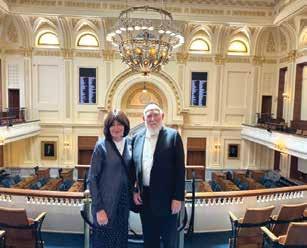
final stop was connected to Trenton’s history both before and during the American Revolution. The Old Barracks
buildings were constructed for British soldiers during the French and Indian Wars, but during the Revolutionary War, it housed British prisoners of war. Later on, it became an army hospital. A costumed guide walked us through the buildings while giving us insight into the significance of this historical monument.
On our drive back to Lakewood, Pesi concurred that we had a delightful day and that there was enough to see in Trenton to make it a worthwhile destination.
Hershel Lieber has been involved in kiruv activities for over 30 years. As a founding member of the Vaad L’Hatzolas Nidchei Yisroel he has traveled with his wife, Pesi, to the Soviet Union during the harsh years of the Communist regimes to advance Yiddishkeit. He has spearheaded a yeshiva in the city of Kishinev that had 12 successful years with many students making Torah their way of life. In Poland, he lectured in the summers at the Ronald S. Lauder Foundation camp for nearly 30 years. He still travels to Warsaw every year – since 1979 – to be the chazzan for Rosh Hashana and Yom Kippur for the Jews there. Together with Pesi, he organized and led trips to Europe on behalf of Gateways and Aish Hatorah for college students finding their paths to Jewish identity. His passion for travel has taken them to many interesting places and afforded them unique experiences. Their open home gave them opportunities to meet and develop relationships with a variety of people. Hershel’s column will appear in The Jewish Home on a bi-weekly basis.



By Eliyahu RosEnBERg
i always say you have to be stubborn to be Jewish. you have to really want it. a person shouldn’t become Jewish if it’s not something they need, if it’s not something that they’re willing to work harder for than anything else in the world. it’s important. it’s a big deal. you don’t become Jewish just because. if you become Jewish, it’s because your soul was at har sinai, and it’s where you belong.
hashem knows what he’s doing. Do i know what he’s doing? no, i don’t know. But i’m thankful that he brought me here. a nd i think the least i can do, and the most i can do, is trust that he knows where he’s taking me next.
hashem wants all of us. he wants every single yid that’s out there, no matter what their status is, no matter what they’ve done, no matter what they haven’t done. no matter how long it takes them to realize that their g-d never forgot them. hashem wants us all. a nd he’s bringing us all home whether we realize it or not.
Nechama Leapley’s childhood was unique in many ways. Growing up in a traditional Christian home, she enjoyed a simple, almost idyllic upbringing. Some of her fondest childhood memories are of playing in the backyard with her siblings, being homeschooled by her mother — simply enjoying the serenity of her isolated world.
“We weren’t exposed to a lot of TV and movies. We didn’t know about Disney. It just wasn’t a part of our lives,” Nechama recalls. “We were always sheltered.”
Nechama’s parents were strong Christians. In her words, they were “seekers,” always on a quest to understand their role in G-d’s plans. So, they would constantly experiment and adopt new customs. As Nechama — or Briana, as she was then known — grew older, her family became progressively conservative, straying further and further away from American norms. They eliminated meat and dairy from their diet; the girls adopted a strict dress code; and, as time went on, her family expanded until she had six younger siblings.
Nechama always felt connected to G-d. She enjoyed her family’s spirituality. But, ironically, it wasn’t her family’s Christian practices that she loved the most — it was their Jewish ones.
“When we moved to Pennsylvania, when I was seven, they started becoming more interested in some Jewish
traditions,” Nechama shares. “Not because they wanted to convert. They’re totally Christian. But there was something about some Jewish traditions that spoke to them. So, they started lighting candles Friday evening, having a Pesach Seder, building a sukkah, lighting Chanukah candles, dressing up on Purim, and other things.
“And for me, it was almost like they threw a match on a bonfire that was inside me just waiting to be lit. I was obsessed with it. I loved it. Everything that had to do with being Jewish or with Israel or anything meant so much to me.”
Nechama recalls crying to her mother at age seven. “Mom, we have to be Jewish! I have to be Jewish. There’s no way I’m not Jewish!” she would say. “Don’t we have Jewish blood anywhere?”
Growing up, the young girl had two treasured possessions: a toy passport her mother made her with a fake stamp for Israel and a Tanach that her father gave her after teaching her how to read Hebrew. She even named the hill behind her house “Mount Zion.”
She didn’t know why she loved Judaism so much, why her face lit up every time her family observed a Jewish custom, or why her heart swelled with pride every time she imagined going to the Holy Land. All the child knew was the following: she had a dream — a dream of becoming Jewish.
But nine years later, when Briana

and her family joined an Amish community, that dream, sadly, was forgotten.
In the winter of 2017, when Briana was 16 years old, her family moved to an Amish community in Kentucky.
“When I was 14, my parents decided to start visiting an Amish community to see if we could move there, because we were so isolated. We were on our own little family island. We didn’t have a whole lot of friends; we didn’t really have fellowship. We were all alone. And they wanted to have more of a community. So, they were looking for a place where we could go,” Nechama recalls, noting that her childhood was still great despite the loneliness. “And they thought the Amish might be the answer, because they liked the plain lifestyle, they liked a lot of the values. And for me, I was a teenager, and I wanted to belong, too. I liked the idea of having a community. I’d always wanted to feel like I belonged somewhere. I grew up feeling alone a lot, but I always wanted friends. So, the idea of possibly having friends was a nice idea.”
There was another part about becoming Amish that excited Briana: the lifestyle. She’d always been an outdoor girl — the sort of person who, instead of using the computer, would spend hours outside watching birds, reading a book, writing, and drawing. The idea of moving to a farm where life is simple, unburdened by modern-day technology, appealed to her.
“I was excited. But I realized that when we moved, we’d have to stop keeping Jewish traditions. I realized that. But I decided — I made myself believe — that I don’t care,” Nechama explains. “Because I wanted to move. I wanted to belong. I wanted to live without technology. So I decided to say, ‘I don’t care. I’ll forget about it. I’ll make myself forget. It doesn’t bother me.’”
At first, the move was an adventure; her new life was interesting. She’d spend
much of her time helping her father grow sweet potatoes, while her mother would tend to the garden and focus on household matters. To have enough food for the winter, they would dry and can excess produce. They would do laundry by hand, scrubbing their clothes in tubs of water and hanging them out to dry. They’d sew all their clothes. Their Amish community had no electricity, heat, or air conditioning. No cars. Not even running water. Showering or bathing was a multi-step process that involved collecting rainwater, heating it on the stove, and mixing it with cold water to make it warm.
Briana found some sort of thrill in the inconveniences. She liked the community, and she even made friends. On paper, everything seemed perfect. And yet, something was gnawing at her. She couldn’t shake the feeling that something was missing in her life. She felt empty. She wasn’t alone, but it sure felt like she was.
“I felt alone. I was always searching for belonging, but I just never felt like I belonged. So yeah, I had a lot of friends. All the girls in the community were my friends. But I don’t know — I still felt alone,” she shares. “I didn’t really have the relationships I wanted, the relationships I needed. I was looking for something I didn’t know how to find.”
That persistent feeling of loneliness — her inability to find a true sense of belonging — eventually led her to consider leaving her Amish community. There were many reasons not to leave: she didn’t want to disappoint her parents, she liked the lifestyle, and, most of all, it was practically all she knew. How could she leave and go out into the real world when she didn’t even know how to do something as simple as making a phone call?
But at age 20, she made a terribly difficult choice and decided that the time had come for her to leave her Amish home and search for a sense of belonging elsewhere.
After leaving the Amish community in November of 2022, Briana moved in with her uncle and aunt in Raleigh, North Carolina, and got her first job soon thereafter. On her first day, she approached the front desk and asked for directions to the room where her job’s orientation was going to be held.
“Go right, go left, take the elevator to the second floor, and then you’ll be in the room,” a secretary told her.
Briana nodded and smiled, pretending to understand the instructions. But there was one problem: she had no idea how to use an elevator.
So, she walked away, too embarrassed to ask for clarification, and stood in front of the elevator doors.
“Hmm, how does this thing open?” she thought. “You know, I’ve seen doors that automatically open when you walk up to them. Maybe the elevator doors work that way, too? Might as well try.”
She walked towards the elevator doors and touched them. But nothing happened.
“The next thing I did was really silly,” Nechama recounts with a laugh. “I walked up to the door and…I knocked on it! Every time I think about that, I always laugh at myself, like, ‘Why did I do that?’ But you know, it’s an instinct. You grow up, a door is closed, you knock on the door, and someone opens it. At that point, I wasn’t even thinking.”
When the knock didn’t work, she scanned her surroundings. That’s when she found a bottom next to the doors.
“Well, what do I have to lose, anyway?” she thought. “Might as well just push the button, and we’ll see what happens.”
She pushed the button and then immediately began panicking.
But then the elevator doors opened, and she calmed down. She walked inside, half-convinced that she’d get trapped in the elevator. While inside, she saw more buttons and correctly assumed that pressing “2” would get her to the second floor. She did just that, and when the doors slid open, she bolted out as if her life depended on it.
“Since then, I’ve gone in elevators a million times. Now, I know how it works,” Nechama chuckles. “Life is a real adventure when you have no idea what you’re doing. I was so clueless.”
Nechama shares the above story to illustrate the culture shock. Going to Raleigh was, in her words, “like moving from Earth to Mars.” Her brain was constantly on overdrive, running a million miles per hour just to process all the things we consider normal parts of living: jumping in a car felt foreign to her, as did walking into a kitchen and turning on a faucet, using a washing machine, or flipping a light switch. Even flushing a toilet felt unbelievably strange to her.
“Going out of the house, going around the city, going shopping, going ice skating, going to the park, going to church — everything was so different,” she shares. “Church was a big building with a lot of music and big crowds. The first time they took me to church in Raleigh, I tried so hard to hold myself together, be okay. But by the end, I was in tears. I was in real physical pain. It was just so much stimulation. When you’re coming from the middle of nowhere off a farm, it’s a lot.
“When we went home, I went up to my room and pulled the covers over my head. I didn’t want to think anymore. I was so done. So tired,” Nechama continues. “There was a long adjustment period: several months of feeling like I was in shock, figuring out how to use a phone, how to shop in a store, how to pay for things with a credit card, how to use a computer. It was a lot of adjustments.”
“Shoot, I probably just set off an alarm in the building somewhere,” she thought, worried that the button was, in fact, intended to be used in emergencies. “Who knows what that button I pushed is for? And everyone’s going to come and wonder what on earth I’m doing, and then they’re going to realize how much I don’t know. They’re going to realize I really am a moron from Mars.”
When the shock left — when she started getting used to her new life — Briana suddenly grew restless. “What am I here for? What am I going to do with my life?” she questioned. She felt like she had to do something more with her life. And so, for a few months, she immersed herself in prayer and contemplation, hoping to find clarity.
And that’s when October 7 happened.
“I wasn’t on the news all the time, so I didn’t realize right away how horrible it was. But I heard bits and pieces, and I knew that Israel was in a really rough spot. I knew they were at war. And I decided to pray for Israel,” Nechama recalls. “So, I was upstairs in my bedroom praying. And all of a sudden, as I was praying, everything just came rushing back to me, everything that I had tried to forget: how much Israel meant to me, how much I wanted to be Jewish, how much I had to be Jewish. And just…everything came back to me.
“I fell on the ground sobbing. I didn’t even know what to do, but I told myself, ‘You know what? Never again. I’m never going to forget again. I’m going to do whatever it takes. I’m going to find Jews. I’m going to get to Israel. I’m going to find Jews if it’s the last thing I do. I have to be Jewish.’
“I don’t even know how to describe it. I can’t describe what it was like. I wish I could. People ask me, ‘What was it that brought you to Judaism?’ I tell them that my parents kept these traditions when I was younger. I tell them that October 7 made a big impression. And people ask, ‘But what was it really?’ And the truth is: I always wanted it. It was inside me. I grew up with a desire to be Jewish since I was a kid. I don’t have

a good logical explanation for it. It just meant the world to me.”
* *
From there, Briana embarked on a quest to find Jews. After doing some research, she discovered that Brooklyn hosts a large Orthodox Jewish population. But she knew that, as a 22-year-old formerly Amish girl, she would never be able to survive in New York City unless the conditions were right. “So, I was looking: can I find a job? Can I find a place to stay? Anything that will get me there so that I can meet people, so I can make connections, so I can have help converting?” she recalls.
She tried researching some more, but to no avail. Eventually, she started losing hope.
“So, I was praying and I said, ‘G-d, you know what? I am totally at the end of my rope here. I’m done. I can’t do this. If You want me to find Jews, You’re going to have to make it happen, because I can’t do it. It’s too hard. I can’t figure this out by myself,’” Nechama shares.
And then, that’s when she found exactly what she’d been looking for: she spotted an ad that said, “Companion wanted for elderly Orthodox Jewish lady living in Flatbush, Brooklyn.” The compensation: free room and board, and enough free time to get a day job.
Instantly, she knew it was the perfect opportunity for her. She called the number on the ad, spoke with the woman’s brother, and soon thereafter, she was hired for the job. In February 2024, after a series of long bus and taxi rides, Briana arrived in Flatbush, her new home. From there, she made connections in the Orthodox community
and worked hard to learn as much about Yiddishkeit as she possibly could.
“I always say you have to be stubborn to be Jewish. You have to really want it,” Nechama says. “A person shouldn’t become Jewish if it’s not something they need, if it’s not something that they’re willing to work harder for than anything else in the world. It’s important. It’s a big deal. You don’t become Jewish just because. If you become Jewish, it’s because your soul was at Har Sinai, and it’s where you belong.”
Around nine months later, on November 18, Briana appeared in front of Beis Din for her final examination. And one month later, on December 18, 2024, she joined the Jewish nation.
This article is based on a podcast, “Inspiration For the Nation,” hosted by Yaakov Langer. To catch more of this conversation, you can watch it on LivingLchaim.com or YouTube.com/LivingLchaim or listen wherever you listen to podcasts (just search for “Inspiration For The Nation”) or call our free hotline: 605-477-2100
She chose the name Nechama because, at the moment she became Jewish, she felt that her soul had finally been comforted.
“Now, I keep thinking of what it’ll be like the moment my feet touch the ground of Eretz Yisrael, and I know it’s Israel. It’s the ground that Hashem gave Avraham and Yitzchak and Yaakov,” Nechama says tearfully, her voice cracking. “It’s home. What is it going to be like to stand on that ground? I’ve dreamed of it for so long. But now it’s actually going to happen. It’s surreal. I can’t believe that it’s actually going to happen. I can’t believe it.
“When you want something so bad and you dream about it for so long, and you wait for it for so long, and then it happens — how do you even describe the emotions?” Nechama asks.
It was, in Nechama’s words, “absolutely the best day of my life.” After she emerged from the mikvah, she couldn’t contain her excitement. “It was literally the best thing that ever happened to me,” she declares. “Finally, I was a Jew. I’d waited so long and wanted it so bad. I had finally come home.”
“I don’t know.”
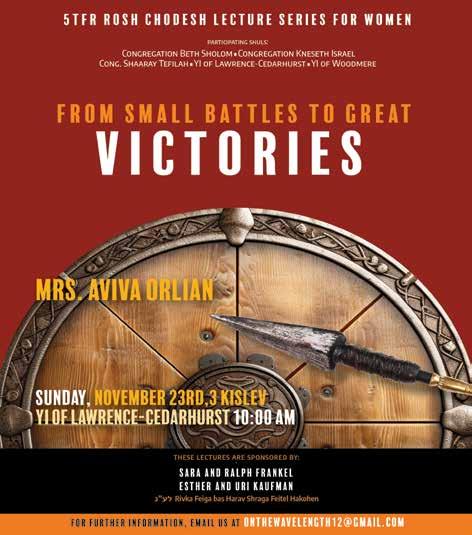
By Susan Schwamm
Rep. Gillen, thank you for taking the time to speak with us. You’ve been in office for almost a year now.
Yes. It is a privilege and honor to serve this district. I feel very fortunate to be able to be a voice for my community, especially at this really difficult time in our nation where we’re seeing such hyper partisanship – to try to be a voice to reach across the aisle, to find compromise and try to redirect my attention and my colleagues’ attention on the problems that are facing Americans that are not ideological problems. They’re bottom-line problems like cost of living issues, combating antisemitism and toning down the hateful rhetoric that we’ve been seeing across our country…
I’m working for the things that can make our lives better, bringing down costs, improving our infrastructure, clean water, safe skies, good education, which is the foundation of a future for all of our children. These are things that should unite us, not divide us, and I’m there working on them while everybody’s looking at images of people in Congress fighting each other. I’m there trying to reach across the aisle. I found a lot of bipartisan compromise in my committees that have been delivering results for the American people. And so, I’m just so grateful to be there.
When you speak to constituents, what primarily is on their minds?
Certainly, the cost of living is on their minds. On the campaign trail, I heard so often that even with the Affordable Care Act, healthcare is not affordable. Whether it’s prescription drugs, the price of premiums, co-pays are going up, deductibles are going up, and quality of your health insurance is going down.
I’m hearing a lot from my Jewish constituents about their fear, first of all, about rising antisemitism in general, and about increasing hatred towards Israel. Now with the mayoral candidate in New York City, Zohran Mamdani, my Jewish constituents and even my non-Jewish constituents are very afraid of what New York City could become like under a person who has expressed antagonistic – at
best views – towards our Jewish community and towards Israel. I think it’s just going to make people more fearful, and I’ve heard people saying they will be more fearful to go into Manhattan, which is a really unfortunate thing. Having a socialist mayor is not going to make things better in the City. It’s going to make it far worse. That’s why I have been so outspoken against Mr. Mamdani right from the start. I was the first Democrat to come out right out of the gate and say he’s the wrong choice for New York City.
Did you get flack for that from your party?
Oh yes, but not from leadership. They understand my point of view. They understand that I have to be an advocate for my constituents, and they understand the sensitivity of this kind of a person being the mayor within my community that I represent. To support Mr. Mamdani would be out of line with my economic principles and out of line with my values.
What could you as a Congressperson do to bring down the cost of living for your constituents?
I’m pushing back against some of these changes to Medicaid right now. I’m working to at least try to get some of those earned income tax credits back with the passing of the Big Beautiful Bill. I’m working to try to bring down energy costs. And I’m pushing back against things like congestion pricing and the recent MTA fare hikes.
I’ve been very vocal. Once again, I’m not afraid to stand up to my own party if I don’t think it’s doing the right thing for the American people and certainly for my constituents.
Speaking of congestion pricing, once Mamdani wins – and it looks like a sure bet – do you think that Governor Hochul will be pushed out of office in the next election?
I make it a practice to not prognosticate about who’s going to win an election, but certainly that’s a very real possibility.
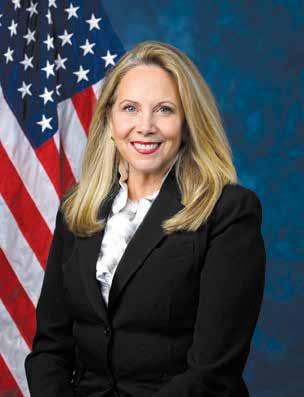
When it comes to cost of living, in our community, paying for our children to go to yeshiva is a big very part of our household budgets. What can you do in Congress to help bring down those costs?
Well, a lot of those tax rebates that people get for yeshiva in other states come out of the state system. However, I believe, across the board, we can and we need to lower costs in education. When I was supervisor of Town of Hempstead, I convened the first ever gathering by any elected official of school superintendents to talk about how they can cost-share to bring down the costs of education just in terms of supplies and things like that because a lot of businesses have successfully done that. I’m actually having a school superintendent symposium today, and I made it a point to make sure that we invited not only our public schools but our religious schools as well – yeshivas and Catholic schools were invited. I wanted to hear directly from the school administrators and educators on what their pain points are and how we can help.
Another thing that I’m very focused on is mental health for our students and finding ways to get federal dollars to get into our school systems to make sure that we are providing the comfort that the students need. We’re seeing a dramatic spike in teenage suicides, which is so heartbreaking. It rips families apart; it rips communities apart. Finding ways to get more resources into schools is something that is a priority of mine.
Do you think that social media contributes to the mental health decline of teenagers?
I am very concerned about that. I have four children –my oldest is 23 and my youngest is 16 – and they’re always
on their phones. You know, you try to take it away from them, but once they get older, it’s harder to take it away from them when they’re adults. My older child is probably one of the first generations that grew up constantly with social media. I wouldn’t let her get her a phone until middle school, and it was like “torture” for her.
I feel that social media is definitely having a negative impact on our children.
What can you, as a congressperson, do about the influence of social media?
Well, certainly one of the things that I focused on – you may recall during my campaign – I had an antisemitism action plan to try to combat antisemitism. One of the points that I talked about doing is having Congress take a more proactive role in terms of forcing social media content providers to look for and to monitor and take away hate speech that incites violence. That is not speech that’s protected by the First Amendment, and we should not see that on social media. I was just reading an article about this 16-year-old kid who was the shooter in the Colorado school shooting, and they said he was radicalized by things he saw on social media, and that’s a pattern that we keep seeing. What we need to do is to find these sites that are turning children into killers and stop that from happening.
Is there legislation out there combatting this?
We have to work on it in a bipartisan fashion because right now I’m in the minority. You need Republican co-sponsors to get anything to the floor. Second of all, I also believe that when you’re doing transformative legislation that could be somewhat controversial, you want to have the buy-in from both sides of the aisle because then it’s more likely to last.
I’m also working on an immigration reform bill, and it’s been introduced and it’s transformative and it’s bipartisan.
What is in that bill?
It’s called the Dignity Act, and there are 10 Republican co-sponsors and 10 Democrat co-sponsors. It’s a very tough but fair and comprehensive plan to reform our immigration system. It secures the border and provides lots of resources to secure our border. It fixes our broken asylum system. Right now, in the asylum system, if you come and put in a claim for asylum, first of all, you’re doing it here, in the United States. Second of all, it could take seven years to adjudicate it. So that means that somebody is sitting here for seven years – which is, if they don’t have a valid claim, they shouldn’t be here. If they do have a valid claim, then they should know and have the confidence that if they’re going to set roots here and become part of the community here. This law envisions having that adjudicated outside the United States and done in months.
The bill also provides a pathway for people who are here who have no criminal background, who have become fabric of our society who are performing jobs and paying taxes. They can have an earned dignity status where they can pay fines or any back taxes, and if they maintain a very clean record for a certain number of years then that would enable them to stay here. We’re not going to get rid of everybody who came here illegally, and it probably would be detrimental to our economy if we did do that. This does not


provide path of citizenship. It provides a pathway to dignity status so that you can lawfully remain in the United States.
County Executive Bruce Blakeman has welcomed ICE into Nassau County. What are your thoughts about that?
I think there should be cooperation and communication between local officials and ICE. Certainly from an informational standpoint, I think it would be much more helpful if our local law enforcement knows where ICE is going to be operating, because there’s a lot of fear in communities out there that people are just being picked up by ICE. I do have concerns because I’m hearing some scary stories like someone from our district who is an American citizen who was picked up and deported. I’m looking into that and getting the facts of it, but there have been some incidents that have gone wrong.
You spoke about your dignity bill and mentioned that you have 10 Republicans and 10 Democrats co-sponsoring the bill. Congress is so divided now. How do you work across the aisle? What’s your trick for doing that?
For freshman orientation, they have the Democrats and the Republicans come down to Washington to learn the ropes. We went on our separate buses and did separate things sometimes, but we did have some bipartisan events. I really made it a point to try to not necessarily sit and seek out Democrats because on the floor of the House, Democrats kind of sit on one side and Republicans kind of sit on the other side. I feared that I could be put into my little Democrat box and I wouldn’t have as much opportunity to get to know my Republican colleagues. So I really made a point to sit down and get to know them in orientation. For example, I got to know a congressman from Florida, Mike Haridopolis. Turns out, he grew up in Garden City – in my district – and we’re both on the space subcommittee together and because he now represents a district that has Cape Canaveral in it.
I tried to make those relationships then and then I deliberately selected committees that are known to be more bipartisan. I’m on Transportation and Infrastructure, which also has a tremendous connection to my district because we have trains, planes, and automobiles here. It’s a big district where transportation is very important in terms of all infrastructure, clean water, and all of those other modes of transportation that we have to regulate here.
I joke that on my very first committee hearing ever, we were talking about infrastructure dollars and making sure that the infrastructure dollars that came out of the Biden
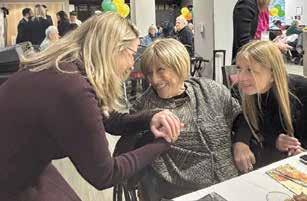
administration keep going. I had the governor of Louisiana testifying before me, and during a break, I went up to him and I talked to him about how I’d been in Baton Rouge recently and I knew what he was talking about how he needs more bridges and I was like, I know I’m a Democrat but I’m going to fight for you to keep your money so you can get more bridges. I know the problem. I’ve witnessed it firsthand. He invited me to the governor’s mansion – and this is like one of the staunchest Republicans. Meanwhile, at the same time, in oversight committee, Nancy Mace and Jasmine Crockett were challenging each other to a fist-fight in the hallway. That’s what makes the TV cameras, because it’s dramatic. People complimenting each other and working together is not, as you know, as exciting for TV, but there is bipartisan compromise going on in Washington.
In Transportation and Infrastructure, we recently passed a bill to rescue FEMA. I really complimented my Republican colleagues because the president was kind of down on FEMA, but they saw the critical importance it plays when we face storms like we just saw in Texas. We worked together in a bipartisan fashion and passed a wholly bipartisan bill.
There are Republicans and Democrats who respect each other, who say hello to each other, who behave in a grown-up fashion, and who actually want to solve the problems that the American people need us to solve. I’m one of those people, and I’m looking forward to continuing to be that voice for my constituents.
Do you think that the Democratic Party has become a little too extreme?
I think that the image of the Democratic Party has been a little bit hijacked by the left, which does not represent the majority of Democrats. I also think that some of our
Republican-leaning news outlets like to try to extrapolate that this is the new Democratic Party and that Zohran Mamdani is the face of the Democratic Party. I would say absolutely not. Our party, the Democratic Party, needs to lead from the middle, because that’s where the majority of Americans are. New York City is a little, tiny bubble. It is not representative of where the rest of the country is, and I think that there are very strong moderate voices in our party. They’re not as sensational as some of the far-left voices in our party, but I do not believe that’s the direction our party should go in.
When I came out loudly and strongly right out of the gate against Zohran Mamdani, so many of my colleagues in the House agreed with me and told me that they were so glad that I said that. They’re not from New York so they’re not weighing in, but they were agreeing with my sentiments.
You were in Israel in the summer. Can you tell us about your trip?
AIEF sponsored the trip, and there were a Democrat and a Republican delegation that went. Our delegation overlapped over 3-4 days. Most of the time we did separate things, but other times, we went together. The trip was long and intense – around 10-11 days long. It was a mission. It was a very important time for me to go, and I am so happy that I went.
We listened, we met with President Herzog, we met with the prime minister, we met with the opposition leader, Lapid, and we also met with the Prime Minister of the Palestinian Authority in Ramallah and some of his deputies. The Republican delegation may have focused more on corporate meetings. We focused on meeting with aid organizations to try to get to the truth about what is really happening in terms of aid. It was very important for us to do that.
It was really important for me to dispel some misinformation that’s out there. There’s plenty of aid that is trying to be brought into Gaza. We met with the UN World Food Program, with UJA and with Cogat. There was some finger pointing among the different groups, but there certainly was some universal agreement – that it’s extremely difficult to get aid into Gaza because it’s a war zone.
I learned that there’s an underground network of tunnels in Gaza which is longer than the New York City subway system and the London Tube put together. When I saw a map with the entry points of Hamas from October 7, I was shocked by how extensive this tunnel system is. If you don’t dismantle that, they’ll be back. And if you don’t remove Hamas from power, they’ll be back and they’ll do it all over again as soon as they’re reconstituted.
It was important for us to get to see firsthand and to speak with people directly about what was going on there.
It’s also really important to be reminded – what people seem to be forgetting about – is what happened on October 7. We went to Kibbutz Nir Oz and heard from a survivor about the stories about what happened to her family; both of her in-laws were taken hostages. Her father-in-law was killed; her mother-in-law was released. Her neighbors and all their children were murdered. Women were assaulted; people were holding the door for 12 hours to try to save their families. The whole kibbutz was mostly destroyed, but they’re coming back now and they’re rebuilding. The
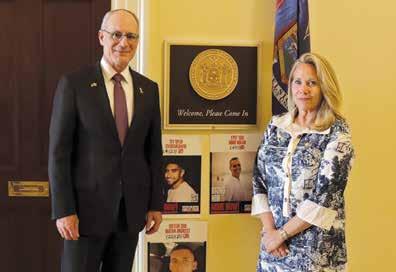

resiliency and the courage of those folks was really inspiring. But we can’t forget the stories about what happened. This war was started and all the suffering that’s going on in Israel and is going on in Gaza is because of one entity and that entity is Hamas. This was an unprovoked, brutal, savage, vicious, inhumane attack on innocent people, innocent children at a music festival. And that’s why everyone is suffering – because of Hamas. People who support Hamas should not be tolerated. If you endorse Hamas, then you endorse terror and violence, and that’s disgusting.
“I’m not afraid to stand up to my own party if I don’t think it’s doing the right thing for the American people and certainly for my constituents.”
Should there be a two-state solution?
I’ve always been an advocate for a two-state solution. I think it’s become a little bit more challenging right now because I’m concerned about the deep divide that has been caused by this conflict. I do think that a two-state solution is probably the way towards peace, but I think it’ll take a lot of healing to get there.
Just recently, our nation was shocked when they heard about the assassination of Charlie Kirk. What are your thoughts on that?
It was horrible. When I heard about it, I just felt sick. My 16-year-old daughter was in school, and she texted me about it and she was all upset about it because everybody at school was talking about it. It’s tragic that we’re at such a state in our country where disagreement about politics could lead to violence. We should not be in this place. I grew up in a household where my mother is a Democrat, my father is a Republican. I was married to a Republican. We could disagree on things and not hate each other, and that’s the way it should be because there are good sides on both sides of the aisle. No one party has the monopoly on good approaches to problems. But we have become so divided
in this nation, and it’s causing really, really dangerous and horrible results for our country. I would never wish harm on someone who disagrees with me.
Should there be policing on hate speech?
I think any speech that incites violence is not protected speech, and we should not let it flow freely on social media.
What do you do to relax?
I spend time with my family. You know, my kids don’t care that I’m in Congress. They want me to help make their lunch if I’m home, to take them shopping, do their laundry.
How do you balance being a mom and then needing to be in D.C. for days at a time?
Two of my children are out of school and have graduated from college. If my children were younger, I wouldn’t have been able to do this job. My third child is in college, and he is near me now in D.C. so I get to see him. My youngest is in high school. I make sure I’m home every weekend so I can see her. I have her field hockey schedule in my calendar, and so when I’m home, we prioritize getting to her games. When she’s in lacrosse season, I’ll prioritize getting to her lacrosse games. She plays three sports and is very active, so even if I’m home, she’s always out and about. As a family, we found a way to make it balanced.
This congressional seat has filled by a female for many years. Rep. Anthony D’Esposito took over for a short time, but before him, Kathleen Rice and Carolyn McCarthy were representatives for this district. How does being a female help you fulfill your role?
I think that women bring an important voice to the table generally because those “kitchen table” issues are issues that we experience every single day. I think more than some of our male counterparts, even as a working mother, a woman is the one who is more focused on homework and learning and making sure there is food in the refrigerator for the family to have for lunch. We go grocery shopping and see our bills going up.
I also think that sometimes when things get heated, we know how to help work things out. I had to break up fights with my kids. We can just take a deep breath and take down the temperature and try to be a bridge to try to find that bipartisan compromise.

Moderated by Jennifer Mann, LCSW of The Navidaters

Dear Navidaters,
Love your column, thanks for all you do!
It seems like with the new “shidduch lounge” initiative, there are lots of events popping up with mixed crowds— men, women, and shadchanim all in one place. With that said, what’s the proper etiquette for approaching a guy in such a setting where there isn’t as much structured facilitation? I grew up talking to guys, so this is a very natural thing for me. I don’t want to end up looking like I’m being in any way inappropriate by being too friendly, but I don’t want to come across boring either. What are your guidelines?
Thanks!
Malka*
Dear Readers,
We want to offer YOU an opportunity to be part of the discussion! Please email us at MichelleMondShadchan@gmail.com, subject line “reader’s response,” if you would like to participate in the new “A Reader’s Response” columnist spot. We will send you a question and publish your answer in an upcoming Navidaters edition.
If you have a question you would like the Navidaters to answer, please reach out to this email as well.
Looking forward!
Michelle, the “Shadchan”
Rebbetzin Faigie Horowitz, M.S.
Malka, be yourself. Use openers that are comfortable for you and that you regularly use.
It sounds like you are a little nervous about the setup and the newness of the initiative. The shadchanim who have worked on bringing this to fruition are largely good, caring, local women who are seasoned and I know personally. They are also up-to-date and understand the current environment for daters. They will be very approachable if you need a little reassurance and support. They have been working on shidduchim for community young people in various formats for years. They are trusted by people in the Five Towns. Trust them and trust your own skills.
Michelle Mond
Ilove this new initiative, and I love your question! It’s always important to make the best first impression. You sound like a friendly girl who’s comfortable in this type of environment. You’re just scared to put yourself out there in that way due to perceived judgements.
I assure you though, as long as you are being socially appropriate, friendly, and aware of boundaries, you will do great! Your personality is exactly why it’s great that this shidduch lounge exists. Personality doesn’t shine on a resume; it’s a piece of paper and falls flat. When someone meets you, they will see your excitement for life and bubbly demeanor. Most guys will find this a breath of fresh air.
I will also outline a few things to keep in mind when going to these types of events. Be mindful of the cues the other person is giving off. If the person you are talking to looks at his watch or keeps looking away, it might be time to appropriately cut the conversation to an end. Try not to interrupt others’ conversations just because you want to speak to a person. Be mindful of nervous laughter and try to be as down-to-earth and calm as possible. Watch the energy you’re exuding. People pick up on anxious vibes and don’t like it. Being positive/genuine is the name of the game, and the right guy will pick up on this.
Hatzlacha!
Dr. Jeffrey Galler
This new initiative is a breath of fresh air. It is long overdue, and I hope it spreads to many other communities.
The quick and easy answer to your question is YES! You can simply go over to anyone you’d like to meet and introduce yourself. That is the purpose of these relaxed and wholesome Motzei Shabbos events. Of course, if you, or anyone, is a bit shy, there are always facilitators and shadchanim present,who would gladly make the introduction for you.
For readers who are unaware, there is a new project, called The Shidduch Lounge of the 5 Towns. I urge all interested singles to visit their website (shidduchlounge.com).
Their stated goal and mission is to create a “warm, relaxed, and thoughtfully curated environment where singles can meet both shadchanim and one another naturally, with games, great food, and music.”
Their mission statement speaks for itself:
*We believe that meaningful rela-
Personality doesn’t shine on a resume; it’s a piece of paper and falls flat.
tionships are built best when people are given the right setting – one that reflects Torah values and allows each person’s personality to come through in a genuine way.
*Our events are thoughtfully designed to bring together singles with shared backgrounds and hashkafic outlooks, providing a comfortable pressure-free atmosphere where both shad

chanim and participants can connect with ease.”
How wonderful! G-d bless the visionaries behind this project. We encourage singles to explore it and to participate in the available programs.
The Singles’ Perspectives Rivki D.
Dear Malka,
When approaching a guy at one of these events, prioritize respect, genuine interest, and awareness of his social cues. Start by going over with a friendly smile and introducing yourself. Keeping
the conversation light – find some common interests to get a feel for his vibe. Balance a warm smile (avoid over-smiling because that’s creepy) with relaxed, approachable body language. Pay close attention to the guy’s social cues, and if he seems uninterested or uncomfortable be sure not to push him too far. Keep a slightly mysterious air by sharing just enough about yourself without being overbearing.
Most importantly, be yourself! People are naturally attracted to authenticity. Good luck!
to guys is a real strength. Not everyone has that. You have an easy, warm way of starting a conversation, and that puts people at ease. In a room full of singles who are overthinking every hello, that is a gift.
So keep being yourself. As long as you stay respectful and genuine, nothing about your approach is inappropriate. In fact, it is probably the thing that will help the right guy notice you.
You don’t have to choose between being appropriate and being authentic.
DJ Kasriel
Dear Malka,
Your natural comfort talking
Navidaters
Dating and Relationship Coaches and Therapists
Dear Malka, I love this question because it hits on something I see all the time — not just at events, but in my office. Beautiful, warm, normal people who suddenly don’t know how to be themselves because the system has conditioned them to second-guess every move, every smile, every instinct. And it breaks my heart, because the biggest casualty of the shidduch world is often a person’s relationship with their own authenticity.
So let me say this clearly, gently, and with all the love in the world: you are not doing anything wrong by being yourself.
These new Shidduch Lounge events
are wonderful, but they may come with this unspoken pressure:
Don’t be too friendly.
Don’t be boring.
Don’t be forward.
Don’t be invisible.
It’s exhausting. And it puts people into these tiny, airless boxes when all they really want is to be human.
You asked for guidelines, so here are mine — and they’re simple:
1. If something comes naturally to you, trust that.
You grew up talking comfortably to
And here’s the funny part. If you start second-guessing your own approach, you’ll end up acting just like the other guys and girls in the room who are also nervous. They are so busy worrying about how they come across that they won’t even notice whatever you’re concerned about. Fear makes everyone blend together. Confidence helps you stand out.
There is absolutely nothing wrong with having experience talking to boys. It puts you ahead in social comfort. Walk in, smile, start a simple conversation, and let your personality do the rest. Light and friendly is more than enough. Be yourself. That is exactly what will attract the right person.
guys. Wonderful. That’s a strength, not a liability. Say hello. Ask a simple question. Make a comment about the event. Be warm. Be yourself.
That’s not forward. That’s not inappropriate.
That’s called being a person.
2. You are allowed to show up as the fullest version of you.
Not the “shidduch-approved” version.
Not the watered-down version.
Not the quiet, careful, “please-don’tjudge-me” version.
Just you.
Because the right person is going to be drawn to that — not to a character you play for twenty minutes in a crowded lounge.
3. Watch for whether he meets you where you are.
If a guy is interested, he’ll lean in, smile, ask you something back.
If he doesn’t, that’s not a rejection — that’s clarity.
Either way, you stay you.
4. Please don’t shrink yourself to fit an imaginary rulebook.
Most of that rulebook is fear-based and nobody is actually happy following it.
And finally…
5. People don’t regret being themselves.
They regret the moments they hid. They regret the times they played small.
They regret the years they spent thinking something was wrong with them when really… the system didn’t leave them room to breathe.
Malka, you don’t have to choose between being appropriate and being authentic. You can be friendly, warm, respectful, and still be you. And that’s who someone is going to fall in love with.
Sincerely, Jennifer


By Mordechai Schmutter

Ifeel like when I was a kid, you had one doctor. It was a pediatrician, and he handled everything that could possibly come up. The only thing pediatricians couldn’t handle was teeth.
That was it; it was very delineated. If you had a medical issue, you weren’t like, “I’m not sure – should I show this to my pediatrician or my dentist?”
But that is how it works as an adult; every doctor has a specialty. And the specialties kind of run into each other. There’s a skin doctor and a foot doctor and a blood doctor, and okay, they specialize in different things, but which doctor do you call if you have a thing on the skin of your foot and it’s bleeding? Or do you call all three? What if there’s a machlokes?
I need this like I need a hole in my foot. I actually have a hole in my foot. In both feet. They’re more like craters. The doctors are calling them ulcers, but I don’t like that term, because when I tell people I have ulcers on my feet, they say, “Alka-Seltzer!”
I’m not soaking my feet in Alka-Seltzer. They started off small. Then I wondered, “Are they growing?” So I started taking pictures periodically, which had a nice side effect of keeping my kids from scrolling too far through the photos on my phone.
The pictures are disgusting. They’re the kind of picture that when you look at it, you close your eyes halfway to not allow the entire picture to reach your eyeballs.
My wife told me to send them to my doctor, possibly so I’d stop constantly showing them to her.
My doctor is part of this huge practice that has this medical portal that instead of coming in, you can just send them questions and then they tell you to come in. This is an incredible timesaver, because they get to look up the answers before you get there, rather than making up some reason to leave the room and then looking things up, like they used to.
So I went on the portal, and I clicked “attach,” and it said, “Please refrain from uploading any photographs of a sensitive nature.”
They’re all of a sensitive nature! Why would I send my doctor pictures that are not of a sensitive nature?
“The ulcers really hurt. Here’s a picture of my face in pain.”
I bet there’s not a single picture in the entire portal that someone who’s not a doctor would ever want to look at.
Then I had to figure out which doctor to send it to. I don’t know whether this qualifies as a skin issue or a foot issue, so I figured I’d leave this choice up to my PCP. The way it works is you have a main doctor, and if you don’t know what’s wrong with you, you go to this doctor. Then he helps you decide what kind of doctor you need. His specialty is that he knows all the different types of doctors.
So my PCP looked at the pictures
through half-closed eyes and told me to come in. I come in, and he says, “Here’s an antibiotic and a cream. I’m sending you to a dermatologist.”
I’m like, “You can only say that to me if I come in?”
So he pulled out a Q-tip and took a COVID test of my ankle.
The next day I go to the dermatologist, and she says, “We’re going to do a biopsy.”
A biopsy?
“We’re going to make two holes inside your existing hole.”
Two holes. Hence the bi in biopsy, I think.
“Then we’re going to leave you with vague care instructions, and we’ll call you in a couple of days, after we hear back from the lab.”
Something this dermatologist said made me think that I should call my second doctor. Yes, I have a second doctor, for some medical issue that I have yet to talk about in a humor column. I don’t tell you guys everything. This one is a blood doctor. And it’s the worst. If you go to a foot doctor, they look at your foot. Every time you go to a blood doctor, they have to take blood. How else can they look at it? Every time. He sends me for blood tests days before I come in, and then I come in again and we talk about it.
So I contacted this hematologist through the portal, and he calls me back in a panic. And he says, “This might be a side
effect of one of the medications I’ve had you on for the past four years.”
That was a relief, if he was right, because if this was caused by a medication, that was easily fixable.
A day later, my PCP sends me results from the swab test, which basically say, “I’m not sure what it is, but it’s bacterial, and it should respond to the antibiotic I gave you.”
Great.
Now I’m waiting on results from the biopsy.
Anyway, like four or five days later, the dermatologist sends me a results chart I can’t decipher. A few days later, she sends me more results. With zero notes. And zero phone calls.
And in the meantime, I’m waiting for either of these doctors to say, “You know what? It’s because of this medication!”
Finally, after 10 days, they send me a result that looks a lot like what the PCP had sent me from his painless cotton-swab test after two days, wherein the PCP wrote that this was bacterial and that the antibiotic should work.
But at least there’s a consensus: The antibiotics should work.
Anyway, I finished the antibiotics, and they didn’t work.
So I sent an email to both of my regular doctors saying that I’ve finished the antibiotic, I still haven’t heard back from the dermatologist, and here’s a current picture
of a sensitive nature; is this getting better or worse? Because for all I know this is how it gets better – first it looks way worse... It’s like making an omelet. I don’t want to describe the picture, but it does kind of look like an egg on the way to making an omelet.
Anyway, that day, someone from the dermatologist’s office called me back – coincidentally – and said, “Okay, it’s bacterial, and you should take the antibiotic your PCP prescribed. In case you didn’t see the messages.” And I said, “Oh! Thank you! So first of all, I’m finished taking the antibiotic...”
“Then it should work!”
“Well, you can tell me if it worked... I put some pictures on the portal!”
Then there was a pause, and I heard her say, “Oh my goodness! I’ll call you back.”
I’m still waiting for her to call me back. But she did send me the same results in the actual mail days later. In case I didn’t get the phone call.
Meanwhile, my PCP writes me back – in response to the email in which I said I was still waiting to hear back from the dermatologist about whether the medication the PCP prescribed two weeks earlier should work – and said, “Should I prescribe another dermatologist?”
“Um…no?”
“We have other dermatologists. Should I refer you to Dr. Presto?”
“If Dr. Presto is actually magic, then maybe.”
Then the hematologist calls me and says, “Number one, we have to put you on more antibiotics. Number two, have you seen a podiatrist?”
can see them.
So I went to the podiatrist, and he said, “I don’t know what this is, but here’s a prescription for a cream that costs $300.”
And everyone asks, “Wasn’t it covered by insurance?”
It is. It’s normally $900.
“Wow! What does it do?”
Every time you go to a blood doctor, they have to take blood.
How else can they look at it?
“Recently or ever?”
“Do you have a podiatrist?”
“Not as part of your practice.”
For this, I wanted someone who was part of the practice. I like the idea that I have a team of doctors, and they could all put their heads together and trip over each other and apparently not communicate at all or work as a team, but at least when I put pictures on the portal, anyone

It cleans things up so it no longer looks as much like an egg.
I actually forgot to bring band-aids to wrap up afterward, but I figured, “It’s a doctor’s office. He probably has band-aids.”
He did not. Instead, he had the nurse wrap me in 85 feet of gauze tape so my feet no longer fit into my slippers. And it was the new, fancy kind of tape that sticks to itself. And also to the floor of the office.
And the gas pedal of my car.
The other thing he did was send me to a wound-care specialist.
Yes, apparently this is a specialty. So the other doctors can say, “What do you think we are? We don’t know how to deal with wounds!”
Clearly. You gave me 85 feet of gauze.
But yeah, let’s loop a fifth doctor in on this. Who isn’t part of this practice. It’s in a hospital.
Why does this huge practice that has 12 doctors for me alone not have a wound care department?
Then I come home, and my son asks, “Why don’t you just go to the best doctors?”
“Because we’re not living in a Pirchei story! You think I could just Google, ‘Best doctors’ and they’ll see me?”
But I mean at least a doctor who doesn’t put tape on your feet that sticks to his floors.
Mordechai Schmutter is a freelance writer and a humor columnist for Hamodia and other magazines. He has also published eight books and does stand-up comedy. He can be contacted at mschmutter@gmail.com.

By Dr. Aliza Goldstein
Choosing a spouse can be a frightening prospect. Questions like “How do I know if they’re the one?” or “What if I make the wrong choice?” are natural because committing to a life partner is one of the most life-altering decisions, with no guarantees. For some, though, this normal unease becomes overwhelming, trapping them in endless loops of doubt that prevent them from fully engaging or moving forward.
A certain amount of anxiety, or “cold feet,” is a normal and healthy part of decision-making in dating. It reflects care, responsibility, and awareness of the stakes involved. However, when the anxiety becomes distressing, time-consuming, and interferes with one’s ability to connect, commit, or fully engage in a relationship, it may be a sign of Obsessive-Compulsive Disorder (OCD), specifically a form known as Relationship OCD (ROCD).
Relationship OCD
OCD causes unwanted, intrusive thoughts (obsessions) and repetitive behaviors (compulsions) aimed at easing anxiety or gaining certainty. Unfortunately, these compulsions only offer short-term relief and often worsen the problem over time.
ROCD centers on obsessive doubts about one’s partner or the relationship. Common questions include: Am I truly in love? Is this how I should feel? What if there’s someone better? The mind demands impossible certainty.
To quiet the anxiety, people may repeatedly analyze interactions or compare relationships, seek reassurance from friends, rabbis, or online forums, make endless “pros and cons” lists, or end relationships prematurely to escape the doubt.
Some of these behaviors happen only in the mind. People might replay conver-
sations, test their feelings over and over, or mentally compare their partner to others in search of certainty. From the outside, this can look like normal overthinking, but it is actually a form of compulsion that keeps the anxiety cycle going. These mental loops may bring brief relief, yet the doubt always returns, making it harder to be present and to truly experience the relationship.
Here’s how ROCD might look like in the frum community:
Yaakov is a 26-year-old frum man who’s been dating Rivky for several months. Objectively, Rivky shares his values, is kind, and they enjoy spending time together. However, as the possibility of engagement becomes real, Yaakov finds himself tormented by intrusive “what if” thoughts: “What if I’m making a huge mistake? What if there’s someone I’ll connect with more deeply?” He constantly reviews their conversations in his mind, searching for a moment that will confirm she’s “the one” and frequently asks his rebbe and close friends for reassurance. Each time he feels a wave of clarity, the doubts creep back in, making him question even more. Yaakov notices these worries take up hours and make it hard for him to be present or enjoy dating. He fears leading Rivky on, yet can’t seem to feel certain enough to move forward.

lead to lasting, loving marriages.
2. Accept Imperfection in Yourself and in Your Partner
People with ROCD often hold perfectionistic expectations: the perfect partner, the perfect emotional state, the perfect love story. In reality, healthy love includes moments of boredom, irritation, and even doubt. Feelings ebb and flow, but that does not mean the relationship is wrong.
Infatuation fades as love matures into something steadier and more complex. That shift is not failure; it is growth.
3. Shift from Compulsions to Values
ROCD sufferers often think, What if my doubts mean I am in the wrong relationship? Unfortunately, there is no test for certainty. What matters more is how you respond to the doubt. If you are chasing constant reassurance, that is likely the OCD talking.
Rather than solving every “what if,” focus on what truly matters:
• What qualities are most important in a partner?
• What kind of life do I want to build together?
• Are there genuine red flags, such as dishonesty or disrespect, or am I chasing an unrealistic sense of perfect comfort?
seek reassurance, the more present you can be. That is how you actually gather real-world information about your relationship: not through rumination, but through experience.
When
If your worries feel impossible to shut off or are keeping you from enjoying your relationship, it may be time to reach out for professional help. Early support can make it easier to change these patterns before they take hold.
Therapy for OCD, including Relationship OCD, focuses on learning new ways to respond to intrusive thoughts and anxiety. The most effective treatment is called Exposure and Response Prevention (ERP), a specialized form of cognitive-behavioral therapy that helps people face uncertainty and reduce compulsive behaviors. Acceptance and Commitment Therapy (ACT) can also help individuals reconnect with their core values and live meaningfully alongside doubt, rather than trying to eliminate it entirely.
How to Cope with RelationshipThemed
Dating
1. Let Go of the Myth of Certainty
If you find yourself overwhelmed by “what ifs,” remember that nobody has absolute certainty that they are marrying the right person. Certainty is not a fact; it is a feeling that fluctuates. Some people feel sure early on, while others never have a lightning-bolt moment, and that can still
If there are true red flags, such as dishonesty or disrespect, those should never be ignored. But if the discomfort comes from chasing perfect certainty or perfect feelings, that may be anxiety rather than intuition. Choosing a partner and moving forward in the relationship according to your values is far more important than trying to achieve absolute certainty.
When your mind is busy analyzing, it is hard to experience connection. The more you resist the urge to check, compare, or
If you are not sure whether what you are experiencing is OCD, or if anxiety is preventing you from moving forward with someone who may be a wonderful match, specialized care can make all the difference. You deserve a relationship built on connection and presence, not fear and doubt.
Remember that doubt is part of being human. The goal is not to eliminate uncertainty but to live meaningfully alongside it.
Dr. Aliza Goldstein is a clinical psychologist and the director of Anxiety Care NY, a private practice specializing in OCD, anxiety, and relationship-related concerns. She sees patients in her office in Rockville Centre or virtually anywhere in New York and New Jersey.
By Sara Rayvych, MSEd
Every age and stage has their own unique dynamics. There are challenges but also lots of joy and fun in each one. While adults of all different ages can be on similar ground, with children, even a few months can make a major difference.
When writing articles, I often have to stress how these age differences and cognitive milestones will affect parenting. Afterall, an eight-year-old isn’t a tenyear-old, nor is a ten-year-old a fourteenyear-old. Even while writing about some of the unique challenges of each age, I often have to take into account a very special sub group: toddlers and preschoolers. This is a relatively wide age range, but it still has unique characteristics.
As we know from babies, they change quickly. Newborns grow by the day, and a three-week-old is relatively far more advanced than a one-week-old. The younger they are, the more pronounced and dramatic the difference. Toddlers and preschoolers are developmentally much younger than school-aged children, and we often can’t apply regular behavioral techniques with them.
This age group is adorable, and their antics keep us busy all day. Even as I write about the different developmental milestones, I feel like I rarely do justice to this age group. Understanding the unique needs and challenges of this age category can assist parents in dealing with the many daily situations that arise.
This age is busy. They always have something to do, and parents know to be concerned when the house is suddenly “too quiet.” Many parents have wished they could bottle some of that energy for themselves. Sadly for us, that superpower of energy belongs exclusively to them. This constant level of activity can be overwhelming for adults. Parents may feel like they’re always chasing, cleaning
up after or saving their little one from dangerous behavior. It probably feels like that for parents because it is true. We are continuously on the job with this age. Unless they’re sleeping, we are on alert. This is developmentally appropriate. It can be frustrating and overwhelming, but it’s normal and healthy.
It can be tempting to put away each item as it’s removed, but it’s often going to be played with again soon afterwards. In many cases, it’s easier to do set clean ups during or after the day, rather than continuously chasing and cleaning after a moving, dirtying target.
Toddlers’ attention spans are short, as is their memory. This adds a challenge to many areas, such as discipline and conversation.
Children of this age do not remember what they did earlier. It’s relatively useless to try disciplining them unless it’s done immediately after the event. With even a minimal delay they are unable to connect their adult’s current message of chinuch to the behavior of minutes prior.
It’s important to communicate with children effectively. This age category does not have the ability to focus for a long shmooze, and they’re lost after the first few words. While always wise to think before speaking, it’s even more crucial with little ones who are so limited.
When speaking with such little kids we need to keep the conversation on their level and not too sophisticated for their development. Concepts that seem simple to us may still be advanced for such youngsters. Young kids lack impulse control. They see it, and they do it. There is little time to think between “see” and “do.” It’s unreasonable to expect them to control themselves in any given situation. In other words, don’t leave the cookies in front of them if you don’t want them eaten. Also, the distance from sidewalk to street is very short. Hold

their hands and keep a close watch. They are sweet and well-intentioned. When we say to them, “Will you clean up after your snack?” they will honestly respond, “Yes.” When they gave you that “yes,” they may have had every intention of fulfilling it. The problem is the delay between their “yes” and the expected action. This is an unrealistic expectation for this age group. It’s better to say, “Let’s clean up quickly, and then you’ll have your snack.”
Humans start off as concrete thinkers. If I see it, then it exists. A common example is object permanence. This is the understanding that something exists even when it’s no longer visible. Infants are tested for this by showing them an exciting toy and then hiding it from their view to see if they still search for it. If they continue to look for the hidden item, then we know they understand object permanence. It’s considered a milestone when infants attain this level of understanding. As adults, we readily know objects exist outside of our view, and there is a functioning world of people and places we’ve never seen.
Adults routinely think abstractly. We can think of future events and that food we dislike can remain on our plate and not be thrown on the floor. As frum Jews, this is a constant part of our day. We know Hashem exists even without a physical body. Shabbos is inherently different from a weekday. A sefer Torah is not mere parchment. We are so used to abstract thinking that we often forget how advanced certain concepts are. When speaking with young children, we need to be mindful of how a child will process the conversation. A common but basic example is when children ask when something will happen. We might give a seemingly reasonable answer such as “two weeks.” Two weeks is simple for us,
but meaningless to a very young child. Saying “after two more Shabboses” or counting the days on a calendar with them will still be somewhat abstract yet more concrete than sticking with “two weeks.”
Little kids have feelings too, and we need to be mindful to not laugh at or embarrass them. Teasing that may seem benign to us can still be upsetting to them. Sometimes, they can even get upset over something nice we said. Their lesser understanding of verbal and body language can unintentionally cause hurtful feelings. We need to be mindful of their responses and use simpler language and clarify our words when they don’t understand us correctly.
Parents can easily be so overwhelmed that they forget to enjoy their little one. Kids in this stage are at an incredibly sweet and innocent age. Their immaturity naturally results in the funniest of comments and antics. It’s such a shame that we can be so busy we forget to take a few minutes to enjoy what we’re doing, who we’re with, and shep a little nachas.
Taking some time to just have fun together can go a long way towards parent-child bonding and adding some happiness into our active adult lives. They keep us busy, often wishing we could harness their energy for our own use, but they make us smile and give the best hugs.
Sara Rayvych, MSEd, holds a master’s degree in general and special education. She has been homeschooling for over 15 years. Sara provides personalized parent mentoring services, addressing a variety of general and specific parenting concerns. She can be contacted at Sara.Rayvych@gmail.com with comments, questions or for private consultations.
By Etti Siegel

Q:Dear Etti,
What should a parent do when their teen comes home upset because “everyone” has a certain scrunchie/sweater/ socks/shoes/backpack… whatever the must-have item of the month is?
How can I help my child feel comfortable with who she is without either lecturing her about peer pressure or caving in and buying every trendy item? I want her to be confident in herself, but the pressure to fit in feels so real to her.
Signed, - Confused About Conformity
A:Dear Confused, Ah, the famous “EVERYONE has it!” cry that echoes through kitchens around the world. Fear not, this line appears in nearly every home with a tween or teen, and if it hasn’t yet, don’t worry. It will.
When teens say “everyone,” they don’t mean everyone on Planet Earth. They don’t even mean everyone in their grade. What they usually mean is the handful of kids whose opinions feel enormous to them in that moment. It’s emotional shorthand for: “I’m scared of being left out.”
And that is something we can absolutely support them through.
Let’s start by seeing the feeling beneath the words. A teen rarely wants the scrunchie, sweater, bag, or sneakers for the object itself. What they want is what they believe it will give them: a feeling of belonging, a sense of alignment with their peers, a shield from embarrassment, or simply not being the odd one out.
Researchers from the University of Minnesota found that the teenage brain assigns heightened emotional meaning to peer acceptance. This is why a seemingly small item can feel enormously important.
So before teaching or correcting, start with connection. You can say: “I hear how much you want to feel part of things. That’s such a normal feeling.”
That sentence alone lowers your child’s emotional temperature.
Let’s also remember to see it all though a Jewish lens: identity, belonging, and inner worth. Judaism uniquely understands the push-and-pull of individuality vs. community.
The Torah tells us, “Lo sasuru acharei levavchem v’acharei eineichem” – don’t be pulled solely by what your eyes see (Bamidbar 15:39). It’s a reminder to live with inner

awareness rather than external pressure. But in the same breath, we are taught the importance of community connection, of being part of a kehilla. Belonging is not a flaw; it’s a need Hashem Himself hardwired into us.
The goal is not to raise a child who ignores social norms entirely. The goal is to raise a child who has the inner strength to navigate social norms thoughtfully, with both confidence and integrity.
You are not fighting teen culture. You are shaping your child’s inner compass.
Start by giving your teen a reality check. Instead of responding, “Not everyone,” try prompting clarity: “Tell me who you saw it on/who has the item you want.”
She’ll likely list 3-5 girls. Suddenly, the huge scary “everyone” shrinks into something manageable. You’ve just turned a tidal wave into a puddle.
This also teaches a powerful cognitive skill: moving from emotional thinking to accurate thinking. Teens need practice shifting from big feelings into clearer thoughts.
Start talking about belonging, not about buying. Instead of stressing about the actual item, zoom out to the emotion behind it.
You might say: “Let’s talk about what makes you feel close to your friends. What are the things that make you feel included besides clothing or trends?”
You are helping her name her feelings, separate identity from appearance, and develop emotional insight, all essential resilience skills.
You can say yes – within reason. Sometimes, the item is inexpensive, harmless, and helps your child feel anchored during a turbulent developmental period. In those cases, saying yes is not spoiling them; it’s supporting their social development.
You are not buying the scrunchie. You are buying breathing room for yourself and your child.
You can even create a family policy: “We don’t buy everything, but we can choose the few trends that matter most to you.”
This shows love, support, and structure.
Be clear about how you feel before attempting to deal
with how your teens feel. Say no when the trend contradicts your values, feeds constant comparison, or spirals into entitlement or “I need everything everyone else has.”
That’s when you can calmly say: “Your worth isn’t something you wear. I love you too much to let you think otherwise.”
This reframes the conversation from “you don’t understand” to “I’m protecting your real identity.”
Studies on teen autonomy (Steinberg, 2014) show that teens become more confident and less peer-dependent when they participate in decisions rather than having them imposed.
You can try a monthly “fun item” budget, a budgeted amount where they choose 1-2 trends per year, or having them contribute a small amount so they are invested, not impulsive. This cultivates responsibility, financial literacy, and self-regulation, all without shaming. Somehow, when they have to choose or spend their own money, they seem to be able to choose more wisely.
Our goal should be to teach them a lifelong social skill: the difference between fitting in and belonging
Brené Brown famously distinguishes between the two: Fitting in is changing who you are to be accepted. Belonging is being accepted as yourself.
You can tell your daughter, “Fitting in is about the outside. Belonging is about the inside. And the people who truly matter will always care about the inside.”
This is a message a teen may roll their eyes at today but will carry forever.
Remember: You’re not just guiding her through scrunchies and sweaters. You’re teaching her how to handle peer pressure, money, self-worth, and identity with confidence and clarity. She won’t say it now, but she will be grateful for it one day.
As you navigate these turbulent teenage years, remember, parents across the world are having identical conversations with their teens right this minute! You are SO not alone!
Stay strong, - Etti
Mrs. Etti Siegel holds a MS in Teaching and Learning/Educational Leadership and brings sound teaching advice to her audiences culled from her over 35 years of teaching and administrative experience. Etti is an Adjunct at the College of Mount Saint Vincent/Sara Shenirer. She is a coach and educational consultant for Catapult Learning, FACTS Education Solutions, Brienza Academic Advantage, Yeled V’Yalda; is a sought-after mentor and workshop presenter around the country; and a popular presenter for Sayan (a teacher-mentoring program), Hidden Sparks, and the Consortium of Jewish Day Schools. She is a frequent contributor to Hamechanech magazine and The Journal for Jewish Day School Leaders and has a weekly column in The Jewish Home

By Bassy Schwartz, LMFT
Unfortunately, there are far too many causes and campaigns for those who are suffering on every level. We could cry endless tears over our personal, communal, and national tragedies, which never seem to have a limit. But in the private space of therapy, a different struggle shows up; I often find myself gently pulling clients away from the woes of the world and back toward their own internal landscape — the private hurts that are so much harder to sit with than someone else’s crisis.
It’s striking how natural it is for us to pour our time, attention, and energy into supporting others (sometimes more easily than tending to our own inner world).
That “Eishes Chayil” who is always delivering meals, organizing the shul event, collecting for families in need, and answering the panicked phone call from every friend. Or the guy with a high-profile job and a packed schedule, juggling responsibility after responsibility with ease. He manages to sit on multiple boards, support community projects, show up at every siyum, and take every networking call that comes his way. People admire them, respect them, and wonder how they somehow manage to do it all.
We revere these kinds of folk. We call them superhuman, so special, constantly focusing on how much they do for the community. But the notion that our external output is the indicator of our value is a mistake. True strength comes from allowing ourselves the time and presence to nurture our own well-being, our own relationships, and being particular about where we spend our finite resources in this world. I hate to be the bearer of bad news, but “Superhuman” isn’t real — and it doesn’t need to be.
Over the years, both as a therapist and as a human trying to build an empire of my own, I’ve come to appreciate something both simple and surprisingly difficult: accomplishment doesn’t just mean doing everything. It’s in knowing

when to stop. When to turn inward. When to recognize that each of us is one piece of a much larger puzzle, and that doing it all often means doing some of it at the expense of what truly nourishes our authentic selves.
Growing up in Bais Yaakov, we were taught that chessed starts at home. It took me years, and becoming a mother to three little ones (while still learning how to respect myself), to understand
ers channel their strengths into work, friendships, or the home — places where they feel confident and dependable. Men often do the same. They pour their energy into their careers, into leadership, into the shul or community roles where they feel purposeful and appreciated. These are not flaws. They’re gifts. The work is simply making sure that the same care we extend outward is also offered inward.
The greatest kindness we can offer the world is to be present, grounded, and emotionally available for the people closest to us.
what that really means. It’s not about minimizing community responsibility; it’s about recognizing that the greatest kindness we can offer the world is to be present, grounded, and emotionally available for the people closest to us.
When our inner world feels shaky, most of us turn toward the places where we naturally shine. Some women express this through chessed, through creating warmth, order, and support for others. Oth -
It’s worth pausing here to acknowledge just how admirable these roles are. Caring for others, building, and giving back are beautiful qualities — traits that keep families, shuls, and communities thriving. At the same time, it’s important to recognize that even the most positive efforts can unintentionally be an avenue to avoid sitting with our own vulnerability and unmet needs.
At some point, each of us has to pause and ask the uncomfortable questions:
What are we running toward? And what are we running away from? Where does our energy go — and what is the cost?
Community thrives when homes thrive. And homes thrive when the people inside them feel seen, valued, and prioritized — not squeezed in between emails, errands, chessed runs, WhatsApp chats, and meetings.
Turning inward is not selfish. It’s responsible. It’s holy. It’s the quiet avodah nobody claps for but the one that actually sustains a family.
We’re not meant to operate at a superhuman pace. Even the most capable among us need rest, need help, need emotional space to breathe and reflect. The men and women who seem to handle everything effortlessly are often the ones who need that space most desperately.
Sometimes, the bravest and most impactful decision we can make is to say
“I can’t do everything.”
“My family needs more of me.”
“I need more of me.”
And that’s not failure. That’s the not so glamorous version of success that is rare but necessary to maintain a secure foundation.
There is a time for community; and we each can (and should) do a little bit to help run the village. But when our marriages, our children, and our own emotional stability are not prioritized, the effects ripple through the community. Strong homes are the bedrock of a strong Klal.
Bassy Schwartz, LMFT is the founder of Core Relationships, a boutique therapy practice in the Five Towns offering individual, couples, and family therapy. Her work centers on helping clients build safer, more authentic connections by healing the patterns that block intimacy and trust. Bassy is trained in Emotionally Focused Therapy (EFT) and integrates trauma-informed care and relational insight in her approach. She believes therapy is not about “fixing” people — it’s about creating the safety to be fully human.

By Naomi Nachman
This past weekend, my daughter and her family stayed over, and for Sunday breakfast I made these waffles with my grandson. We typically serve the waffles with a smorgasbord of different toppings, such as whipped cream, fresh fruit, chocolate sauce, and ice cream (let your inner-chef go wild!).
Cook’s note: Try it with the Belgium pearl sugar. You can order the sugar with an OU on Amazon. It gives the waffles an extra crunch and texture.

Ingredients
◦ 2 cups all-purpose flour
◦ 1 teaspoon salt
◦ 4 teaspoons baking powder
◦ ½ cup white sugar or 1 cup Belgium Pearl Sugar
◦ 2 eggs
◦ 1½ cups warm milk
◦ 1/3 cup butter, melted
◦ 1 teaspoon vanilla extract
Preheat waffle iron to desired temperature.
In a large bowl, mix together flour, salt, baking powder and sugar; set aside. In a separate bowl, beat the eggs. Stir in the milk, butter and vanilla.
Pour the milk mixture into the flour mixture; beat until blended.
Ladle the batter into a preheated waffle iron.
Cook the waffles until golden and crisp.
Serve immediately and enjoy!
Naomi Nachman, the owner of The Aussie Gourmet, caters weekly and Shabbat/ Yom Tov meals for families and individuals within The Five Towns and neighboring communities, with a specialty in Pesach catering. Naomi is a contributing editor to this paper and also produces and hosts her own weekly radio show on the Nachum Segal Network stream called “A Table for Two with Naomi Nachman.” Naomi gives cooking presentations for organizations and private groups throughout the New York/New Jersey Metropolitan area. In addition, Naomi has been a guest host on the QVC TV network and has been featured in cookbooks, magazines as well as other media covering topics related to cuisine preparation and personal chefs. To obtain additional recipes, join The Aussie Gourmet on Facebook or visit Naomi’s blog. Naomi can be reached through her website, www.theaussiegourmet.com or at (516) 295-9669.


All of these people from the right that fill their mouths with or use the words “rule of law” and defend the war against the narco, the war against the narco is illegal. Because, like I said or have said on various occasions, it’s permission to kill, without any trial, that in Mexico, no one or very few are in favor of. Second, it did not do anything (in the past) but raise the number of murders in Mexico and the level of violence. These authoritarian calls to go back to that are a call to fascism.
- Mexico’s President, Claudia Sheinbaum, denouncing the war on drugs
I don’t think it would be a bad idea to tear it down.
- Rep. Steve Cohen, D-Tenn., who suffers from BDS, suggesting that the privately funded $300 million ballroom that Pres. Trump is building at the White House should be torn down if a Democrat wins the presidency in 2028
It’s good to be a young leader, but it’s not good to be a young, uneducated leader. I think he should brush up on economics, antisemitism, and who the bad guys are.
- Prime Minister Netanyahu talking about Zohran Mamdani with conservative podcast host Erin Molan
Let me explain something to white people. Our hair comes out of our head naturally in a curly pattern. When we straighten it to follow your beauty standards, we are trapped by the straightness. That’s why so many of us can’t swim; that’s why we run away from the water.
- Michelle Obama in a recent interview
People won’t go to the gym because we’re trying to keep our hair straight for y’all. It’s exhausting, it is expensive, and takes up so much time.
- ibid.
You know who has straight hair? Koreans, Japanese, Chinese, Peloponnesians, Egyptians, West Africans.
– Greg Gutfeld, Fox
Have you been to the Jewish community lately? They have curly hair. Some even brag about it.
– Tyres, joking in response
Scientific Algorithm Determines Most Oppressed Person In History is Michelle Obama
- Babylon Bee headline
I’m not saying that there is a Holocaust, and by the way, I’m not saying that Donald Trump is Hitler because Hitler had an ideology. And he had a grand plan. Donald Trump is purely corrupt. Donald Trump is a narcissistic sociopath who only cares about one thing, and that’s Donald Trump.
- Hunter Biden on a recent podcast
He’s more like Idi Amin than he’s like Hitler.
-ibid, referring to the military dictator who was dubbed the “Butcher of Uganda”
- Former
At first, I thought, “I’m not good enough at anything to be the best in the world,” but after my children showed me all the different world records I began thinking I might be able to find one I had a shot at breaking.
-Martin Ströby, who earned a Guinness World Record by stuffing 81 matches up his nose
As a father I want my children to look up to me in the same way I look up to my father who has taught me more than I can write down. -ibid.
It’s the best fragrance.
-President Trump to Syrian President al-Sharaa after spraying the Syrian leader with Trump-branded cologne in the Oval Office
How many wives? One?
-ibid. after offering another bottle of cologne for al-Sharaa’s wife
With you guys, I never know. -ibid.
If you thought my face looked bad before, wait until you see it now!
- Sen. John Fetterman (D-PA), in a statement from the hospital after he fell and hit his face
I waited for the election before signing, and now I’m not signing. I’m not signing any more leases in New York. I’ll keep what I have. We’re not expanding in New York, but we are pursuing further opportunities in Miami and other cities.
- Restauranteur Stratis Morfogen in an interview after Mamdani won the NYC mayoral election
Government that promises more costs more but delivers less. New York State mirrors the city. Its spending has risen from roughly $70 billion in 2000 to more than $230 billion today, about twice Florida’s budget even though Florida has several million more residents. When voters see that record, they conclude, not unreasonably, that more money is not the answer. Yet Democrats’ instinctive response to every problem remains the same: spend more.
- CNN’s Fareed Zakaria

Democrats must recognize that Zohran Mamdani is the future of the party. Unfortunately, it’s the Republican Party.
- Bill Maher
And if you missed his victory speech in last week’s mayoral election in New York, don’t worry, you’ll see it in every attack ad for the next two years.
- ibid.


I’m honored to stand before you as the very first former McDonald’s fry cook ever to become president of the United States. And I actually was there for about 30 minutes, and that was 30 minutes longer than Kamala [Harris] was there, despite her job at McDonald’s. That didn’t work out too well.
- Pres. Trump addressing McDonald’s franchise owners at the 2025 McDonald’s “Impact Summit”
Sen. John Fetterman was released from the hospital after a serious fall. Many people are concerned that he hit his head so hard that he will go back to thinking like a Democrat.
– Greg Gutfeld
I prepare a lot for the briefings, and I walk in there with a good grip on what they’re going to ask, because I read and I watch and I prepare all day, all morning.
- Karoline Leavitt, 28, the youngest White House press secretary in history, explaining to “Pod Force One” how she runs the press room
I think they realized that maybe there’s something to this guy. If 70 million Americans elected him, not once, but twice, maybe we should have a little bit more respect and treat this administration with a little more decency.
- ibid., explaining why the media is more respectful to Trump in his second term
40% of the population of rent-controlled housing in New York City are foreign-born. Think about that. In one of the largest metropolitan areas in the world, 40% of rent-controlled properties are being lived in by people who weren’t even born in the country. What kind of system is this?
- White House Deputy Chief of Staff for Policy and Homeland Security Advisor Stephen Miller speaking with Rob Schmidt on Newsmax
It’d be pretty cool to go play in Jerusalem. That’d be sick!
- Dolphins quarterback Tua Tagovailoa, who just played a game in Madrid, Spain, when asked where else he’d like to play
This brain rot among the kids…this 6-7, sigma, ban it all! Every parent out there knows all this stuff.
– Commentator Sott Jennings, CNN




The day after Democrats swept this month’s voting, a group of jubilant Democratic congressional candidates gathered on Capitol Hill to listen to Rep. Jason Crow (D-Colorado) explain how they could triumph in next year’s midterm elections, too.
Crow, dressed in jeans, boots and an open-necked shirt, urged them to campaign next year as if they were running for mayor: Be local, be authentic, don’t listen too much to campaign consultants, he argued, and be ready to separate from an often-unpopular national Democratic Party brand.
At times, Crow sounded as though he was talking to the Army paratroopers he commanded in Iraq in 2003. “Take risks. Be bold. If something doesn’t work, move on,” he said. “Be authentic. Be independent. Courage is contagious. So be the leader, and others will follow.” That had resonance because Crow has seen some of the most intense military combat of any current politician.
Crow illustrates a new approach –let’s call it the angry middle – that could dispel the sour taste many Democrats feel after this week’s retreat by Senate moderates to end the government shutdown without a win on health care. He told me this capitulation was a “massive mistake.” But at the same time, he credits President Donald Trump for connecting with working people, changing trade policies and trying to avoid no-win wars like the ones Crow fought in Iraq and Afghanistan.
The gathering at the National Democratic Club was a snapshot of how Crow thinks the party can return to its working-class, pro-defense roots – while also mobilizing young voters seeking change. The group arrayed around him included a farmer, a part-time waitress, an emergency room doctor and a half-dozen
By David Ignatius

veterans. They all said they planned to follow Crow’s advice and focus on local issues – and they all seemed convinced that their GOP-held districts were “flippable.”
Rebecca Cooke, 38, the waitress from Eau Claire, Wisconsin, told me that the first office she ever held was president of her 4-H club. “You can’t manufacture authenticity,” she explained. “I’m not getting my talking points from the leadership. I’m getting them from listening to people.” She’s one of 30 or so candidates whom Crow plans to support with his Service First political action committee.
I’ve been spending time with Crow –we’ve done a half-dozen interviews over the past few months – because I think he should be taken more seriously as a leader in the Democratic Party, perhaps even a presidential candidate. One sign of his rising profile is that he was supported by House Minority Leader Hakeem Jeffries (New York) to be a co-chair of 2026 candidate recruitment for the Democratic
Congressional Campaign Committee. In our conversations, he seemed like someone who might bridge the huge gap between the party’s centrist and progressive factions.
David Axelrod, who was a chief adviser to Barack Obama during his 2008 and 2012 presidential campaigns, offers this assessment: “The last House member to jump to the White House was James A. Garfield in 1880. But in a wide-open race, Crow would be an intriguing candidate.”
Axelrod argues that leaders with working-class, military backgrounds can help the party rebuild its base. “As Democrats became more urban and college-educated, they approached working people as missionaries and anthropologists,” he contends. “They need to connect with these folks, genuinely and respectfully, and challenge a system they feel is tilted against them.
“Crow feels that. He expresses it. It’s reflected in the kinds of candidates he’s trying to recruit,” he said.
Crow bluntly described this Democratic Party failure during one of our conversations: “There is a perception that Democrats talk down to certain folks in this country. There is a perception that Democrats are weak and scared of their own shadow, and you see that playing out in elections. We have lost vast swaths of rural America and working-class America, largely because of the way we’ve communicated with folks.”
Crow’s task over the next year will be helping to find candidates who can flip the roughly 35 Republican-held districts that party strategists see as winnable. He cautions that this will require intense local focus: “Folks in those districts are not going to go to the ballot box and say, ‘Wow, the Democrats are just totally crushing it right now.’ … You win by having great candidates with local messages.”
Crow’s personal story amplifies his pitch. He grew up in a working-class family in Wisconsin, the grandson of a bricklayer. He joined the National Guard to help pay for college and moved to active duty as a private after 9/11. He then became an officer, a paratrooper and a Ranger – perhaps the pinnacle of the U.S. Army – and was deployed to Iraq in 2003 with the fabled 82nd Airborne Division. Crow was tapped to parachute into Baghdad and help seize the airport when the war started. When that mission was scrapped as too dangerous, he instead led an infantry platoon northwest from Nasiriyah to Baghdad. Along the way, his unit faced some of the most intense fighting of the invasion in the Battle of Samawah, where Saddam Hussein’s supporters were entrenched.
That battle is still hard for Crow to discuss, but here’s what he would say on the record: “It was excruciatingly difficult to tell the difference between, you know, a combatant and a civilian. And
we didn’t always get it right. And that’s a really hard reality for a lot of soldiers to deal with.”
Crow took a breath and continued: “Talking about lethality and killing and blowing people up – you know, it’s usually true that people who talk like that and pound their chest are the ones that did the least. … You can’t be asked to do things like that, which are not normal parts of the human experience, and not have that weigh on you pretty heavily.” Crow was awarded a Bronze Star for his actions at Samawah.
After Iraq, Crow joined the Joint Special Operations Command, perhaps the nation’s most elite combat team, composed of Army Rangers and Delta Force operators and Navy SEALs. He deployed with JSOC twice to Afghanistan as a member of the Joint Strike Force assigned to capture or kill “high-value targets” in al-Qaeda and the Taliban. Much of his work involved intelligence missions against the Haqqani network along the Afghanistan-Pakistan border.
When he returned home from war, Crow went to law school. He had trouble at first getting his veteran’s benefits and realized that others had the same
problem, so he began helping vets in Colorado. That gradually led him toward pro bono legal work. When Trump became president in 2017, he decided to follow his mantra to “always go where the fight is” and run for Congress. The
MAGA supporters. He explained in a recent speech: “Americans simply no longer trust the foreign policy establishment in this country. And they shouldn’t. Because it’s actually failed them in so many remarkable ways.”
The gathering at the National Democratic Club was a snapshot of how Crow thinks the party can return to its working-class, pro-defense roots – while also mobilizing young voters seeking change.
next year, he flipped a Republican seat on the southeast edge of Denver, which had been held by a five-term incumbent, and entered the House.
Crow’s military service helped him secure seats on the Armed Services and Intelligence committees. But his experience in Iraq and Afghanistan also left him with an antipathy toward interventionist foreign policy that rivals that of Trump’s

For a Democratic Party at a crossroads, Crow offers an unusual mix: He’s a former Catholic who supports abortion rights; he has been a hunter since he was 12 but advocates gun-safety legislation. He’s a decorated warrior who’s wary of war; and perhaps most important, he sympathizes with some of Trump’s supporters but thinks the president threatens American democracy. Those might
seem like contradictions, but they can be bridges, too.
When I met Crow several years ago, he described his experience on Jan. 6, 2021. He was with other members who had been moved into the House Chamber for safety. A howling mob was outside, ready to storm the room, and some members feared for their lives. Protecting them were a handful of Capitol Police officers. Crow asked one of them, who had little firearms experience, to hand him his weapon so he could try to protect the group if the worst happened.
Crow seems eager to play a larger role now in opposing Trump. In a House speech in September, he painted a dark picture: “The walls of our democracy are being disassembled, brick by brick. Federal troops are patrolling our streets to intimidate and instill fear. … They’re firing our most experienced generals and admirals who may disagree with the president.”
He closed his speech this way: “There’s a tradition in the paratroopers, that the leader of the unit jumps out of the plane first and then the others follow. I’m ready to jump.”
© 2025, Washington Post Writers Group


By Jonathan S. Tobin

Nick Fuentes had good reason to celebrate. He is the leading example of the so-called “groypers”—the term applied to the particular brand of fanatical antisemites and far-right extremists for which he is the leading spokesperson. Any doubt that he was gaining ground in his efforts to be mainstreamed in American political discourse was removed on Sunday by President Donald Trump.
In one of his typical off-hand media availabilities, this time on his way back to the White House from a stay at his Mar-a-Lago resort in Florida, Trump was asked what he thought about former Fox News host Tucker Carlson giving Fuentes a friendly interview on his podcast.
The president replied, “You can’t tell him who to interview.” Trump publicly dined once with Fuentes in Mar-a-Lago along with Kanye West, another prominent Jew-hater, in 2022, and then afterwards claimed that he didn’t know who he was. He seemed to be repeating that
story now by saying that he “didn’t know much about” Fuentes. Still, as far as he was concerned, if Carlson wanted to interview Fuentes, then “get the word out,” the president said. “People have to decide. Ultimately, people have to decide.”
While the claim of ignorance might have been credible three years ago, it doesn’t hold up anymore, especially after the debate among conservatives over Fuentes that has been raging in the last month.
While Trump and his supporters can claim that this doesn’t constitute an endorsement of the young antisemite, that wasn’t how the groyper leader—a figure with a large following on social media— treated it. He shared the video of the Trump statement with the comment, “Thank you, Mr. President.”
That’s a defeat for decent people, regardless of where they stand on the political spectrum, who would like to relegate
extremist trolls like Fuentes to the fever swamps on the far right and out of mainstream discourse.
The Democratic Party has elevated its own brand of antisemites—far-left, progressive Israel-haters like New York City mayor-elect Zohran Mamdani and the members of the far-left congressional “Squad”—to be the rock stars of the political left. The moral equivalents of Mamdani and Rep. Alexandria Ocasio-Cortez (D-N.Y.) on the right, such as the erratic Rep. Marjorie Taylor Greene (R-Ga.), whose re-election Trump now opposes, are not treated with the same deference or in a position to lead the Republicans in the future. But the willingness of Trump and others to tolerate Carlson—and now, apparently, Fuentes—has created a crisis about antisemitism on the right.
This is shocking—and not just because one would have thought that no sensible person, regardless of political affiliation, would have thought a softball interview of Fuentes, in addition to oth-
er antisemites and Israel-haters Carlson has hosted on his show in the last year, would have been defensible.
But those who are voicing outrage about what Trump just said, as well as the other examples of those who rushed to Carlson’s defense, are missing something important. The argument isn’t so much about whether Fuentes’s hate is laudable. It’s about “gatekeeping.”
The notion that some views, like Fuentes’s particular variant of neo-Nazi lunacy, are so abhorrent that they ought not to be considered worthy of discussion, let alone a fair hearing, has become completely discredited among many conservatives.
A not-insignificant portion of political thinkers and voices on the right seems to have adopted the position that shutting down discussion of any opinion—no matter how disgusting or immoral—is wrong. And many people who may not be com-
fortable with extremists in any other context are nodding along with the defense of Carlson because of this.
How did we get here?
The answer is that it is an overreaction to the way the political left and its toxic ideologies about race have come to dominate the public square in recent years. The long march of the progressives through American institutions that control education, the media and culture, which culminated in the Black Lives Matter summer of 2020, created a wave of “cancelations” in which anyone who dissented from the new neo-Marxist leftist orthodoxy was shamed and hounded out of public life.
A refusal to genuflect to the noxious ideas of critical race theory, intersectionality and settler-colonialism rendered otherwise qualified persons ineligible for jobs in academia, mainstream liberal media outlets, the fine arts and even popular culture. Those already in such positions were often driven out of them if they were labeled as conservatives.
Moreover, the entire tenor of the national debate was deeply influenced by the intolerance of the left. The risible notion that “anyone I don’t like is Hitler” or a foe of democracy became normative for political liberals. Calling Republicans Nazis or fascists, though, is nothing new; similar false accusations were frequently heard 20 years ago against figures such as President George W. Bush. However, it went into overdrive once Trump came on the political scene and is now almost a reflexive reaction to almost any conservative opinion or personality.
Trump defeated efforts not merely to cancel him but to bankrupt and imprison him. The left, though frustrated by their political defeats, has now shifted to using the same methods to apply the same tactics to supporters of Israel. Following the lead of the Soviet propagandists who convinced the United Nations to falsely label Zionism as racism 50 years ago, they now do the same to Jews, employing blood libels about Israel committing “genocide.”
Sadly, in confirmation of the horseshoe theory of politics in which extremists always find common ground in their shared antisemitism, some on the right, like Carlson (and the even more odious far-right political commentator Candace Owens and Fuentes), are playing the same game. The only difference is that rather than claiming that Israel is a racist state because it’s Jewish, they seek to delegitimize Christian Zionists and Jews by upholding old traditions of Christian theological antisemitism and isolation-
ist tropes about Jews being aliens who threaten and manipulate American interests for the sake of Israel.
In a saner era, conservative thought leaders would not put up with such appalling views being treated as debatable, let alone something decent people should tolerate. That is exactly what William F. Buckley, the founder of modern conservatism, did in the 1960s to the extremists of the John Birch Society, and again, in the 1990s to antisemites like Pat Buchanan and Joseph Sobran. Buckley’s “gatekeeping” was long celebrated by conservatives
to float the traditional antisemitic trope about Jews being guilty of dual loyalty. Most mainstream conservatives and Republicans treated this latest example of Carlson’s soft spot for Jew-hatred as conclusive proof that the podcaster and longtime member of the Trump family inner circle should be condemned as a hate-monger, rather than be treated as a star of the political right. Others, such as Heritage Foundation president Kevin Roberts, as well as other right-wing podcasters like Kelly and Walsh, defended Carlson and condemned those calling him out.
In a saner era, conservative thought leaders would not put up with such appalling views being treated as debatable, let alone something decent people should tolerate.
as evidence not only of his leadership but of how the political right was able to discard crackpots and achieve enormous political victories.
That kind of gatekeeping isn’t merely out of fashion on the right. It is currently being viewed as wrong and somehow no different from the cancellations meted out to dissenters from the woke catechism of diversity, equity and inclusion (DEI) or the idea that America is an irredeemably racist nation by BLM and other progressives.
In its place is the sort of nonjudgmental attitude about extremism voiced by popular podcasters like Megyn Kelly, Matt Walsh, and now, the U.S. president himself.
But just because leftists were wrong to accuse Trump of being a racist, a Nazi, or—in an act of unconscious irony because he is the most pro-Israel president in history—an antisemite, and to do the same to others on the right doesn’t mean that there are no such things as racists, Nazis and antisemites.
Carlson’s decision not merely to platform but give the views of the repellent racist and Jew-hater a sympathetic and even supportive hearing has divided conservatives in recent weeks. More than that, he used the show to vent his own hatred for Israel, “Christian Zionists”— whom he denounced as guilty of “heresy” and suffering from a “brain virus”—and
on the right—though nothing close to the consensus on the left—have come to a similar conclusion, even though they arrive at it via a different ideological path.
The allergy that conservatives have developed to the idea that lunatics should not be tolerated is a problem that must be addressed. Trump’s acquiescence to this idea and Vice President JD Vance’s silence about the actions of Carlson, who is his personal friend and someone to whom he owes a political debt, is more than troubling.
The cancellations of the left and their intolerance for free speech remain a major concern. They still have no problem with shouting down or ensuring that conservatives and supporters of Israel don’t get a hearing on college campuses. That they treat their efforts to suppress the speech of others as a form of free speech that must be protected—their main argument against Trump’s efforts to defund schools that tolerate and encourage antisemitism—is nothing less than gaslighting.
Roberts walked back his claims that Carlson’s critics were “venomous,” as well as some of his claims that the issue was opposing efforts to force America to disregard its own interests to help Israel. But the continued willingness to treat Carlson as a friend, rather than someone to be censured and isolated, has led to an exodus of staffers, scholars and donors from Heritage, and some of its task forces. They believe that an institution that had become a leading voice of opposition to the growing threat of left-wing Jew-hatred is fatally compromised by its ties to someone who is obsessed with disgust for Israel and the Jews.
Part of this is just another manifestation of the surge of antisemitism that was unleashed by the Hamas-led Palestinian Arab attack on Israel on Oct. 7, 2023.
That demonstrated the way that the violent victimization of Jews seems to unleash the virus of hate against them that continues to plague civilization. That it exists on the right as well as the left, which has given up being judgmental about people who support the destruction of the one Jewish state on the planet, is tragic. It’s an objective that can only be achieved via the genocide of approximately half of the Jews in the world who live in Israel, and almost always involves the use of tropes, language and actions that are inherently and unabashedly antisemitic. At the same time, significant numbers
However, if the right’s reaction to this lamentable state of affairs is to declare that nothing is out of bounds and that everything, including the unabashed racism and hatred of Fuentes, is something about which decent people must agree to disagree, then that is just as bad. It also contradicts normative conservative political philosophy from its origins in the writings of English statesman Edmund Burke to Buckley to those who are now seeking to defend the right from Carlson and Fuentes. Such ideas attack the basic notions that liberty is best defended by the preservation of traditions and norms that stem from the founding principles of Western civilization, and the legacy of Jerusalem, Athens and Rome.
The left’s war on the West isn’t purely one about silencing opposing views. It’s an assault on the beliefs that are the foundation of our civilization. The West cannot be defended by platforming and normalizing neo-Nazis and antisemites; that’s exactly how the left is seeking to destroy it. Being judgmental about hate isn’t weak or surrendering to political opponents. It’s time for conservatives, including those who are still traumatized by the intolerance of the left, to realize that defending their movement against hatemongers—which sometimes may require “gatekeeping”—is just as important as fighting against the insidious Marxist ideas of the left.
Jonathan S. Tobin is editor-in-chief of JNS (Jewish News Syndicate).

If there is a silver lining to the recent uproar over antisemitism on the right, it is this: The pushback has been inspiring.
While the number of voices willing to defend or excuse Tucker Carlson’s softball interview with self-professed “Team Hitler” member Nick Fuentes has been shocking, it has been even more heartening to see how many on the right have spoken out and even given up their jobs to prevent the virus of antisemitism from entering the conservative mainstream.
Which raises a question: Where is this pushback against antisemitism on the left?
While antisemitism exists across the political spectrum, right-wing antisemitism has heretofore been largely a fringe phenomenon. You don’t see students and faculty at Ivy League schools holding neo-Nazi rallies. Left-wing antisemitism, by contrast, is an elite phenomenon. We see it in the pro-Hamas protests at our nation’s most prestigious universities. We see it in the halls of Congress, where “Squad” member Rep. Ilhan Omar (D-Minnesota) has spewed virulently antisemitic comments and yet was rewarded with promotion to vice chair of the House Foreign Affairs Committee’s human rights subcommittee. We see it in the New York mayoral election of Zohran Mamdani – who has falsely accused Israel of “apartheid” and won’t say that Israel has a right to exist as a Jewish state or condemn the phrase “globalize the intifada,” yet was endorsed by House Minority Leader Hakeem Jeffries (D-New York).
Had we seen the same resistance to antisemitism on the left that we do on the right today, there would be no Squad on Capitol Hill, no Mayor Mamdani and no pro-Hamas turmoil at elite universities. Unlike the left, conservatives have until now effectively policed our movement, containing the contagion of an -
By Marc A. Thiessen

tisemitism to the fever swamps of the alt-right. If we ever stop doing so, we’ll end up like the Democrats today – captured and cowed by the antisemites they welcomed into their coalition out of political expediency.
That is precisely what those who excuse Carlson’s softball platforming of Fuentes want conservatives to do. We have been told that conservatives need to stop fighting “amongst ourselves” and focus on fighting the left. Sorry, fighting Nazis and those who seek to sane-wash them is not fighting “amongst ourselves.”
Fuentes is a fascist. On his podcast, he has exulted that while “Hitler was a pedophile and kind of a pagan … he was also [freaking] really cool,” yells “Heil Hitler!” and gleefully announces “Hitler is awesome. Hitler was right.” He is a Holocaust denier who blatantly declares “the Holocaust didn’t happen” – and yet has called for the extermination of “perfidious Jews” whom he calls “evildoers” and “devil worshipers” who “practice magic or rituals” and “need to be given the death penalty, straight up” when his “Groyper Army” takes power. (He is also “a fan” of Joseph Stalin).
Fuentes […] defends racial segregation, declaring “enough with the Jim Crow stuff, who cares? Oh, they had to drink out of a different water fountain, big [freaking] deal” and asserts “white people are every single bit justified in being racist.”
And for the MAGA faithful, be forewarned: He loathes President Donald Trump, of whom he says: “You suck. You are fat. You are a joke.” And he condemns Vice President JD Vance as “a fat race mixer who’s married to a jeet who named his son Vivek.”
But instead of condemning Carlson for giving this bigot a platform to soft-pedal his venom unopposed, some like Heritage Foundation president Kevin Roberts focused their ire on what he called the “venomous coalition” of conservatives criticizing Carlson who he says are “sowing division.” No, it is Carlson who is sowing division by lifting up the flaps of the conservative big tent and trying to let someone like Fuentes in.
This should not be hard: Anyone who associates with or uncritically platforms a Nazi and racist should be anathema to the right.
But for some it is hard. The new slogan among those who excuse Carlson’s embrace of Fuentes (along with his bizarre defenses of Vladimir Putin, Nicolás Maduro and – most recently – Zohran Mamdani) is “no enemies to the right” –an appropriation of French Revolution’s dictum “no enemies to the left.” With respect, the lesson of the French Revolution for conservatives is not that we should emulate the Jacobins. And, sorry, Nick Fuentes is my enemy, and so is anyone for whom Fuentes is not an enemy. The Carlson-Fuentes defenders claim their critics are engaging in cancel culture. Wrong again. Free speech does not mean freedom from criticism or from the consequences of your speech. You cannot spread racist, antisemitic and misogynistic claptrap and expect that you will not be shunned for doing so.
As for the argument that we should focus our attention on the left, we can’t effectively oppose the left if we don’t keep our own house in order. Conservatives can’t complain that Democrats call us fascists if we let actual fascists into our movement.
If we want to convince the American people to support our cause, then we need to be clear what conservatism stands for – and what it does not. That requires we keep out Nazis, along with their enablers. These cranks want to hijack the MAGA movement for their own vile purposes. We need to stop them from doing so.
There can and should be vigorous debate among different factions inside the conservative tent. But we must draw a line somewhere – and it should be self-evident that fascism is over that line. If conservatives can’t agree on that, then we will end up like the left – beholden to antisemites in our midst.
By Bret Stephens
The good news from the recent donnybrook over Tucker Carlson’s interview with Nick Fuentes, the Hitler fanboy with a sizable social-media following, is that it has at last forced conservatives to reckon with the sewer pipe of antisemitism bursting through their walls.
Better news: many have risen to the occasion. That includes Sen. Ted Cruz, who called out his fellow Republicans for being too timid to condemn Carlson; The Wall Street Journal’s editorial board, which denounced “this poison in their own ranks”; and Heritage Foundation people who resigned in disgust after Kevin Roberts, the organization’s president, offered a lickspittle apologia for Carlson. Even Roberts felt compelled to disavow his own performance, though he persisted in describing Carlson as “my friend.”
The bad news is that none of this is going away anytime soon. If ever.
Antisemitism was supposedly banished twice from the conservative universe: first in the 1950s, when William F. Buckley Jr. decreed that nobody on the masthead of the antisemitic American Mercury would appear in the pages of his own National Review; second in the 1990s, when he said it was “impossible to defend” Pat Buchanan from charges of antisemitism. Such was Buckley’s prestige on the right that none other than Carlson issued his own denunciation of Buchanan: “I’m not hysterical on the subject,” he said on C-SPAN’s “Washington Journal” in 1999, “but I do believe that there is a pattern with Pat Buchanan of needling the Jews.”
Now the Heritage Foundation and various conservative publications are pressing the Trump administration to award an unrepentant Buchanan the Presidential Medal of Freedom. The notion that Winston Churchill, not the German Führer, was the villain in World War II — another of Buchanan’s hobbyhorses — is again gaining ground on the right. Buchanan’s obsessive loathing of Israel, along with his convic-

tion that the pro-Israel lobby dictates U.S. foreign policy, is also gaining ground — a mirror image of the views of the anti-Israel left and a reminder of the French aphorism “Les extrêmes se touchent.” Extremes meet. How did this happen? Cynicism is one reason. “The fact that antisemitism is the socialism of fools is an argument not against, but for, antisemitism; given the
become more overt.
A second factor is the forced merger of Christianity with conservatism.
Mainstream American conservatives used to believe our sacred texts were the Declaration of Independence and the U.S. Constitution; “Reflections on the Revolution in France” and “The Road to Serfdom.” Now it’s the New Testament. We once
“The fact that antisemitism is the socialism of fools is an argument not against, but for, antisemitism; given the fact that there is such an abundance of fools, why should one not steal that very profitable thunder?”
fact that there is such an abundance of fools, why should one not steal that very profitable thunder?” Leo Strauss, the philosopher, observed in 1962. Bluntly, his point was that a bigotry for morons — aka, “The Jews did it” — will always be political gold in a world of morons. Candace Owens, the right-wing podcaster, gets this: her popularity has soared as her Jew-hatred has
thought that religious convictions should be a little more respected in our secular Republic. Now this is supposed to be a Christian regime that tolerates Jews. (Others, not so much.) When Carlson, speaking at Charlie Kirk’s memorial service, compared the slain conservative to [Yashkeh] brought down by “a bunch of guys sitting around eating hummus thinking about, ‘What do
we do about this guy telling the truth about us?’” the inference could have been lost on nobody. Among conservatives, he paid virtually no price for it.
Then there’s political ideology. The MAGA movement is not antisemitic. But many of its core convictions are antisemitic-adjacent — that is, they have a habit of leading in an anti-Jewish direction.
Opposition to free trade, or to a welcoming immigration policy, or to international law that crimps national sovereignty, are legitimate, if often wrongheaded, political positions. But they have a way of melding with hoary stereotypes about “the International Jew” working across borders against the interests of so-called real Americans. You can be sure that, somewhere on social media, someone will respond to this column by pointing out that my Kishinev-born grandfather changed his name from Ehrlich to Stephens — evidence, supposedly, of sneakiness in my DNA. It’s the type of right-wing identity politics you inevitably get where the question of where you are from matters more than the question of where you are trying to go.
Finally, it bears reminding that antisemitism isn’t merely a prejudice. It’s a conspiracy theory about Jews. Who actually killed [Yashkeh]? Or brought on the bubonic plague? Or got America embroiled in unnecessary wars in the Middle East? Or replaces American workers with cheap immigrant labor? The idea that modern politics amounts to a malicious scheme organized by an insidious cabal of deepstate insiders and globalists at the expense of ordinary people is now received wisdom on the right, paralleling far-left convictions about the purported evils of Zionists and their billionaire backers.
Jews don’t have the luxury of being indifferent to either threat. The tsunami of progressive antisemitism that hit after Oct. 7 is being followed by another wave, just as tall.
By Avi Heiligman
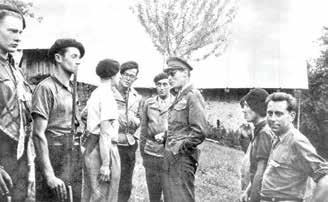
As the United States was preparing to fight the Axis powers on several fronts during World War II, it became apparent that an intelligence network would be needed for a wide variety of missions. In 1942, the Office of Strategic Services (OSS) was formed after President Franklin Roosevelt tasked World War I hero and Wall Street lawyer William Donovan to head the agency. Donavan recruited several people who, in turn, looked for unique individuals who could perform dangerous missions behind enemy lines. The OSS’s most highly decorated member was a marine who had previously served overseas for a foreign country for five years. Peter J. Ortiz was not an ordinary marine, and he used his knowledge and background to become one of the OSS’s most valuable agents in Europe.
Born in 1913 in New York City, Pierre Julien Ortiz (he later went by the name Peter) was sent to France for school. The adventurous young man traveled to Algeria and when he was nineteen joined the French Foreign Legion. His father wasn’t pleased with his son’s enlistment and went to North Africa to try and get his son out of the army. However, he was impressed with the Legion and soon became one of its big supporters. His son had joined the 1 st Regiment and ex-
celled during operations and underwent parachute training. Peter soon became the Legion’s youngest non-commission officer and was awarded several medals including the Croix de Guerre. After five years in the army, Peter returned to his family in La Jolla, California.
World War II broke out in September 1939, but the United States didn’t join the war until December 1941 after the Japanese bombed Pearl Harbor. Ortiz knew that if could make it to Europe he would be able to rejoin the French Foreign Legion, but the trip wouldn’t be easy. He made his way to Canada to board a Europe-bound ship, but it was torpedoed by a German U-boat. Finally, he found passage on a French destroyer that made it to Europe, and he was sent to fight in the North African Desert with the Free French Army that was fighting together with the British Eighth Army.
For the next two years, Ortiz fought in Africa and was given a battlefield commission with the rank of second lieutenant. Wounded while trying to blow up a fuel dump, Ortiz stayed on the front lines. He was captured after the Germans overran his position and was sent to Austria as a prisoner of war. He eventually escaped and made his way to the U.S. via Portugal. Ortiz finally was able to rest and recover from his wounds,
but the respite wouldn’t last long. It was June 1942, and the U.S. was gearing up for a bitter struggle on multiple fronts. Ortiz decided to enlist in the marines after being rejected by the army due to his wounds. During training at Parris Island, Ortiz excelled and was commissioned as an officer after just a few weeks in the marines. Ortiz’s military background, knowledge of North Africa and his fluency of multiple languages hadn’t gone unnoticed and led to his recruitment into the intelligence units. After more parachute training, Ortiz was sent back to North Africa and was only one of a few American marines to have served in the North African or European theaters. Tasked with leading Arab tribesmen on scouting missions, he gathered vital intelligence on the Germans and sent it back to headquarters. Ortiz was captured by American troops after their landing during Operation Torch in November 1942 and was held until he convinced the officer that he was actually an American marine. After recovering from more wounds he received in North Africa, Ortiz was recruited into the OSS and prepared for operations in France. In January 1944, he parachuted into France with a Frenchmen and a British officer with the mission of evaluating French resistance
and to train Maquis fighters. One night he was at a café and overheard Germans talking about their disdain of the Maquis and the Americans. Ortiz heard enough, went over to them and showed them two pistols while wearing his Marine uniform. The Germans couldn’t believe their ears when he made them toast President Roosevelt and the Marine Corps! Ortiz then managed to leave the café before slipping away in the night.
In addition to these tasks, he also assisted downed Allied airmen reach safety. He had helped four British airmen reach Spain and soon was helping the survivors of an American aircraft.
A B-24 Liberator heavy bomber had been hit by enemy fire and went down over France on May 5, 1944. All of the occupants safely ejected, including Jewish pilot Murray Simon and bombardier John Mead. Mead was credited with helping two dazed crewmen in the plane put on parachutes and safely exit the doomed aircraft. Only after the rest of the crew had jumped did Mead leave the plane. For his actions on May 5, he was awarded the Silver Star. Mead was rescued by local partisans and soon was taken in by SOE (Special Operations Executive, the British underground agency) operative Robert Lyon. Instead of being sent back to England, Mead

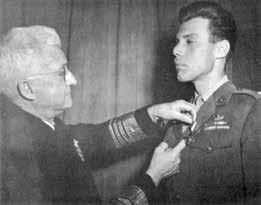
stayed in France and joined the underground. He was awarded another Silver Star for his gallantry in action while leading several operations against the enemy and for preparing for the American invasion of France.
The pilot, Murray Simon, parachuted out of the burning Liberator bomber but almost didn’t reach the ground. His parachute had gotten stuck on a tree, but soon he was cut loose. For the next week, he was sent place to place by the underground until he met Peter Ortiz. After telling him the dangers of trying to escape to England, both Ortiz and Simon drove in a stolen SS car and then took trains and trekked through Spain until they reached Gibraltar. Murray finally arrived back in England and was able to send a message back to his parents who had previously received notice that he was missing in action. Simon wrote to his worried parents, “I am well and safe. No need for worry. Write to my old address.”
Ortiz parachuted back into France in August 1944, but two weeks later he and his men were trapped by the Ger -

mans. After a firefight, Ortiz was faced with a difficult situation. Even though he knew that if he was captured the Germans would torture him since there was a large bounty on his head, Ortiz decided to give up and negotiated with the Germans to spare them retribution. Ortiz tried several times to escape on the journey to a POW camp and tried a few more times when reaching their destination. He managed to escape in April 1945, only to return once he found out that the prisoners had for the most part taken control of the camp.
These are just some of the exploits of one of the OSS’s most fearless underground agents. Operatives like Ortiz performed clandestine and covert activities that helped rescue the world from fascism, and their bravery will never be forgotten.
Avi Heiligman is a weekly contributor to The Jewish Home. He welcomes your comments and suggestions for future columns and can be reached at aviheiligman@gmail.com.

DU N DURT
Power & Soft Washing
We clean siding, stucco, decks, driveways, concrete, pool patios, pavers & sidewalks. Say goodbye to grime, mold & allergens! Call/WhatsApp: 718-688-2964 Email: dundurtny01@gmail.com
VACUUM SALES AND REPAIR
All areas call Max Flam 718-444-4904
THE LEATHER SHOPPE
The spot for all your custom leather Judaica. Tallis/tefillin bags, lulav and esrog bags, havdallah sets, challah covers, shtenders, pesach sets, matzah/afikomen bags. WhatsApp: (732) 523-0007 or email: theleathershoppe732@gmail.com for a full catalog. We ship.
PEACEFUL PRESENCE STUDIO
Men’s private yoga, Licensed Massage & Holistic Health Guidance 436 Central Ave, Cedarhurst Info. & free video training www.peacefulpresence.com 516-371-3715
DIAL-A SUB-LEGENDARY & experienced teachers available for emergencies. Substitutes teaching all subjects.
$180 per day. Payment a must before entering a class. Please call (516) 265-4872
GERBER MOVING
Full Service Moving Packing Moving Supplies
Local Long Distance. Licensed Insured 1000’S Of Happy Customers Call Shalom 347-276-7422
HANDYMAN AVAILABLE
For big or small jobs, Sheetrock, carpentry, painting, electrical, plumbing, install & repair appliances Call Ephraim at 347-593-4691
MANAGEMENT STAFF WILL ASSIST
you with:
* Obtaining Medicaid and Pooled Income Trust
* In-home Assessments, Individual and Family Counseling
* Securing reliable home care assistance
* Case and Care Management services Dr. S. Sasson, DSW, LCSW (718) 544- 0870 or (646) 284-6242
Traveling EMT
For school trips & Shabbatons, hotels, all social events. last summer was sold out! Make reservations early! Please call (516) 265-4872
HAIR COURSE:
Learn how to wash & style hair & wigs. Hair and wig cutting, wedding styling Private lessons or in a group Call Chaya 718-715-9009
ZEVIZZ WOODTURNING JUDAICA
Challah knifes, batei mezuzah, besamim holder, kiddish cups, havdalah candle holders, yad for sefer torah, pens, stenders, bowls and more 952-356-2228
MY MOTTO IS DON’T WAIT TO buy real estate
Buy real estate and wait Your realtor for life 516-784-0856 Alexandra at Realty Connect USA
PRIVATE DRIVER AVAILABLE For all your needs. Reliable. Safe. Experienced and Trustworthy Call Yaakov 917-825-7057
REAL ESTATE MANAGEMENT Services – Do Not Manage Your Properties Alone! Contact Aliyah Suites for all your real estate management needs and affordable office space near you! (516) 366-1049 Management@aliyahsuites.com Marc Jeret (MJ) Team Leader & Licensed Real Estate Agent
DEERFIELD BEACH FLORIDA 1 bedroom 1 and 1/2 bath corner unit 1st floor - lake view 5 minute walk to Shul Call Ms Marylynn Charnas for details 917-912-0021






















CEDARHURST
Prime Restaurant Location For Lease.
For more information: Call/Text/WhatsApp Owner: (516) 206-1100
5 TOWNS - OFFICES FOR LEASE 250SF to 500SF Offices in Inwood & Cedarhurst Utilities, Internet & Parking incl. with some Kosher kitchen - Minyan Next to LIRR - No broker fee Call/text/Whatsapp: 516-206-1100
Don’t Get Stuck With a Two Story House Ya Know, It’s One Story Before You Buy It But a Second Story After You Own It!
Call Dov Herman For An Accurate Unbiased Home Inspection InfraredTermite Inspection
Full Report All Included NYC 718-INSPECT
Long Island 516-INSPECT www.nyinspect.com
ZAREINU
Is seeking a Co-Rebbe position for this year for a sixth and seventh grade boys class in a local Yeshiva. Great pay! Warm environment with administrative support!
E-mail resume: info@zareinu.org or call 718-406-8343 ext 229
ZAREINU
Is seeking an assistant Rebbe position for this year for a sixth and seventh grade boys class in a local Yeshiva. Great pay! Warm environment with administrative support!
E-mail resume: info@zareinu.org or call 718-406-8343 ext 229
DELIVERY PERSON NEEDED to deliver this Newspaper every Thursday morning to locations in Brooklyn. Must have Mini van or SUVand availability to work Consistently every week. Good pay - Please email gabe@fivetownsjewishhome.com or call (917) 299-8082

REGENTS EXPERT
Tutoring regents in Algebra and Geometry A Darchei Torah instructor. Guaranteed results Text 347-491-8045 WhatsApp 347-767-1755
SEEKING ELEMENTARY TEACHERS and assistants for General Studies for the ‘25-’26 year. Assistants should have skills to take over for teachers if needed. Far Rockaway area boys’ school, M-Th, PM hours, strong support. Excellent salary. Send resume to teachersearch11@gmail.com.

ZAREINU
Is seeking a Co-teacher position for this year for a seventh and eighth grade girls class in the 5 Towns M-TH 2:00-4:30 & Friday 8:15-12:45. Great pay! Warm environment with administrative support! Email resume: info@zareinu.org or call 718-406-8343 ext 229
YESHIVAT KOL YAAKOV
In Great Neck, NY, is seeking general studies teachers for both the elementary and middle schools, for the upcoming academic year. Mon-Thur afternoons. Competitive salary, warm and supportive environment. Send resume to m.kalati@kolyaakov.org
MDS REGIONAL NURSE
5 Towns area Nursing Home management office seeking a Regional/Corporate level MDS Nurse to work in our office. Must be an RN. Regional experience preferred. 2-3 years MDS experience with good computer skills required. Position is Full Time but Part Time can be considered. Great Shomer Shabbos environment with some remote options as well. Email: officejob2019@gmail.com
A multi-tasker needed for general office work. The ideal candidate is someone who is detail-oriented, responsible, and can take ownership. Looking for someone who is eager to learn, and expand his/her skill set while possessing the ability to work independently and as part of a team. Experience with Excel required. Five Towns location. In-office position only, not remote. Please send resume to 5tpart.timecareer@gmail.com
A Five Towns Real Estate Company is seeking a full-time Bookkeeper. The right candidate must be proficient with QuickBooks and Excel. They must also be self-motivated, organized, detail oriented, reliable, and able to work independently or as a team player. Warm, frum office environment with excellent salary & benefits. Please email resume to HR@capsprop.com

HASHAVAS AVEIDA
Apple airpods found on Wednesday morning on the way to the Woodmere dock. To claim, 516-351-8105.
Text 516-303-3868 with a time slot of your choice to be careful on lashon hara. Be a part of the 1,000 people for klal yisroel!
BEIS HAMEDRASH CONG.
Chasdei Uvois Oshpitzin
Talmidei chachomim are willing to learn mishnayos, say kaddish and be the shliach tzibbur to daven for the umid on the yartzeit yom hashanah of your parents or close relatives or loved ones To arrange please call Rabbi Miller 917-445-6220
























By Rivki D. Rosenwald Esq., LMFT, CLC, SDS
What’s with breathwork and somatics? What’s with all these alternative ways of opening us up?
There’s also CBT and DBT and TMS … and the letters go on and on.
What happened to good, old-fashioned ABC? Why can’t we just use our words to talk things out?
Actually, all these new and enhanced methods can be worthwhile.
There are advances in almost everything these days.
It doesn’t mean the old ways get rejected or thrown out, necessarily. The new is often rather an enrichment, an enhancement that adds layers.
Just think of a good, old-fashioned chocolate cake, obviously not a hard thought for anyone. Now add layers to it. What’s bad about that? We can even graduate to a large, tiered cake.


Or how about going wild and thinking “trifle,” which is multilayered with a variety of ingredients all thrown in. It’s all combined to make a rich and fulfilling experience.
That’s the advancements in therapeutic growth and methodologies.
After all, we can all be open to trying different flavors and tastes at times.
And on the flip side, it’s true that some ingredients in general blend better together than others. So we can pick and
these days on the sidewalks or streets or almost being attacked head on by one coming at you?!
That’s certainly a blast from the past. We don’t need to reject progress even when it’s simply bringing back something that still has merit or is newly appreciated.
We can embrace and be open to the fact that lots of different ways of doing things speak to different people. Also, that different things work for different
We can embrace and be open to the fact that lots of different ways of doing things speak to different people.
choose what we want to try or be directed to what’s worthwhile trying for us.
So, too, in the world of self-advancement and growth. Certain things work for one population, while others do for another. That’s nothing new. And a lot can work across a wide population.
That’s like ice cream, for example. That has almost universal appeal.
Just think: we live in a world where new features are added to computers and phones. And new features are added to cars and dashboards. Even new means of travel are continuously introduced. Actually, along with old ones that are being re-introduced! For example, who isn’t tripping over a scooter
people. And we don’t need to move away from what has good, old-fashioned dependability, either.
So let’s take a deep cleansing breath… And bless the existence of, and access to, healthy progress in all things.
Rivki Rosenwald is a Licensed Marriage & Family Therapist working with both couples and individuals and is a certified relationship counselor. Rivki is a co-founder and creator of an effective Parent Management of Adolescent Years Program. She can be contacted at 917-705-2004 or at rivkirosenwald@gmail.com.

